Tag: Visual edit |
|||
| Line 1,447: | Line 1,447: | ||
=== Turkey joins the Revisionists: Erdogan vs Europe === |
=== Turkey joins the Revisionists: Erdogan vs Europe === |
||
| − | Mexico wasn‘t the only nation joining the Revisionist Powers in late 2026 due to ongoing conflicts with western countries. Tensions in the Eastern Mediterranean kept escalating, after the forced influx of tens of thousands of refugees coming from Turkey to Greece and Bulgaria, while turkish and greek security forces clashed with each other through the greco-turkish border. Due to the continuously rising tensions with the west following its exclusion from NATO, Turkey intensified its naval presence in the waters around Cyprus and several greek islands, in order to secure turkish maritime claims and natural resources. As a result, greek, french and british warships engaged in various standoffs with turkish vessels, while the turkish airforce conducted mock attacks on allied ships. After coming increasingly close to each other, turkish and western soldiers harassed each other, by using water hoses and shots in the air to disperse the vessels of the opposing side. |
+ | Mexico wasn‘t the only nation joining the Revisionist Powers in late 2026 due to ongoing conflicts with western countries. Tensions in the Eastern Mediterranean kept escalating, after the forced influx of tens of thousands of refugees coming from Turkey to Greece and Bulgaria, while turkish and greek security forces clashed with each other through the greco-turkish border. Due to the continuously rising tensions with the west following its exclusion from NATO, Turkey intensified its naval presence in the waters around Cyprus and several greek islands, in order to secure turkish maritime claims and natural resources. As a result, greek, french and british warships engaged in various standoffs with turkish vessels, while the turkish airforce conducted mock attacks on allied ships. After coming increasingly close to each other, turkish and western soldiers harassed each other, by using water hoses and shots in the air to disperse the vessels of the opposing side. |
| + | [[File:C7AD10F0-C2A8-4621-A2B3-0BA90E44CFBF.jpeg|thumb|220x220px|Turkish naval vessels close to Cyprus. |
||
| + | Sqource: GreekCityTimes |
||
| + | ]] |
||
| + | During these standoffs, several greek ships close to Cyprus and Crete were rammed by turkish vessels, prompting exchanges of fire. Almost immediately after, turkish naval units actively attacked greek and french ships, leading to hundreds of allied casualties. The turkish airforce was also deployed, and buzzed several allied planes, while pursuing the greek navy, leading to near-clashes between each sides airforce as well. Turkish dictator Erdogan blamed the recent escalation on Greece and the Allies, and vowed to defend turkish interests with all means necessary. The Allies on the other hand condemned the turkish aggression, and made an ultimatum, which called for a complete retreat of turkish naval forces from officially greek and cypriot waters. Turkey rejected the ultimatum, and declared that it will never give in to allied demands, which it called „fascist and imperialist“ intentions. As a result of the escalation, Greece mobilized a large portion of its troops and sent them close to the border, as a show of force. The europeans AUF also intended to increase greek defences in the south, which was why the allied european command deployed several anti-air batteries, anti-ship missiles and artillery pieces to Greece, which were supposed to be deployed on greek islands off the coast of Turkey. When the news broke about allied weaponry arriving in Greece, Turkey saw itself forced to take preemptive action, which lead to turkish troops entering greek territory in several locations of the Evros river, where they occupied river islands and small chunks of greek territory. |
||
== 2027 == |
== 2027 == |
||
Revision as of 22:45, 12 August 2020
World War III (often abbreviated to WWIII or WW3), also known as the Third World War, the „Final War“ , the "War to End all Peace", or the "Impossible War", was a global war that lasted from 2021 to 2028 and ended the so called "Long Peace" of the „Pax Americana“.
The vast majority of the worlds nations -among them all nuclear powers- eventually formed two opposing alliances: the Allies and the Revisionist Powers. In a state of total war, more than almost 3 Billion people from over 60 nations were mobilized, making WW3 the largest war in human history, surpassing its predecessor, WW2. With fighting occurring on every continent, including small operations against satellite stations in Antarctica, WW3 was also the most widespread war in history. The main participants threw their entire economic, industrial, and scientific capabilities behind the war effort, blurring the line between civilian and military resources. The Third World War was the deadliest conflict in the history of mankind, marked by 150 to 200 Million casualties, including the victims of various war crimes, like the Uyghur and Kurdish genocides, the ethnic cleansing of shias and sunnis , the carpet bombing of the Gaza strip, the massacres against the crimean tatarians, kashmiri muslims and indians, israelis, tibetans and taiwanese, and many more. Millions more died in the years after the war, due to famine, disease, follow-up conflicts or the long term effects of nuclear and chemical warfare.
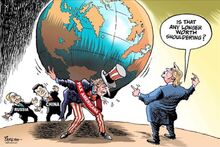
Political Cartoon from the pre-war era.
The war was marked by the extensive use of ballistic and cruise missiles, automated weapon systems, cyber-warfare and the use of chemical and nuclear weapons of mass destruction. It was seen as the result of the Second Cold War (2014-2021), sino-russian expansionism, neo-imperialism, globalization, the Korea Crisis, the Venezuela Crisis , the proxy wars in the Middle East between Saudi Arabia and Iran, the economic crisis caused by the Covid-19 pandemic 2020, as well as US foreign policy under Donald J. Trump.
The Beligerents
The Allies
The Allies of WW3 were a western based Alliance of some of the most powerful nations in the World, including the majority of the nuclear powers at that time. It was mainly composed by the members of NATO, the Saudi lead arab coalition, Israel, the asian powerhouses of India, Japan and South Korea, as well as Australia and New Zealand, while later on many nations in Africa, and in both South and Central America joined as well. This alliance included most of the worlds liberal democracies, that's why many allies shared a common set of fundamental values. This shared ideological basis received massive cracks though, since the alliance also included iliberal democracies, and even authoritarian regimes like Saudi Arabia. Many allied nations also experienced a democratic backsliding due to the global rise of authoritharism and anti-liberalism in the years before the war. This undermined the unity of the Allies and lead to the struggle the alliance had for keeping up with the Revisionist Powers. The inofficial leader of the Allies were the US under the administration of Donald J. Trump, who prolonged his term as a president by postponing elections as a result of emergency laws following the invasion of the Aleutians in 2024.
North America: The United States of America were the main global hegemon of this time period, but struggled to maintain its status due to the rise of China and a resurgent Russia, leading to the tensions that caused WW3 in the first place. Under the administration of Donald J. Trump, America saw a period of deep political division and the erosion of various fundamental political norms, while becoming increasingly anti-globalist and isolationist.

45th US president Donald J. Trump
Trump, who who openly endorsed authoritarians worldwide, whilst boosting right-wing and conservative movements in the US and Europe, showed a more aggressive and erratic behaviour against US allies out of his "America First" policy, effectivly weakening NATO in the process. The US under Trump also withdrew from various international institutions and agreements, or cut their funding for them, like the Paris climate agreement, the Iran nuclear deal, NAFTA, the INF treaty, UNESCO, the UN migration pact, the Open Skies Treaty, the WHO during the Covid-19 pandemic, the New Start Treaty and many more. Trump also engaged in various trade wars, not only against US adversaries like China, and nations like Mexico, but also US allies like Japan, Canada and Europe, calling the latter a foe of America.
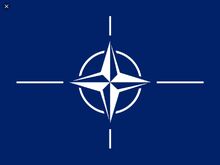
Official flag of Nato
After the Mueller Investigation didn't find enough evidence for collusion between the Trump-campaign of 2016 and Russia, and an impeachment attempt failed at the end of January 2020 , the republican president managed to strengthen his base to the point that he was re-elected later the same year. This increased the rift in the american society and encouraged Trump to follow an even more aggressive and anti-liberal policy that lead to a very hostile climate against democrats, liberals and the media, causing a rise of not only Right-Wing, but also Left-Wing extremism in the US. Due to the republican dominated Senate, a shift of balance of the Supreme Court towards the conservative side, and unquestioned support of millions of his followers, the US president managed to rule America in a style close to pseudo-authoritarianism, allowing him to protect his political allies, marginalizing his enemies, while also being free of almost all consequences. Trump also retrieved a lot of US forces from around the world, in what was later dubbed the „Great Retreat“, because he deemed overseas deployments as undesirable if the respective nations doesn't pay America for stationing troops inside their borders. This lead the US to pull out troops from Syria, Korea, Iraq, Afghanistan and in parts even Europe, weakening Americas positions as soon as the war broke out. Trumps aggressive behaviour against his Allies and adversaries alike , supported by his large base, also lead to an increased global rise of anti-american sentiment. During the war, America was the main driving force behind the allied war effort, while following its own agenda. While initially engaging in North Korea to stop the nuclear threat of the Kim regime , the US later explained their war effort as a mean to prevent chinese, iranian and russian aggression, which threatend Americas strategic, economic and military dominance. Trump, following his "America First" policy, planned to utilize the war to crush any econonomic challengers of the US, while cementing its status as the worlds strongest superpower.
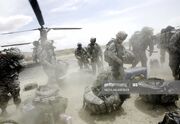
US soldiers embarking from a helicopter. America used to have the most powerful military in the world before WW3. Source: Getty Images
During the course of the war, Trump and his subordinates even indirectly colluded with Americas enemy Russia in order to reach their ambitions, meaning Trump knowingly neglected his european Allies in their fight against Russia, hoping that Putin would crush the EU as an econonomic rival, while the US could focus on defeating China and Iran. Many american soldiers on the other hand saw this war as a battle to protect the world against the ambitions of the Revisionist Powers for remodeling it in their authoritharian image. They firmly stood for their country, while some of the younger newly drafted recruits openly criticized Trump for his lack of strategy and committment for Americas allies and values. Trumps plan failed, and since he overfocused his forces on the Eastern Front, the US suffered horrendous casualties, due to the large armies that were concentrated in comperatively small areas of harsh terrain. Also, the US overrstreched their forces on multiple fronts around the world, which dispersed Americas strength as a whole. This lead the US to lose half of all its troops it send into the war, while also losing its most important military assets. America managed to achieve a marginal victory along with its Allies by pushing China as the last Revisionist Power towards an armistice. This came after Europe consolidated and restructured itself independently from the US, which forced the russians out of allied territory, and pushed them out of the war. The result was a devastated America, that lost much of its military and econonomic strength, while also losing its most important partners after the intention of Trumps neglection of his european allies became public. The resulting turmoil lead to the destabilisation of the US and ultimately the Second American Civil War.
Canada under Justin Trudeau joined the War as a NATO member after canadian troops were attacked following the russian invasion of the Baltics. During the course of the war, Canada proved to be commited to the alliance and supported the europeans in Scandinavia and Poland against the Revisionist Powers. Canada was also the main ally who supported the US against the russian invasion of the Aleutian Islands, Greenland, and in the battle against Mexico in the last phase of the war. Greenland on the other hand became involved in the war after the american Thule-base on its territory was bombed by russian submarines, later followed by a brief russian invasion of the island.
Europe: The Allies of Europe mostly joined the war out of their NATO alliance with america, as well as ideological and self-defensive reasons. The majority of the continent, most of which were members of the EU, became part of the Allies, except Switzerland, the european Micro-States and Ireland, as well as the Revisionist Powers of Belarus and Serbia.

Officia flag of the European Union
Many europeans who fought in the war saw it as a battle to protect freedom and democracy worldwide against the authoritarian influence of the Revisionist Powers and the threat of nuclear destruction, while also fighting for their political survival. While nations like Poland, the Baltics, Finnland and Norway joined to defend themselves from the russian invasion, others hesitated to do so. France and the United Kingdom proved to be the only allies in Europe who were able to effectivly support the US outside the continent, although Spain, Portugal, Italy and Germany were able to give minor support to the North Africa Front. Both the UK and France joined as the first european nations the allied coalition of the US, due to their close political ties with America, their own conflicts with revisionist states and their own strategic interests.
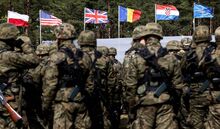
European NATO-soldiers along their american counterparts. Source: Getty Images
Germany, although being the econonomic powerhouse of Europe, as well as a central political and military figure, was more of a liability for the Allies, due to the terrible state of its army and the anti-war sentiment of its population. It joined the war reluctantly, due to the attack on german troops in the Baltics, Germanys NATO membership and the russian assault on its territory, which forced the germans to act. During the course of the war Germany managed to partially compensate for that by bringing in increased effort in the development of new weapons and taking a leading role in terms of coordination. Over the course of the conflict, Germany saw some form of remilitarization, which alongside diplomatic efforts, allowed Germany to further dominate Europe after the end of the war.The right-wing governments of Italy and Greece joined rather reluctantly despite of their NATO membership, since they were rather pro-russian, leading some populist leaders to collude with Russia and therefore slowing down allied aproaches.
The Balkans mostly joined in after Serbia sided with Russia and therefore brought the conflict to their region as well.The conservative nations of Hungary under the authoritarian regime of Viktor Orban, the Czech Republic and traditional pro-russian states Bulgaria and North Macedonia went further than just staying neutral and refused to activley support their Nato-allies, leading them to only allow passive access to NATO-facilities and bases inside their countries. Bulgaria on the other hand joined in on the war effort against Turkey, only after being attacked and invaded by turkish forces. As soon as the turks were pushed back, Bulgaria remained passive again.
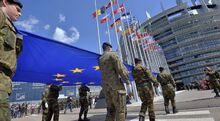
European soldiers in Brussels during a ceremony. Source: Getty Images
Austria joined the Allies as well during the final phase of the war, and supported its european partners against the last russian strongholds on the Western Front and Turkey, after the turkish Invasion of Greece, due to Austrias own tense relationship with Turkey and Russia in the years before the war. In the caucasus, both Georgia and Azerbaijan sided with the Allies as well. Georgia, which waged a short war against Russia at the beginning of the 2000s, and lost territories to it, hoped to regain control over the occupied areas , while Azerbaijan joined because of tensions with Armenia over the disputed region of Nagorno-Karabakh, as well as the fact that its troops were attacked by the Revisionist Powers in Afghanistan. Individuals like Orban, but also Mateo Salvini from Italy, Marine Le Pen from France, and various members of the German AfD party even activley advocated for peace in russian favor, since they saw Russias state model as preferable. This lack of unity, as well as years of massive military underfunding, lead the european allies to suffer heavy casualties, while inching close to the brink of collapse. Only after the realisation that the US won't activley save them, the Allies reorganized themselves in Europe and turned their armies into one coordinated force, pushing the Russians back into their own territory and forcing them out of the war, without the exchange of nuclear strikes. Therefore, WW3 lead to the reemergence of Europe as a military superpower on a more global stage.
Middle East: The Allies of the Middle East were mostly the members of the GCC and its military arm, the Peninsula Shield Force , except Quatar, and were dragged into the war by Saudi Arabia, an arch nemesis of Iran and competitor for religious and regional dominace. Saudi Arabia saw this war as the opportunity to destroy Iran as a rival and to establish a regional hegemony of its wahabist regime with the help of the US. Saudi Arabia went as far as to use Sunni terror groups in order to attack civillian structures inside revisionist territory, leading to many civillian casualties far away from the battlefields. Saudi Arabia, under the de facto rule of crownprince Muhammed bin Salman, also engaged in the ethnic cleansing of Shias throughout his nation an conquered areas, therefore leading many war crimes to be associated with the Allies, creating a rift between its co-belligerents. The turkish dictatorship under Recep Tayip Erdogan was also part of the Allies for most of the war, although it already had severe anti-western sentiments and illiberal tendencies before the conflict, which lead to many western citizens to be taken as hostages to pressure Turkeys political will. Since the Allies followed a desperate apeasement policy for Turkey, Erdogan managed to collaborate with the Revisionist Powers without much hinderence, in order to destroy kurdish forces and minorities, which ultimately escalated into the kurdish genocide. This was one of the main reasons for Turkey to be pushed out of the alliance, along the betrayal of turkish troops against their allied counterparts during the Qatar campaign 2025.
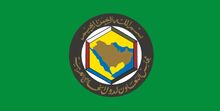
Official Flag of the Gulf Cooperation Council, and its military arm, the Peninsula Shield Force (2019). Most of its members became part of the Allies. Source: https://en.m.wikipedia.org/wiki/Gulf_Cooperation_Council#/media/File%3AGCC_Flag.svg
Other important members of the Allies in the Middle East, that joined the war because of their own tensions with Iran, Or Saudi pressure, were the U. A. E,Jordan, Egypt and Israel, which was not an official member of the Saudi coalition. Israel was one of the most effective and supportive partners of the western allies, while following its own agenda against its arch nemesis Iran, with which it already waged multiple proxy wars and even direct confrontations before and after the Syria War. Israels war goals were the destruction of the iranian nuclear program, as a mean to prevent Iran from aquiring nuclear weapons, and the end of iranian anti-israeli operations in the Middle East. Israel was also the only ally in the Middle East that supported the West against the russian airforce. Israel engaged in a more independant war with Palestine as well, after the Hamas pledged alliance to the Revisionist Powers. The following conflict lead to countless civillian victims on both sides and ultimately the carpet bombing of the Gaza strip, after massacres against israeli civillians in settlements of the West Bank. Kuwait joined after being invaded by Iran in 2021, while Bahrain and Oman joined a few years later, after iranian forces were defeated in the gulf. Cyprus allowed allied troops to use its bases since the beginning of the war, but wasn't a full member of the Allies until the turkish invasion and partial occupation in 2026. The puppet government in Yemen associated itself with the saudi coalition , in opposition of the iranian backed houthi rebels. Since the country was on the brink of the collapse after years of famine created by the saudi lead blockade in the wake of the Yemen war, the role of Yemen in WW3 was rather marginal.
Asia: Since the asian theater of WW3 was one of the most central fronts of the war, the Allies in Asia, most of them being part of ASEAN, proved to play a significant role for the allied war effort. The main Allies on the Eastern Front were Japan, South Korea, Taiwan and India. South Korea was the first nation to join the Allies, after it became the target of north korean aggression, which lead to the beginning of the Second Korea War, and therefore the spark of WW3. Japan was also one of the first Allies of the conflict, while also being a traditional US partner and economic powerhouse of East Asia. Japan was also engaged in decades of tensions with China, due to chinese territorial claims, their shared history in WW2 and their rivalry for regional dominance. Japan was also one of the allied nations that became partially occupied by the Revisionist Powers. Taiwan was a long year US ally, and source for tensions between the west and China, since China claimed Taiwan to be its rightful territory. Taiwan joined the Allies after being attacked and invaded by China in the first year of the war. Despite heavy resistance, Taiwan was occupied by China for most of the war, and saw terrible massacres against its population in the name of the "reunification of China".
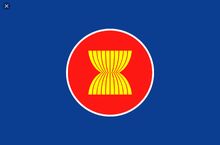
Official flag of ASEAN
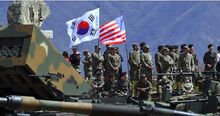
US and South Korean troops during a joint exercise. South Korea was the first nation to join the Allies in Asia. Source: Getty Images
India was the main challenger in asia for Chinas rise as a superpower, while also engaging in territorial disputes with the Peoples Republic. India was originally a member of the SCO and BRICS and stayed neutral in the first year of the war. After both its arch-rivals China and Pakistan joined forces against the west, India broke with said organisations and joined the Allies, leading to the opening of another land front against China in the himalayan mountains and Pakistan along their shared borders. The reason for that was Indias opposition of chinese regional dominance, as well as its long dispute with Pakistan over the Kashmir region and transnational terrorism. India allowed the US and Australia to send troops in its territory as reinforcement, and brought in massive amounts of manpower as well as further nuclear advantage for the Allies. Bhutan and Myanmar joined the Allies after being invaded by China as an attempt to encircle India, while Vietnam joined after its denial for joining the Revisionist Powers by Chinas demand. Malyasia, Brunei and Singapore joined after Indonesia became part of the Revisionist Powers, while they also suffered econonomically due to Chinas war with the west. After being overwhelmed by the Allies, Indonesia switched sides and also joined the alliance. The Phillipines also became part of the Allies due to its traditional partnership and mutual defence treaty with the US, but under authoritarian leader Duterte, it also colluded with China in order to prevent being directly attacked by the Middle Kingdom. Thailand also joined due the economic damage it suffered from Chinas actions, as well as its defence partnership with the US. Thailand was also caught in the crossfire of the fighting between the Allies and Revisionist Powers in Southeast Asia, forcing it to join one side.
Australia and Oceania: As members of the ANZUS alliance with the United States, both Australia and New Zealand joined the Allies and supported the allied war effort on the Eastern Front against the Revisionist Powers, while later on sending troops to Europe in the final battles of the Western Front. Both nations not only brought in manpower and political support, they also allowed the US to use their territories as bases to build up forces against China and its Allies, even though New Zealand seemed to be rather reluctant to do so, due to its opposition of US nuclear capable assets in the southern hemisphere.
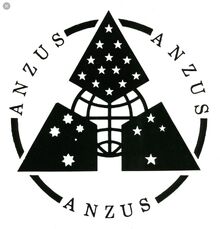
Former flag of ANZUS. Source: flickr.com
Papua New Guinea joined the Allies against Indondesia after being caught in the crossfire, as well as its own conflict with its neighbour over territorial and ethnic tensions in West Papua, while many micro-states in the Pacific, like Guam, East Timor, Samoa, American Samoa and various others mostly joined because they either officially belonged to the territory of other allied nations, like the US, UK and France, or they became the direct or indirect target of revisionist aggression.
Africa: Africa remained neutral throughout most of the war, but became target of revisionist operations against allied ressources and troops stationed there. After Algeria and Libyas government joined the Revisionist Powers in opposition of the West, both Morocco and Tunesia joined the Allies as major non-NATO partners, in order to protect Gibraltar and the Mediterranian, while also relieving pressure from Egypt. Morocco also engaged in the war because of its re-inflamed dispute with Algeria over Western-Saharah. Lybian forces under the lead of warlord Haftar also heavily operated under allied supervision, since Haftar enjoyed massive support from the Saudi coalition and even France. The sub-saharan nations of Mali, Niger and Chad came under attack by the Revisionist Powers for hosting allied troops and their ressources, therefore joining the Allies out of self-protection. South Sudan joined the Allies after its neighbours became part of the Revisionist Powers, among those Sudan, with which South Sudan had a history of bloody conflicts. Kenya, Liberia, Côte d' Ivoire, Nigeria and Ethiopia later joined in order to stop the fighting in Africa and because of their strong connection and partial dependance with and on the West.
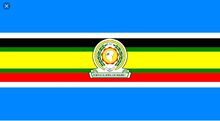
Official flag of the East African Union
Uganda became part of the Allies due to its political and economic connection with the US and Britain. Uganda was also a member of the EAU, which joined together in East Africa in order to stop Sudan, the C.A. R. and the D.R.Kongo, leading this alliance to become an important part of the Allies in Africa. Rwanda and Burundi also teamed up with the Allies against the D.R.Congo, because of their shared history with one another and Uganda, that already was one of the Allies. Tanzania joined the Allies because of its close ties with Uganda as well, and later supported South Africa against Mozambique. South Africa broke with the BRICS and joined the Allies for econonomic reasons and its historical ties with Britain, although the main reason for South Africas engagement was the intention to prevent the fighting in Africa from spreading. Namibia was pressured by South Africa to join the Allies, in order to open a front against Angola. Overall, Africa saw massive destruction of human-, and wildlife, while local conflicts lasted even until the war already ended. Due to the hundreds of thousands killed in the battles, and the destruction of infrastructrure , WW3 contributed to the spread of diseases throughout the continent, while many endangered species were brought to the brink of extinction. The war effort brought in by Africa also lead to the acknowledgement of many african nations as more equal political partners for the West, therefore strengthening Africas political weight in the world.
South and Latin America: South America, like Africa, remained neutral for most of the war, and was the last continent to be entangled in the fighting. The continent became involved in the Third World War after Venezuela under the rule of Nicolas Maduro, with the support of Cuba, waged war against the United States. The majority of american Allies in South and central America were members of the anti-Maduro Lima-Group, which advocated against Maduros rule in the years before the war, as well as the Rio Pact
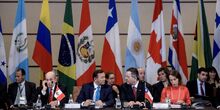
Diplomats of the Rio-Pact discussing the Venezuela-Crisis. Source: Getty Images
, with the sole exeption of Ecuador. Colombia and Brazil were the first south american nations to join the Allies, with the intention to overthrow Maduro and stop the war from further spreading, which ultimately failed. Brazil was also interested in stopping the flow of venezuelan refugees into its nation, while hoping to gain economically and politically from a brazillian-american cooperation. After Bolivia, and later Uruguay joined the Revisionist Powers, the majority of the remaining continent, who were members of the OAS, sided with the Allies to put an end to the war in South America,among those were Argentina, Chile, Peru, Paraguay and Ecuador. Argentina, and several other latin american nations also joined because of increased terrorist activity that was sponsored by Iran as a form of asymmetric warfare against the west.
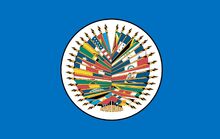
The official Flag of the Organisation of American States (2019). Its members made up the majority of Allies in the Americas. Source: https://en.m.wikipedia.org/wiki/Organization_of_American_States#/media/File%3AFlag_of_the_Organization_of_American_States.svg
In The Carribean, many island states, like Haiti, the Dom.Republic, Trinidad and Tobago, the Virgin Islands, Curaçao, Puerto Rico and many more also joined the allied cause due to them being part of allied territory, as well as cuban and venezuelan aggression in the carribean sea. After Nicaragua, El Salvador and later Mexico sided with the Revisionist Powers, the majority of Central America joined the Allies in order to stop the war from further escalating. These nations were among the last to join the alliance at all.
The Revisionist Powers
The Revisionist Powers were a loose alliance of anti-western nations, many of which were members of the SCO and CSTO, and were aspiring to end Americas global hegemony, in order to reshape the worlds power structure in their favor. The most central members of this authoritarian, eastern based entente of illiberal democracies, authoritarian regimes and dictatorships were the Peoples Republic of China and the Russian Federation. Both were the main challengers for US dominace throughout the world, although Russia tried to reestablish itself as a superpower after the collapse of the Soviet Union, while China desired to rise in this rank for the first time as well. Both regimes were engaged in the Second Cold War against the West (2014-2021), which included territorial demands and expansion , nuclear and hypersonic arms races after the collapse of the INF treaty in 2019, as well as cyber and information warfare. China and Russia also used military force to fulfill their ambitions, which was seen in the Crimea annexation and the chinese militarization of the South China Sea.
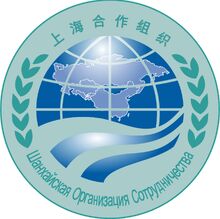
The Official logo of the Shanghai Cooperation Organisation, a Main part of the Revisionist Powers, except India (2019). Source: https://en.m.wikipedia.org/wiki/Shanghai_Cooperation_Organisation#/media/File%3AShanghai_Cooperation_Organisation_(logo).svg
These nations were joined by various illiberal states and dictatorships, like North Korea under the rule of Dictator Kim Jong Un, the mullah regime of Iran, Syria under dictator Baschar al Assad, Pakistan, Belarus, Hizbolah controlled Lebanon, Iraq and the central asian republics that were part of the Soviet Union. This loose alliance was later additioned by many nations in Southeast Asia, Africa, Latin America and even Europe, like Serbia, D.R.C., Venezuela under dictator Nicolas Maduro, Cuba, Bolivia, Sudan, Zimbabwe and many more, including former NATO member Turkey under the dictatorship of Erdogan. Most of these nations shared a rather opportunistic connection with each other, instead of joined values or ethics. The main aspect that united these authoritarian regimes was the opposition of western global dominance and the perception of the US as a threat. The Revisionist Powers were the first ones to use chemical and nuclear weapons in the war, and are generally believed to be responsible for the majority of war crimes commited during the conflict.
Asia: The main Revisionist Power in Asia was the Peoples Republic of China, which strived for becoming the new global superpower at Americas expense. China posessed the largest army in the world in terms of manpower, and ranked as Nr. 3 of the worlds most powerful nations overall. Under the reign of Xi Jinping, China witnessed an era of militarization and increased global power. With its "Belt and Road Initiative", China managed to gain influence throughout the world, while using debts to enforce its will on smaller nations. China also dreamed about teritorial expansion, including claims for the South China Sea, the japanese Senkaku and Sushima Islands, Taiwan, Hong Kong, as well as parts of India. China, alongside Russia was the main driving force behind the Revisionist Powers, and was responsible for many war crimes in Southeast Asia. It managed to conquer many of its claimed territories, but struggled to hold these after years of allied blockades and intense fighting in difficult terrain. The allied blockades, and the tens of thousands of chinese casualties lead to civil unrest that was struck down with brute force. The bloody actions of the communist party against its people lead to a drastic loss of support for Xi Jinping and weakend Chinas unity, which was originally fueled by massive nationalism. The ongoing domestic unrest inside China, as well as Russia being pushed out of the war, lead to a chinese retreat on all fronts and the invasion of China with the help of tibetan freedom fighters, as well as Uyghur rebels, which were heavily persecuted by China, with the Uighurs being internalized and ultimately killed in so called "Reeducation-Camps".
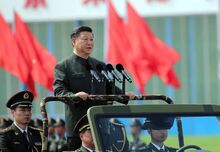
Chinese leader Xi Jinping. Source: Getty Images
These factors lead to the collapse of Chinas communist party, and forced the chinese army to seek for an armistice with the Allies. The Armistice of Taipeh lead to the full liberation of chinese occupied territory, including Tibet, which was under chinese control for multiple decades. Chinas first ally was the nuclear armed north korean dictatorship under Kim Jong Un. North Korea was a isolated hermit state, that engaged in severe tensions with its neighbours and the US over its nuclear program, threatening America and its allies with nuclear destruction multiple times. Although tensions eased after the Singapore Summit 2018, where Donald Trump negotiated a vague deal with the Kim regime for denuclearization of the korean peninsula, without explicit conditions, the conflict was reignited after the Hanoi summit of 2019 brought no progress. De-nuclearization talks in the months after collapsed, causing North Korea to stop negotiations with the US at the end of 2019. The following tensions lead to new aggressive actions of the hermit state, which ultimately caused the provocative missile launch that lead to the US attack in 2021. North Korea was pushed back in the beginning of the war, and was only able to hold of against the Allies because of chinese, russian and mongolian support. After the allied advance at the end of the war, Kim Jong Un resorted to nuclear weapons use, as the second Revisionist Power after Pakistan, which caused China and Russia to abandon Kim as an ally. This lead to the collapse of the Kim dynasty, the north korean army command and ultimately the fall and death of Kim Jong Un himself.
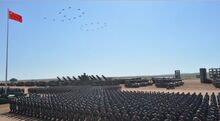
Chinese forces during a Military maneuver. Source: Getty Images
Other asian nations joined the revisionist cause as well, either because they hoped to econonomically benefit from China, or they were pressured to engage in order to retain their independence. Laos and Nepal were pressured to join the Revisionist Powers, despite their already pro-chinese stand, and obeyed in order to prevent being annexed or economically destroyed by China. Cambodia and Bangladesh, as well as Indonesia joined due to their respective conflicts with allied nations like India and Australia, and hoped to gain econonomically from a chinese advance. Mongolia , due to its close ties with China and Russia, and its geographic position, joined the Revisionist Powers rather reluctantly in oder to prevent being overrun by either power, and mainly supported the revisionist effort in Korea and Russias arctic campaigns against Alaska and Canada. Sri Lanka also joined the Revisionist Powers, due to its ties with China following the Belt and Road Initiative, as well as its own conflicts with India.
Europe: The dominant Revisionist Power in Europe was by far the Russian Federation under Vladimir Putin. Russia struggled to regain its status as a global superpower after the collapse of the Soviet Union, but saw an era of remilitarization under the rule of Putin. While the russian army was strengthened over the course of 2 decades, Russia engaged in several conflicts that saw the grab of territories by the Russian Federation in Georgia and Ukraine, which ultimately lead to the Second Cold War. As an attempt to undermine the West as a threat to Russias power position, the Federation engaged in various propaganda and disinformation campaigns, while also interfering with the democratic structures in the West, like the US presidential elections 2016.
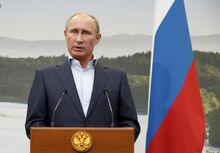
Russian president Vladimir Putin. Source: Getty Images
Russia also supported right-wing populist movements throughout Europe following the Refugee Crisis of 2015 as an attempt to destabilize the unity of the EU, which was quite successful, considering the pro russian positions of various right-wing dominated european countries. As a result, Russia enjoyed a lot of sympathy among anti-liberal groups and even managed to achieve a rather positive view among Trump supporters in America, Russias main adversary, who rather concentrated their interests on China, since Russias strongman politics, and anti-migrant positions were considerd favorable among conservatives around the world. This ultimately lead to the indirect Trump-Russia collusion during the war, and right-wing cooperation with conservative european nations,that caused a lot of casualties and destruction in Europe, and by extension, the destabilisation of America when Trumps pro-russian strategy became public. Russia posessed the largest nuclear arsenal in the world, as well as the single most powerful nuclear devices, the soviet era Tsar Bomba, and the unmanned giant nuclear torpedo-drone "Poseidon". The Federation was also engaged in an arms race with the West, including increased development of hypersonic and nuclear weapons, which escalated after the collapse of the INF-Treaty in 2019. Russia legitimized its actions often because of eastern NATO expansion, by which it felt encircled, as well as the protection of ethnic russians in western territory. Russia also backed several authoritarian leaders around the globe, among them syrian dictator Baschar al Assad and venezuelan ruler Nicolas Maduro. Despite the fact that Russia and China used to engage in several border disputes and competed for influence and dominance worldwide with each other, both powers became much closer in the years before the war. Reason for that was that both were engaged in tensions with the West, more specifically the US, which was the worlds strongest superpower. In order to undermine western dominace, Russia and China increased their cooperation and ultimately joined forces, even though both nations tried to dominate each other during the course of the war. Russia had just a few fighting allies in Europe , since the majority of the continent was either a member of NATO or otherwise an american ally. The most important ally of Russia in Europe was therefore Belarus under dictator Lukashenko, who was a traditional pro-russian partner of the federation.
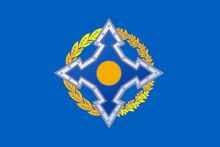
The official Symbol of the Collective Security Treaty Organization , one of the main parts of the Revisionist Powers (2019). Source: https://en.m.wikipedia.org/wiki/Collective_Security_Treaty_Organization#/media/File%3AFlag_of_the_Collective_Security_Treaty_Organization.svg
Belarus was a member of the CSTO and former part of the Soviet Union, and had therefore strong ties with Russia, even though the belorussian population was increasingly sceptical about the relationship with Russia. Belarus joined nonetheless in order to prevent being annexed by Russia, and fought for the majority of the war on the side of the Revisionist Powers, while granting access to its territory and troops to Russia. Another important Revisionist Power in Europe was traditional russian ally Serbia , that joined the alliance because of its deep grudges against NATO after the Balkan-wars at the end of the 20th Century, as well as its conflict with western backed Kosovo and NATO member Albania. Armenia also reluctantly joined the Revisionist Powers, because of its CSTO membership, which lead to intense battles in the caucasus mountains against Georgia, Turkey and Azerbaijan, although it was also engaged with the latter in disputes over Nagorno-Karabakh. Besides actual allies, Russia enjoyed wide support by right-wing governments and populist movements throughout Europe and the United States.
Middle East: The main driving force behind the revisionist war effort in the Middle East was the shia dominated Mullah Regime of Iran. The islamist republic was engaged in a series of proxy wars against sunni lead Saudi Arabia for regional and religious dominance prior to WW3. Iran also clashed on numerous occasions with its other main adversary, Israel, which it seeked out to destroy for decades, since Iran wasn't acknowledging Israels right to exist as a nation. Another reason for tensions in the region was the conflict between Iran and the US, causing America to rally iranian adversaries under the lead of Saudi Arabia in the Middle East together, in an attempt to stop iranian anti-american ambitions. One reason for this confrontation was Irans nuclear programm, since it was accused of using it as a way to develop nuclear weapons, which especially concerned Israel. Iran negogiated a deal with the West to ease the tensions surrounding its nuclear programm, while also hoping that sanctions would be lifted.
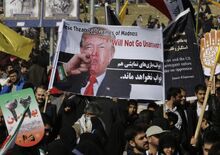
Anti-american iranian protestors. Source: Getty Images
The deal was unilaterally abandonend by the US after the election of Donald Trump, which lead to increased hostile rhetoric between Iran and the US , as well as american Allies in the Middle East. Tensions boiled up in 2019, when multiple acts of sabotage and agression were conducted against oil tankers , refineries and pipelines at the Gulf and Saudi Arabia. The crisis culminated even in the downing of a US drone and new sanctions against Iran, while yet there were no military clashes between the two sides until the outbreak of WW3 due to Trumps strategy of bluffing. Sole exemption was the symbolic iranian missile strike during the flare up of tension at the beginning of 2020.Before the war, Iran supported various extremist groups throughout the entire Region, including Hamas, Hizbolah and the Houthi Rebels in Yemen. The islamist Republic also supported syrian dictator Assad in the syrian Civil War, which lead to direct clashes between Iran and syrias neighbour Israel. Iran was one of the first Revisionist Powers to join, and one of the last to leave the war, following Irans military defeat and the collapse of the mullah Regime in 2027.
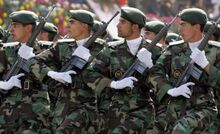
Iranian Military. Source: Getty Images.
Iran also was the only Revisionist Power , aside from Turkey, that tried to acquire nuclear weapons during the course of WW3, but this attempt failed due to Irans downfall before it could assemble sophisticated nuclear devices. Due to its close ties with both Iran and Russia as its main allies , Syria under the rule of Baschar al Assad joined the Revisionist Powers right from the beginning, when syrian forces were caught in the crossfire of the clashes between western and russian air forces. Syria was entangled in a brutal civil war, that escalated in a proxy war between various regional and global powers. As a result, Syria saw the rise of multiple terror groups, the use of chemical weapons and the biggest refugee crisis of the 21 th century until WW3. Shortly before the war broke out, Assad managed to regain control of most of his territory he lost to syrian rebels and islamist groups, thanks to the support of Russia and Iran. Syria, which was accused of using poison gas multiple times in the civil war, was also the first Revisionist Power to use chemical weapons on the Southern Front, later additioned by Iran and Iraq as well. This encouraged the saudi coalition to use these substances as well, causing a chemical arms race in the Middle East similar to WW1. Another member that joined the Revisionist Powers in the Middle East more or less right from the beginning was Lebanon, which was dominated by the iranian backed Shia militia Hizbolah. Hizbolah pressured Lebanon to join the Revisionist Powers in support of Iran, as well as a consequence of israelilebanese tensions . Iraq became a member of the Revisionist Powers as well after it was invaded by Saudi Arabia, and besieged allied bases in its territory, while taking american troops as prisoners. Both Iran and Iraq became much closer in the years before WW3 due to shia supported uprisings, leading iranian backed extremist groups and political shia -parties to operate in Iraq,which caused also hightened tensions with Israel. Iraq even voted to expel american and other foreign troops from its territory, leading to souring relationships between Iraq and theUS under Trump. The Palestinian territories joined the revisionist cause too, after the radical and iranian backed Hamas pledged alliance to the Revisionist Powers, which lead to new battles between Israel and the Hamas. Palestinian extremists and Hamas killed several hundreds of israeli citizens, including the massacre against civillians in Jerusalem and the West Bank settlements. This massacres lead to the carpet bombing of the Gaza Strip, which killed three quarters of its total population. At the end, all of Palestine was conquered and only regained its previous status due to allied pressure and revisionist threats against Israel.
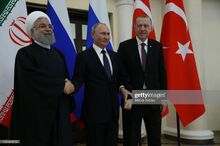
The main actors of the Middle Eastern Front: iranian leader Hassan Ruhani, russian president Vladimir Putin, and turkish dictator Recep Tayip Erdogan. Source: Getty Images.
Quatar joined the alliance after the saudi invasion in 2025 due to its close ties with Iran and its tensions with Saudi Arabia, which organized a blockade against the gulf state because of its connections to Iran and various terror groups. Turkey became a official Revisionist Power after being kicked out of NATO because of its collaboration with Russia and Iran, the Kurdish Genocide and the betrayal of turkish troops during the Quatar and North Africa campaigns, where turkish forces stationed in the gulf state and Libya turned against their allies and attacked them to protect Qatar and the Tripoli government. Following the switch of sides, Turkey attacked not only Greece, but also Cyprus and allied troops in the south after the defeat of Syria and Iraq. Turkey then was overwhelmed by an allied coalition from Europe, the US, Australia, New Zealand, Israel, India and the saudi lead coalition and ultimately came under allied occupation, similar to Nazi-Germany after WW2. Before its downfall, Turkey even tried to obtain nuclear weapons of its own, causing it to attempt using the fissile matter of the seized nuclear bombs in Incirlik, leading to the only nuclear strike against Turkey.After all, the Middle East saw one third of its entire population killed in WW3.
South and Central Asia: The central asian republics and former soviet states of Tajikistan, Kazachstan, Kyrgyztan, and Uzbekistan joined the Revisionist Powers reluctantly, due to their SCO and CSTO membership, in order to prevent being annexed by either China or Russia. As a result, these nations granted the Revisionist Powers access to their territories, while also allowing them to forcefully conscript troops from the central asian republics, that were send to fight at the Western Front, the Afghanistan Front and the Indian Front.
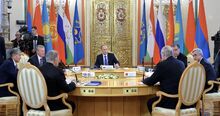
CSTO members during a meeting in Moscow. Source: Getty Images
Pakistan joined the Revisionist Powers because of its SCO Alliance and otherwise close partnership with China. Pakistan also developed a more anti-US stand, after american accusations of Pakistan supporting terrorists, which also lead Pakistan to accuse the US to encourage indian aggression in the wake of the Kashmir conflict 2019. After the Afghanistan campaign, Pakistan engaged in a long and brutal fight with India, since tensions between those two nuclear powers were quite high after the Kashmir crisis of 2019. Despite support from the forced conscripts of central Asia, Pakistan was steadily pushed back, until it resorted as the first fighting nation of the entire war to nuclear weapons use. Following Indias response, Pakistan was nonetheless overwhelmed and became the first nuclear power to leave the war defeated.
Africa: Both China and Russia managed in the years before WW3 to increase their influence in Africa. Russia was one of the biggest weapons salesmen on the continent and kept close relationships with many authoritarian rulers throughout Africa, while China was able to pressure its will on many und african nations through investments and a sytems of state debts. Through these methods, China and Russia were able to convince the regimes of Sudan, the D.R.Kongo and Zimbabwe to join the revisionists cause and pressured them to attack and sabotage western troops and econonomic ressources in their neighbouring countries, in order to weaken the allied war effort later in the war.
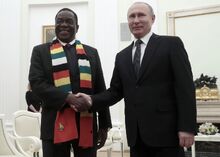
Vladimir Putin Meeting the president of Zimbabwe. Source: AFP
When as a result more and more african nations joined the Allies, other pro-russian and chinese states started to side with the Revisionist Powers, among them the C.A.R., Angola, and later on Mozambique, Madagascar, Burkina Faso, Benin, Ghana, Guinea, Somalia, Eritrea and Botswana. Algeria and Libya under the rule of the anti- Haftar government in Tripoli joined earlier as well, due to their partnership with Russia and their respective conflicts with western states like France and the US. Western Saharah became involved too because of the territorial dispute between Algeria and allied Morocco. Due to the large population in Africa, and revisionist warfare that explicitly targeted civillian life, the war actions in Africa started by the Revisionist Powers lead to almost 2 million casualties alone. The african theater was also the only during WW3 that saw some kind of biological warfare, in form of revisionist troops in equatorial Africa and Madagascar using corpses of Ebola and Plague victims as natural carriers for biological weapons by placing them in allied territory or water supplies as an effort to stop the enemies advance. While this lead to a new larger Ebola outbreak, in Madagascar the spread of the Plague could be contained not only due to allied efforts, but also chinese and russian one, since those distanced themselves from their now rogue allies on the african Island.
Latin America: In South and Central America, as well as the Carribean, the main nations to join the Revisionist Powers were the biggest members of ALBA, the socialist regimes of Venezuela, Cuba, Bolivia and Nicaragua, later addioned by Suriname, Uruguay, El Salvador , the bolivarian islands of St. Vincent and the Grenadines, Dominica and ultimately Mexico.

Official logo of AlBA (2019) . Its biggest members were the core of the Revisionist Powers in Latin America. Source: https://en.m.wikipedia.org/wiki/ALBA#/media/File%3AEmblem_of_the_Bolivarian_Alliance_for_the_Americas.svg
Venezuela joined because of its partnership with Russia and China, which was the reason for Venezuela, that was already on the brink of collapse due to years of hyperinflation and sanctions, to suffer massively under allied blockades of revisionist goods. Venezuela also was engaged in high tensions with the US, which increased after venezuelan dictator Nicolas Maduro accused the US to have organized an attempted coup by opposition leader Guaido in 2019. As a result, Venezuela, with its socialits allies Nicaragua and Cuba, attacked and seized allied ships as an attempt to break, or at least compensate for the blockade. When the US declared war against them, Venezuela and Cuba attacked and occupied several teritories in the Carribean among them Jamaika, the ABC islands, Trinidad and Tobago, Puerto Rico and many more, in order to exploit their ressources, and to use them as fortifications against incoming allied attacks. On the height of their occupation campaign, cuban and venezuelan air forces , supported by russian bombers managed to perform a hit and run raid against Miami and the Florida Keys, which was, despite being pushed back after just a day, the second time american mainland territory was attacked in WW3, after the russian campaign against Alaska and the Aleutians. When Venezuela and Cuba suffered massive allied attacks, Bolivia joined the Revisionist Powers as well in support of its fellow socialist comrades, which ultimately caused the rest of the continent to be entangled in the war as well. Uruguay joined due to tensions with right wing lead Brazil under Bolsanaro and the rather pro-Maduro stand of Uruguays leading party. El Salvador joined in in support of Nicaragua, while Mexico became part of the Revisionist Powers after it also suffered under the years of both allied and revisionist blockades, targeting the respective other side, but it decided to join the Revisionist Powers because of american anti-mexican policies under the administration of Trump, which lead to multiple racist attacks against Mexico when it protested Americas blockades against mexican trade partners.
Oceania: Indonesia and its islands aside, the only partner the Revisionist Powers had in Oceania were Fiji and Vanuatu. Fiji declared its support for China due to increased strategic engagement of the Middle Kingdom in Fiji, and the Pacific overall,which lead Fiji to allow stray chinese vessels to dock on its territory for smaller repairs. Vanuatu built a base for chinese naval assets, and therefore became indirectly a Revisionist Power. Aside from that, Oceania wasn't of much significance for the main Revisionist Powers.
Non-State Participants
The two major alliances aside that fought against each other, WW3 also saw the increased war effort of various groups and organisations, that tried to influence the war on their behalf. The big international organisations like NATO, the UN, the EU, SCO, CSTO, GCC, ALBA, OAS, EAS, ANZUS etc. aside, most of the non-state groups that tried to benefit from the war were islamic terrorist groups, although many of which were supported by either side in order to use them to their advantage. Among these extremist militias were Hamas, Hizbolah, the Taliban, Al-Quaida, Al-Shabaab, Boko Haram, Al-Nusra, ISIS and many more. ISIS only played an insignificant role at the beginning of the war, since its state sponsors focused their ressources at the war effort against their respective enemies, while ISIS was also overrun by the large armies charging against each other. The same happend to most of the smaller militias, except Hizbolah, the Taliban and Hamas, leading international islamic terrorism to largely vanish as a result of the war.
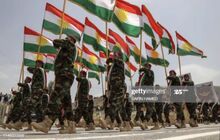
Fighters of the kurdish Peschmerga. Source: Getty Images
The kurdish terror group PKK also engaged in the war, due to its ongoing conflict with Turkey, which worsenend after Erdogans rise to dictatorial power. The kurdish militias of YPG, SDF and the Peschmerga joined in as well, as a result of turkish aggression against kurdish territories, which ultimately lead to the Kurdish Genocide. Although all of these kurdish groups were associated with the Revisionist Powers, due to Turkey being a part of the Allies for most of the war, they coordinated themselves more with the allied war effort, after Turkey became a Revisionist Power. Other non-state participants that engaged in WW3 were various rebel-groups, like the pro-russian Donbass rebels, the pro-turkish FSA against Assad, the pro iranian Houthi-Rebels in Yemen, the uyghur and ghurka rebels in China and tibetan freedom fighters, who helped liberate Tibet with the support of the Allies at the end of the war. Ireland, which remained neutral throughout the war, saw the resurgence of the "New IRA", that was engaged in several hostilities in the wake of Brexit in the years prior to WW3. This militant group was encouraged by the Revisionist Powers to conduct several anti-british attacks on the irish island, with focus on Nothern Ireland. This lead to civil war like uprisings, that forced the UK to partially focus its attention to its own territory, slowing down the british advance at the Western Front.
2021
The Outbreak: The Second Korea War
Following the collapse of the Singapore agreement between the US and North Korea after the Hanoi summit in 2019, and the failed negotiations in Stockholm in october the same year, tensions between the two sides started to escalate until July 2021. Before that, US president Trump experienced a huge political success by being reelected in 2020. Since the Mueller investigation did not prove Trump to be guilty of collusion with Russia, and an impeachment attempt started in fall 2019 failed, the US president felt encouraged in his "America First" policy, supported by millions of his followers, which lead him to increase his attacks against traditional US-allies out of a isolationist and anti-globalist standpoint. The dictatorship of North Korea started to rebuild faciIlties which were associated with its nuclear and missile program, while also reinitiating missile launches of short distances in May 2019 onwards, forcing US president Donald J. Trump to increase the pressure on the dictatorship in the years after in order to not appear weak in front of both his critics and supporters alike .
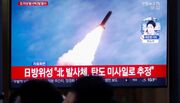
North korean missile launch. Source: Reuters
Reason for that was that Trump followed a pattern of threats of military action that always proved to be empty, since he prefered to back down last minute on multiple occasions, like the Korea Crisis of 2017, the Venezuela Crisis after 2019, the Iran Crisis of summer 2019 and January 2020. This lead to harsh criticism from the oppositional democrats, who condemned Trumps rhetoric, while his foreign adversaries saw this behaviour as a proof of US weakness , leading to more aggressive political approaches from nations like Russia, Iran and China. As a result of this pattern, Trump stationed a carrier group in the waters around the Korean Peninsula as a show of force in June 2021 , even though he halted several joint US-South Korea drills in 2019 and after. This caused increased hostile behaviour from the north korean regime, which already completly froze any negotiations with the US at the end of 2019 and suspended talks with US during the election period in 2020. After months of aggressive rhetoric exchanges between the US and North Korea, which was paused during the Covid-19 pandemic, the dictatorship of Kim Jong Un reintroduced medium and long range missile tests as a provocation, believing Trump would never retaliate, leading to new sanctions and threats from the american side. World War III is generally said to have begun on the 4th July 2021, (the centenary of the foundation of Chinas communist party), with the US missile strike against north korean facilities following a provocative missile launch from the north korean regime under Kim Jong Un, which was mistakenly thought to be a direct attack against US carrier groups stationed in korean waters. At the same day, the chinese Peoples Liberation Army conducted a series of massive combat drills as a show of force during the centenary, which was the reason why China severely increased its military presence and activities in the South China Sea, the Strait of Taiwan, as well as the East China Sea. These chinese drills were also one reason why the regime of Kim Jong Un saw itself compelled to test the US‘ resolve by launching a missile, since it expected the US navy to be too distracted by the chinese naval exercises. Russian vessels also participated in these drills in the South China Sea, in order to demonstrate the growing sino-russian partnership aimed at opposing the american lead western world order.
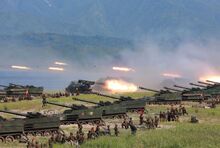
North korean artillery bombardment. Source: Getty Images
The result of the strike was the beginning of the Second Korean War though, with the United States of America, South Korea, Japan and Great Britain on one side, and North Korea on the other. After the missile attack of the US, which was intended to be a "bloody-nose-strike", north korean anti-ship batteries started to fire against US vessels, forcing those, alongside the american airforce to conduct several retaliation strikes against the north korean coastline.North Korean troops then started to shell Seoul with hundreds of rockets and artillery pieces, while firing missiles at american naval assets and bases in South Korea and Japan. South korean and japanese THAAD and Patriot systems were able to intercept some of the missiles, but the majority of them did hit their targets, inflicting damage to the US forces in the region, as well as killing more civilians.This lead South Korea and Japan to intervene against North Korea, which meant sending in troops to stop a possible invasion of the DMZ. Nations all over the world declared their worries about this escalation, with both China and Russia blaming the US for starting the conflict, while the UK, Australia and other US allied nations condemned North Korea for its attacks against the south and Japan. In Europe, fears grew that this might escalate into a larger, potentially global conflict, leading several nations like Germany to declare their neutrality and non-desire to get involved, while the UK prepared troops to be sent to Korea after a few days of heated arguments inside the parliament. Nations from Europe and Asia called for a diplomatic solution to the conflict, with Austria and Switzerland offering to mediate between North Korea and America. The US on the other hand denounced any criticism of its actions, and instead demanded total support of its Allies.
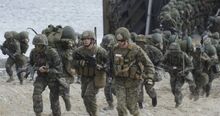
Debarking US troops in South Korea. Source: AP
On the ground in Asia, south korean forces were mostly left on their own to fight, since the US still tried to contain hostllities as much as possible, leaving the bulk of the fighting to South Korea. American 2nd and 25th infantry divisions arrived as the earliest US reinforcements of the war though, accompanied by two american marine regiments. Because of the artillery bombardement of densely populated Seoul, thousands of south korean people died in the first few days, even though North Korea deployed not every artillery piece it could in this area, in order to cope with upcoming counterattacks. South Korea started to move troops from the South towards the border, but Kims forces were able to strike before enough reinforcements could arrive in time. North korean ground troops crossed the DMZ and successfully broke through the center of the south korean lines in front of Seoul. The fresh US reinforcements advanced from the south, allowing the Allies to stop the north korean approach by establishing a second line of defense along the Bukhan river. The war focus of North Korea then shifted towards Seoul, which already saw a massive build up from forces of both sides. Congestion started to slow down the concentration of troops from the North though, allowing south korean and american forces along the Bukhan River to prevent further north korean progress. Allied ships on their way were heavily attacked by north korean missile forces helped by radar systems stationed in the mountains along the north korean coastline. North Korea tried to hit as many ships, planes and bases as possible, knowing the enemy would take time to assemble considerable forces for an invasion.
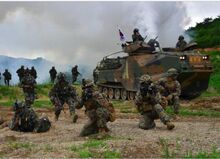
US and South Korean troops engaging in action. Source: Getty Images
Yet, south korean and american planes managed to perform a huge amount of successful incursions and sorties into North Korea through their nearby bases and carriers, hunting down missile launch platforms and bases. Since South Korea still remained under extreme pressure from the North, the US shifted the 82nd Airborne Division from Poland to Seoul, where they immediately engaged in heavy fighting as soon as they arrived. The People's Republic of China, and later the Russian Federation, tried to intervene by blocking allied navy assets on their way to the Korean Peninsula. China, which was already engaged in a trade war and arms race with America, wanted to prevent a unified Korea under US supervision, with american troops directly at China's border. Chinese frigates around the Spratly islands , joined by several russian ships that conducted naval maneuvers with their chinese counterparts as a signal against the west, played chicken with the US Navy, when the american naval assets stationed in the South China Sea where called to the korean Peninsula as well . Tensions in the region started to increase heavily, with both sides executing further daring maneuvers, while the Chinese navy tried to deny access to the East China Sea for its american counterparts. As the result, both sides came continously closer to each other, with neither one of them willing to back down. A american carrier then sliced through a chinese frigate, after it came extremely close in an attempt to deny passage for the US ships. The frigate sunk, with all passengers on board drowning. China, under lifetime leader Xi Jinping, demanded an apology from the US, as well as reparations, which the US refused to do, saying this was the result of provocative chinese actions.
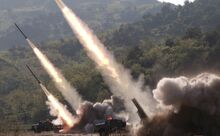
North korean rocket launchers in action. Source: Reuters
While the US ships pushed through towards Korea, China vowed to retaliate, and conducted several hacking attacks against american cyber infrastructure. The satellite surveillance station in Exmouth Australia registered a massive hacking operation against its systems, turning its screen black. The US accused China for the hacking and countered with its own cyber attack, which took out several local chinese servers. As a result, chinese jets flying from the Spratly Islands started to buzz the remaining US ships in the South China sea. When the chinese jets came dangerously close to the US ships, the american navy responded by downing a chinese aircraft, claiming it was about to attack the carrier group. China was outraged by this, demanding all american actions of war should be halted, while allied troops should leave Korea. Russia, whith several of its ships in the South China Sea being caught in the crossfire, also imposed a naval blockade against the Allies in the waters around Korea, the Phillipine Sea as well as the eastern Mediterranian around the Suez choke point , in support of China, while also protecting its Pacific Fleet base.
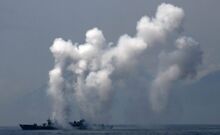
Chinese vessel after an explosion on sea. Source: Getty Images
The reason behind this was to prevent further escalation that could lead to nuclear weapons use, which would've also threatend southeast Russia. Just like in the South China sea, both sides engaged in provocative maneuvers, which lead US forces to demand free passage towards Korea. The russian navy ignored the demands and remained dangerously close to the opposing vessels, leading US ships to fire warning shots against russian frigates. These were seen as offensive actions, leading the russian navy to open fire on allied ships, while russian planes were buzzing US naval assets and aircraft. As a result, both sides where engaged in short exchanges of fire, leading several russian, but also american ships to be hit, with one russian frigate even sinking ,leading more than one hundred russian sailors to drown. The russian government under Vladimir Putin was outraged, threatening retaliation if the US is not backing down. After the Chinese ultimatum for total retreat of allied forces in Korea has been ignored, Xi Jinping declared war on the United States of America and their allies, leading the US to send almost all of its naval assets into the Pacific.
The war spills over
Russia did not declare war at first, but rather retaliated by attacking US naval assets in the Persian Gulf, the eastern Mediteranean and the Arabian Sea , in order to prevent further escalation at the Korean Front. While Chinas 79th and 80th armies entered the Korean peninsula to stop the allied advance into North Korea, both the US, now backed by french and british forces, exchanged clashes with the russian air force in the Middle East, following the retaliatory strike against US ships. Ship launched missiles and drones attacked russian military positions in Syria, including Russias Tartus naval base. Syrian and iranian soldiers were caught in the crossfire, leading both nations to threaten the US and its allies, if hostilities are not halted. Saudi Arabia on the other hand declared its unconditional support for the US, should Iran enter the war against America. In the meantime, Russia saw massive anti-american protests by russian nationalists, and after increasing numbers of casualties in Syria and the South China Sea, Vladimir Putin declared war on the United States, the United Kingdom, France, Japan and South Korea. He warned that if NATO entered the war in support of America, every participating nation will be met without mercy. The declaration of war was ironically meant as a method of de-escalation, since Putin anticipated that it would scare the US and its allies into a diplomatic approach and concessions, before the conflict would actually start. And despite multiple calls for peaceful solutions of several NATO members, the US declared that it won’t back down when being confronted on the battlefield, which lead Russia to prepare for war with not just America alone, but rather all of NATO.
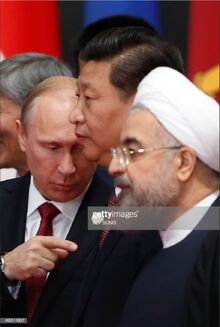
The main leaders of the later called Revisionist Powers: Russias Vladimir Putin, Chinas Xi Jinping and Irans Hassan Ruhani. Source: Ally Song/Getty Images
Both Russia and China declared their support for each other, despite mutual distrust. While russian forces entered Korea on Chinas side, NATO called for an emergency meeting in Brussels, in order to discuss the reaction to the escalation. In the meantime, hostilities in the Middle East continued to spiral out of control. More and more syrian and iranian casualties were counted because of the clashes between Russia and the West, which caused Iran to resort to a more aggressive approach itself, meaning a new harassment campaign against the US in the region. Iranian speedboats and other naval assets harassed american vessels in the gulf, in order to divert their attention from the syrian battlefield, hoping that this will push the US to slow down its military actions for the sake of avoiding a broader conflict with Iran. Iranian backed shia militias meanwhile conducted new attacks against the remaining US forces in the bases in and around Baghdad, leading to new air and drone strikes in Iraq against these iranian Proxies. This on the other hand caused new calls of the iraqi government for a US retreat, since Iraq didn’t want to become a battlefield itself, while Iraq itself saw the US presence as an occupation since the crisis of January 2020. During these attacks, dozens of US soldiers were injured, while five were even killed, since the militias were less hesitant to avoid casualties, due to the dynamic of the escalating tensions. Trump blamed Iran for this and proclaimed that the US will never give in against any enemy, no matter how many they are. US aircraft now specifically targeted iranian forces operating in Iraq and Syria, while increasing the aerial presence close to Iran. Iranian forces then fired missiles against american aircraft, accusing them of violating iranian airspace. The attacks missed their targets, but Trump, who showed less and less restraint the more the conflict escalated, authorized a missile strike against the anti-air batteries in question, leading to massive anti-american protests in Iran. And after a series of violent clashes between american and Iranian naval assets in the Persian Gulf, Iran and Syria declared war on the US, France and the UK. This lead to a Saudi ultimatum for complete removal of iranian forces from Syria, and when it was ignored, Saudi Arabia declared war against Iran and Syria. Jordan and the U.A.E. ,as members of the GCC ,were pressured by Saudi Arabia to join as well, while two days later, Israel and Egypt also joined on the allied side. When troops of the Saudi coalition entered Syria , it's neighbour Lebanon, dominated by the Hezbollah militia, sided with Iran and mobilized its troops against Israeli forces, after these violated lebanese airspace.Since the US pulled out its troops in Syria in 2019, the americans severely lacked in military presence in the region, leaving only a token force of 5800 soldiers on the Arabian Peninsula to counter russian and iranian forces. Saudi Arabia invaded Iraq with the goal of opening a land front into Iran, leading to a fierce iraqi ultimatum for a total halt of any foreign military action inside Iraq, while demanding the saudis to leave.
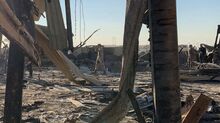
A US base near Baghdad, after being hit by iranian missiles. Source: Getty Images
The iraqi demands were largely ignored, with the saudi leadership noting that Iraq should join the GCC coalition in attacking Iran, since they had no intentions of stopping their invasion of Iraq. Iran offered Iraq to support it against the saudi invaders and their quote „imperialist and zionist backers“, and after several clashes between saudi forces and iraqi soldiers in the south of the country, Iraq agreed to a military cooperation with Iran. Iraqi troops besieged american bases and took US, british and french soldiers stationed in Iraq as prisoners , while more and more iranian forces crossed into Iraq to take position against the saudis in the south. Iranian troops also participated in the siege of the american Baghdad base, while additional attacks have been conducted against US installations in iraqi Kurdistan, drawing the attention of NATO member Turkey. Iran tried to gain momentum before the US and the arabian coalition could consolidate their forces, leading it to conduct missile strikes against american bases in Saudi Arabia, the UAE, Iraq, Syria and Kuwait, leaving only Oman unharmed at first. Iranian forces invading Kuwait were halted though, which lead Kuwait to join the allies as well. The only NATO member in the region, Turkey, under the de facto dictatorship of Recep Tayyip Erdogan, also entered this war by declaring war on Syria, with which Turkey was already unofficially at war since 2020, and Iraq, but refused to fight against russian and iranian forces. Instead, turkish officials met with an iranian and russian delegation in secret to negotiate a anti-western collaboration pact. Both sides agreed to not interfere with each other, and in exchange, Iran allowed Turkey to invade syrian and iraqi territories, in order to destroy kurdish forces and minorities in the region. Turkey also denied allied troops to use its NATO bases for attacks against russian targets, which increased the rifts inside the alliance.
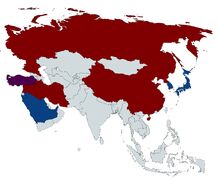
The initial flashpoints of the conflict
Meanwhile, representatives from Russia, China and Iran met in former Astana, Kazakhstan, and signed a cooperation pact, declaring their joined support in opposition to the United States, and its "imperialist " ambitions. Both China and Russia also pressured the members of the SCO and CSTO , as well as Mongolia, to join their cause, if NATO decides to interfere. NATO on the other hand declared its support for America, but hesitated to invoke its article 5. Instead, the UK and France prepared their troops to be sent into the Middle East and Korea to back the american war effort, while Poland and the Baltics are mobilizing their troops at their respective borders with Russia. This was then used to justify a full russian mobilization at the borders not only of the Baltics, but also Norway, Finland and Ukraine, alarming those states as well. Other important NATO members, like Germany, Italy, Greece and Spain remained rather hesitant, and declared only their logistical support for their fighting allies. Hungary, Czechia and Bulgaria neglected their allied duties, and rather declared to stay neutral due to their pro-russian leaderships. The NATO members in the Balkans, Portugal and Denmark also declared their neutrality, but agreed to passive support as well. In the meantime Russia send a regiment of multiple Tupolev Tu -160 Bombers, a transport plane and various long distance planes with around 100 russian soldiers to a new base in Venezuela, while Iran deployed multiple Sahand destroyers that were supposed to be stationed in Venezuela as a sign of support for venezuelan dictator Maduro against the US. Russia also deployed a couple of warships, like anti-submarine vessels and ships with helicopter flattops, so that its presence against the US in South America would be increased. After China entered the fight in Korea more aggressively, Americas carriers in the waters around the peninsula were forced to retreat beyond DF-21 and DF-26 range. Meanwhile, the Holy See of the Vatican state condemned the growing violence on the Asian Continent, and instead called for peace and humility for the sake of mankind.
Europe plunges into War: Russias Blitzkrieg
Both russian and baltic forces were mobilized at the closest distance possible between each other, leading the armies to meet almost face to face. Throughout the Baltics, ethnic russians, who claimed to be discriminated by their governments engaged in massive anti-NATO protests. These protests were tried to be disrupted by the government, leading to clashes between security forces and russian protesters. Russia exploited these protests, which were encouraged through russian disinformation campaigns, and said these were fascist acts against ethnic russians. Russia accused the Baltics and the West overall to opress russians within their territory, which according to the russian government would force Russia to intervene and "protect" its fellow citizens. Due to the massive tension between these forces, a series of border incidents occurred, for which both sides were blaming each other.
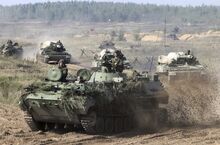
Russian tanks close to the borders of Poland and the Baltics. Source: NBC News
Estonian and latvian troops accused their russian counterparts of cutting through and demolish border fences along the frontier, leading to warning shots to be fired. Russian troops accused the baltic forces on the other hand of opening fire without warning across the border, while allegedly throwing rocks and tear gas grenades. Reports emerged about russian forces attempting to cross into Estonia and Latvia without military insignia, similar to how the Crimea invasion occurred in 2014, which was immediately rejected by the russian government, which called these allegations deliberate fake news campaigns. Despite russian claims of innocence, troops of Estonia and Latvia presented several russian nationals as prisoners, accusing them of seeping into baltic territory the same way russian troops did during Russias hybrid warfare campaign in Ukraine after the Euro-Maidan in 2014, prompting an aggressive reaction of the Putin administration. The Kreml accused the baltic nations again of oppressing russians and taking innocent russian nationals as prisoners for propaganda reasons. At the same time, more and more shootings were reported between baltic and russian troops , while simultaneously, the anti-western protests of ethnic russians became more violent, with even the first people being killed in these riots.
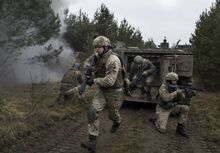
Lithuanian forces close to the capital of Vilnius. Source: AP
These incidents were used by the russian leadership to justify a full scale invasion of the Baltics, leading russian troops to cross into Estonia and Latvia. The first objectives of these invasions were the „neutralization“ of hostile forces along the border, while allegedly „protecting and liberating“ russians inside baltic territory. Russian troops engaged in heavy combat with the baltic defenders, who were facing retreat soon after the invasion began. It became apparent that Russia planed to overrunning the Baltics, in order to cut them off from NATO reinforcements, as a way of neutralizing the perceived threat NATO posed to Russia. The Kreml thought that a quick campaign against the Baltics, before the consolidation of NATO forces in the west, with a following occupation, would lead NATO to accept the Baltics being in Russia’s sphere of influence again, in order to avoid a larger conflict by attempting to retake them. When the first line of baltic defence was pushed back, NATO forces stationed in the Baltics assisted their allies in fighting back against the russian invaders, leading the british lead battalion in Estonia and the canadian lead battalion in Latvia to engage in the first fights against the russians. Belarus, under dictator Lukashenko, meanwhile reluctantly joined Russia as a CSTO member, in order to retain its independence and avoid being annexed itself. After being pushed into the war by Russia, Belarus mobilized its troops along its entire border with the Baltics, Poland and Ukraine, while granting Russia access to its territory and forces. Russia used Belarus to encircle and invade Lithuania, were it was met with heavy resistance of the already alerted and mobilized lithuanian army. During the invasion of Lithuania, russian troops also engaged in combat with the german lead battalion stationed there.
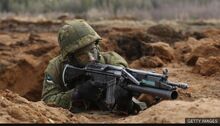
Estonian soldier in Eastern Europe. Source: Getty Images
Belarus also allowed russian troops to enter its territory so it could close the Suwalki gap between Poland, Lithuania and the russian exclave of Kaliningrad, and cut off the Baltics from possible NATO reinforcements. Poland declared its support for the Baltics, and started to shell both Kaliningrad and the belorussian border, leading Belarus to declare war on Poland. Meanwhile, russian troops also invaded Norway in order to protect the Northern Fleet base in Murmansk, while they also went into Finland. Russia justified this moves by declaring it did not expected Finland to remain completely neutral, leading to finnish forces to launch long range cruise missiles to strike St. Petersburg as an symbolic act of retaliation. And despite the majority of the missiles being either shot down or missing their targets, the resulting damage was enough to cause panic in the city, since this was the first time that St.Petersburg was attacked since WW2. Russian airborne units were dropped off all over the Peninsula, in order to cut off potential reinforcement routes to help the finnish. Polish troops desperately tried to prevent the Suwalki gap from being closed, but they were pushed back, due to russian missile and air strikes. The attack against Poland forced NATO to finally invoke its Article 5, leading Germany and other members to prepare the rapid reaction force they were obliged to send in. Meanwhile canadian troops stationed in the Baltics were almost completely destroyed, leading Canada to declare war on Russia. Both Canada and America declared their support for Europe,and prepared to send in more troops, although the US planned to send only the absolute minimum of manpower into Europe, because they wanted to focus on China at the now called Eastern Front.
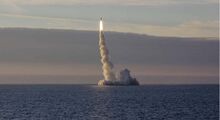
Submarine launched russian missile at dusk. Source: AsiaTimes
Before allied european troops could be transported to Poland, Russia conducted a so called "shock campaign" against Europe. They executed a series of air and missile strikes, hitting targets not only in Poland, but also Germany, Belgium, the Netherlands and Sweden. Among those targets were important NATO ports, airfields, infrastructure, bases, command headquarters, as well as the capitals of Berlin, Stockholm, Brussels and Amsterdam. The nation which was hit the most by this campaign, which was later nicknamed „The Long Night“, as a pop-culture reference to the popular TV show Games of Thrones, was Germany, because it harbored many important NATO and US bases, while being a very important crossroads for arriving allied reinforcements on their way to Poland. Among the german targets being hit were the US Army Europe Base in Wiesbaden, the american airforce headquarter in Europe of Ramstein, the NATO airbase Geilenkirchen, the NATO command of Ulm, as well as the Landstuhl Regional Medical Center. Other targets hit were the still freshly installed new EUCOM headquarters in Belgium, the ports of Antwerp, Kiel and La Rochelle, as well as Bucharest and missile defense sites in Romania.
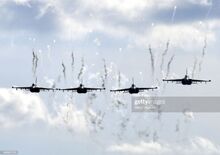
Russian aircraft conducting air assaults in Eastern Europe. Source: Getty Images
This attack was supposed to scare every nation that would want to join the allies from doing so, and even if they do nonetheless, the strike would've destroyed important NATO infrastructure, slowing down the enemies approach. This attack, especially against the neutral nations, created a wave of shock and outrage throughout Europe, due to more than 200 europeans and americans being killed in the process. Germany, which originally did not planned to actively engage besides the obligatory effort, was therefore forced to declare war against Russia, and so did Belgium, Sweden and the Netherlands as well. France and the UK condemned the attack,and declared their total support for their allies, leading them to fully mobilize their armies. Montenegro also declared war on Russia, and after days of hesitation due to their pro-russian right-wing governments, Italy and Greece joined as well, since the threat of their NATO bases becoming russian targets as well was too evident. The full engagement of NATO lead Russia and China to once again pressure the members of the SCO and CSTO to join their cause, that's why Uzbekistan, Kyrgyzstan, Tajikistan, Kazakhstan and Armenia reluctantly declared war on the US and its allies. Pakistan also joined the anti-western alliance that is now dubbed the Revisionist Powers by America, leading India to be the the only SCO member to remain neutral. Mongolia, wedged between both Russia and China, also declared war on the United States, in order to prevent from being annexed from either Power. Meanwhile, the european allies mobilized their armies to fight against Russia and Belarus in Poland and Scandinavia.
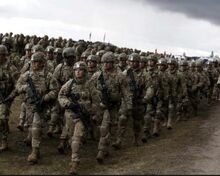
US troops deployed in Poland. Source: Reuters
The US armys 173 airborne brigade combat team in Italy, as well as the 2nd cavalry regiment in Germany then rushed to the fight in Poland, although their communication was severely jammed by russian electronic warfare units, forcing the americans to rely on rusty high frequency radio technology. Russia also tried to slow down the british supply line further by destroying the Eurotunnel with a submarine attack, leading to hundreds of civilian casualties. The NATO forces that were already arriving and fighting in Poland meanwhile lost over 60,000 men and women, leading to casualty rates similar to WW1. Polish troops were determined to hold as much ground as possible, therefore refusing to fall back to the main defense line of NATO. The american forces in Poland on the other hand were set back from the first lines of defense as some form of counterattacking force. Due to russian pressure though, the americans had to disperse all its divisions to assist its wavering allies. This lead to the so called Third Battle of Masurian Lakes/Tannenberg, during which the NATO commander employed the 10th Mountain division to help the poles. Further south, the 1st Calvary and the 1st Armored Divisions started an counterattack, leading to immense casualties beyond allied expectations. In the Baltics,
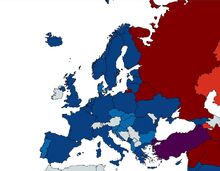
The Western Front 2021 (Edit: North Macedonia became a NATO member in 2020)
Russian troops reached the outskirts of the baltic capitals of Tallinn, Riga and Vilnius in just about 60 hours. The last baltic army resistance, supported by the remnants of the NATO forces that were stationed in the Baltics before the war as a deterrent, entrenched itself in urban territory as a last attempt to hold the line. In the rest of the occupied baltic territory, the population followed a strategy of "total defence", meaning that they formed smaller units of civil resistance, that inflicted damage on the invading enemies. Many ethnic russians on the other hand welcomed the invaders as "liberators" since Russia portrayed the baltic resistance as anti-russian and fascist hostilities, leading them, alongside other pro-russian forces, to sabotage the baltic resistance. Even though the total defence somewhat slowed down the russian approach, this strategy of civil resistance lead to heavy civillian casualties, since Russia activley targeted civillian areas out of anti-resistance warfare, which was used to justify heavy attacks without regard for civillian life. Overall, the Allies suffered horrendous casualties in a time-span of just 72 hours, losing about 50% of their present forces along the now called Western Front. Ukraine also mobilized its troops and send them into the Donbass, in expectation of a possible russian invasion. Ukrainian naval forces sailed into the Sea of Azov, while land forces were gathered at the borders to Crimea and Belarus. Russian forces started to shell ukrainian ports as a result of Ukraines naval provocations in the Sea of Azov, leading it to declare war on Russia, while also mounting an offensive to reclaim Crimea. But the ukrainian offensive failed, forcing it to abandon the Crimea campaign very quickly.
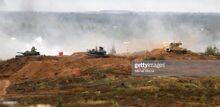
Russian tanks in action in what is now the Western Front. Source: Getty Images
After the Battle of the Sea of Azov, which resulted in total ukrainian defeat, eastern Ukraine was completely cut off from any supplies from the sea, while Russia started an invasion of the Donbass. They received support from the Donbass rebels from the self proclaimed republics of Luhansk and Donenzk, who fought on russian behalf against ukrainian forces for years, and with the full scale invasion of eastern Ukraine, president Wolodymyr Selenskyj had to retreat his troops back into central Ukraine, while also facing belorussian attacks in the northwest. While russian troops were able to take Mariupol and Kharkiv, the ukrainian resistance strengthend their defences by using the river Dnieper as a natural barricade, since the flat terrain of Ukraine made it almost impossible for the defenders to hold up against russian armoured formations. Russian bombers then targeted multiple of the many damms of the Dnieper, in order to reduce the reservoirs of water in preparation of crossing the river on their way towards Dnipro, Zaporozhye and the ukrainian capital of Kiev. The result was massive flooding in central and southern ukraine, that killed thousands of civillians. Ukrainian forces then dug in into the urban territory, leading to weeks of brutal urban trench warfare in multiple ukrainian cities. Meanwhile in the Caucasus, Georgia joined the allies, and started its own campaign to retake the territories of Abkhazia and South Ossetia, which were occupied by Russia since the Georgia War at the beginning of the 2000s. Armenia concentrated its forces on its border with Georgia, demanding the end of hostilities in the Caucasus mountains in favor of Russia. In the same time, Kyrgyzstan and Uzbekistan besieged the US bases in their territories, forcing american soldiers to surrender after two weeks, despite marginal support from the US air-force.
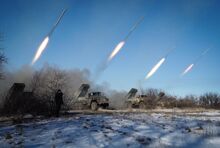
Rocket artillery attack in Eastern Ukraine. Source: Getty Images
In Europe, every attempt to break through to the Baltics failed, leading them to be completely overrun by Russia in just about two weeks of fighting. The russian National Guard was sent to counter any potential baltic insurgency, allowing more army units to participate in the ongoing offensives in the west. Russia then focused its movements on the west against Poland, where thousands of french, british, german, dutch and belgian troops arrived. In Scandinavia, the russian advance into Norway was halted at Alta with the help of british, swedish, finnish and the newly arrived canadian troops, forcing the russians to dig in into mountainous terrain, in order to protect Murmansk. Sweden attempted to relocate troops from Stockholm and Umea to the finnish cities of Turku and Vaasa, but due to russian airstrikes, the ports were largely destroyed. The russian Northern Fleet started to attack the norwegian island of Svalbard, occupying the island as a base of operation in the process. The aggression in the arctic waters forced Iceland to declare war against Russia, after a missile hit NATO stations on the Island. Meanwhile Russian and Belorussian troops advanced into Poland , taking Allenstein and Byalistok,while threatening Warsaw.
The Eastern Front: Chinas Advance
At The Eastern Front, the allied advance into North Korea was stopped at Sariwon, leading to bloody fighting with thousands of casualties on both sides. Both the Allies and Revisionist Powers kept on sending more and more troops into the Korean Peninsula, creating increased civilian casualties due to the dense population in Korea. China used its ballistic missile arsenal to destroy the US base in Okinawa, while also thinning out japanese defenses. Chinese and north korean missiles also hit mainland Japan, creating chaos and mass casualties, although many of the incoming missiles were intercepted by US anti-missile defenses. Chinese submarines slowed down allied supply efforts in the East China Sea, effectively cutting off the Senkaku Islands from Japan. China increased the pressure by executing waves of air strikes, after the missile attacks against Okinawa, the Senkaku and Sushima islands, leading to most of the american and japanese assets there to be demolished. Due to the amount of time the US needed to further assemble its forces across the Pacific , the Allies struggled to increase pressure on China. Chinese ships and planes conduct several attacks on Kyushu, Jeju, and the Goto Islands, leading to the First Battle of the East China Sea.
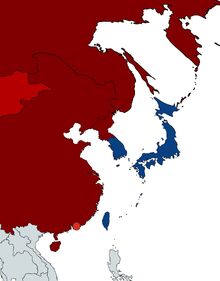
The Eastern Front 2021
China used these offensives to prevent allied naval forces from reaching Japans southern islands, so it could prepare an amphibious invasion of said islands. After the first month and a half, Australia joined the Allies and declared war on China, Russia and North Korea, while a week later New Zealand also joined. Australia allowed the US to further use its territory as a base, while also preparing to send troops into Korea and the South China Sea. Indonesia, that strenghtened its ties with China by becoming part of its "Belt and Road" initiative declared its neutrality, while still keeping close relations with China. In order to prevent being entangled in the war, Indonesia declared its waters as a non-militarized zone, denying entrance for any warship that tried to pass through its important sea corridors. Meanwhile the US launched a series of bomber strikes from Guam against the chinese attackers around Okinawa, while also attempting to strike coastal China, leading to steep casualty numbers on both sides. The majority of attacks against chinese coastal targets failed though, due to chinese anti-air defenses. After a few weeks of bombings, China managed to take the Senkaku and Sushima islands, while also preparing to invade Okinawa. In the same time, China amassed its forces to take Taiwan, due to its strategic position and its territorial claims. Chinas build up of forces was severely hampered by american naval and airborne assets, which were able to inflict heavy casualties on the chinese invasion armada. Several missile strikes were conducted to take out taiwanese defenses, leading Taiwan to declare war on China. Chinese forces conquered the taiwanese islands off its chores, while also invading the Taiping Islands. Taiwanese air and naval forces conducted several hit and run raids, while mobilizing its Population.
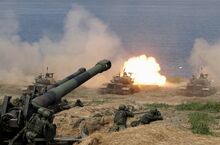
Taiwanese defences along the beaches. Source: National Interest
But taiwanese defenses were steadily thinned out by chinese missile strikes, which were paving the way for waves of air attacks. Taiwanese ground defences though were strenghtened by the insertion of japanese reinforcements. Due to being pre-occupied with China in Okinawa and the East China Sea, as well as Korea, US forces weren't able to support Taiwan in any significant way, leading to the fall of the Penghu islands. Taiwans fleet battled the chinese one in the strait of Taiwan to prevent that, but only managed to damage and destroy a few dozen chinese ships. With the Penghu islands being taken, China prepared the invasion of mainland Taiwan, while taiwanese rocket artillery kept on hitting the makeshift chinese bases on the occupied islands. Chinese drones were used to draw out taiwanese anti-air defenses, while the chinese recon assets kept track of taiwanese troop movements.
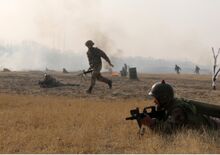
Chinese forces in action. Source: Getty Images
While the landing forces embarked, China conducted a series of airborne surprise landings, further dispersing the taiwanese defenses. The airborne assault managed to capture a port in Taiwans rear, forcing taiwanese troops in the area to retreat further into the mountainous interior of the island. Dozens of chinese landing ships were sunk, but a large portion of the invasion force remained operational, leading China to land troops on a area comparable to the Normandy landings in terms of distance. Taiwan concentrated its mobilized population in the landing area, using its artillery to deny the chinese from securing airstrips and further beachheads . The chinese advance was halted due to taiwanese numerical superiority, forcing the chinese to impose a naval blockade against Taiwan, while continuing to send supplies to the landing force. Meanwhile, after a week long blockade and intimidation with build up of force, China annexed Hong Kong despite massive protests from its population.
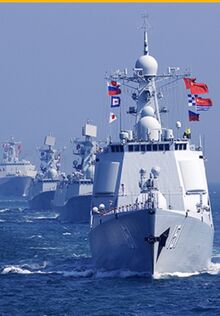
Chinese and russian vessels in the South China Sea. Source: Getty Images
The Second Battle of the Spratly Islands though remained inconclusive, with both the US and China losing several ships and thousands of troops, even though China suffered heavy damage of its bases on its artificial islands. In Korea, the Allies struggled to push back against the Revisionist Powers, due to the increased numbers of troops China kept sending in. With the US bases in Japan being constantly harrassed, the Allies lacked behind in bringing in more soldiers and supplies until the australians arrived, forcing them to retreat back to the line from Kaesong to Hoeyang. The small size of the Korean Peninsula, as well as the dense urban population lead to heavy civillian casualties, reaching more than a million people dead in just 2 months of the war. The first wave of large scale support and reinforcements for the Allies was send from Australia, Hawaii and Guam, while being under attack from chinese and russian submarines . Submarine launched missiles hit targets in Guam and coastal Australia, and although many of the enemy vessel were identified and destroyed, Australia was forced to increase its anti-submarine effort in the Pacific , the Timor sea and Arafura sea, leading to increased tensions with Indonesia, which claimed that allied vessels were entering its waters without permission. The attacks on Australias coastline, as well as multiple assaults on military and merchant shipping in the soutern Pacific lead Australia and the US to increase their military presence not only in Guam, Hawaii, American Samoa and Australia itself, but also in Papua New Guinea. In order to deter chinese aggression in the southern Pacific, a higher number of warships was stationed at the Lobrum base in Papua New Guinea. The heightened presence of australian, american and new zealandish troops in its neighbours territory also created tension with Indonesia, leading to a new flare up of indonesian paranoia, accusing Australia and the Allies of planning to support freedom fighters in West Papua, against which Indondesia conducted a years long attack of isolation and offensive action.
The Southern Front: Mayhem in the Middle East
With both Europe and East Asia falling into chaos, the regional powers of Saudi Arabia and Iran, which enjoyed a numerical advantage over Saudi Arabia, struggled to utilize the war to claim dominace in the Middle East. The arab coalition of Jordan, the U.A.E, Egypt and Kuwait, lead by Saudi Arabia, managed to push forward into revisionist territory, but were halted in a line from Damascus, over Falludscha to Basra, leading to brutal fighting in urban territory, with both sides showing no regard for civillian casualties. Iran in the meantime followed a anti-access/area denial (A2/AD) strategy against the Allies.
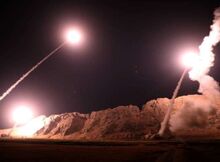
Iranian missile launch towards the syrian battlefields. Source: Getty Images
By using recon assets like coastal radars, UAVs and civillian vessels to track down and target allied surface vessels in the Persian Gulf, before initiating a concentrated attack against US ships in narrow waters. Iran launched a massive number of rockets to overwhelm the US's AEGiS naval combat systems, while also luring the vessels towards prelaid mine fields. These attacks where supported by shore based ASCM missile systems, and Klub-K missiles launched from apparently civillian ships. Meanwhile, US airfields in Saudi Arabia where targeted by salvos of iranian missiles, before the islamist republic launched waves of precision strike SRBMs armed with more accurate submunitions that hit unsheltered planes and US assets. Iranian proxy forces then also aimed towards US bases with guided missiles and presighted mortars.
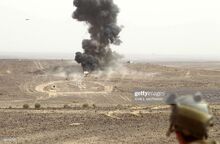
Allied soldier witnessing an explosion close to the jordan-saudi border. Source: Getty Images/Khalil Mazraawi
Isreali troops, which were indirectly coordinating their attacks with Saudi Arabia , entered both Lebanon and Syria, although they were met with heavy resistance from syrian troops dug in into the Golan heights. The Hizbolah militia, as well as Iran launched a wide series of missile attacks against Israel, but the majority of the missiles were intercepted by Israels Iron dome system. Yet, several missiles did hit Tel Aviv and Nablus, leading to the largest number of isreali casualties in more than a decade. Israel also used the war to pursuit its own agenda, meaning they aimed for iranian targets tied to the nuclear program of the islamist state, that's why israeli jets went after iranian nuclear facilities, like power plants and possible bunkers, delivering a fatal blow against Irans nuclear capabilities. As a result of the destroyed nuclear sites, large areas of rural Iran were polluted by radioactive fallout, which were only made worse by wind and sand storms, leading Iraq and even small areas of Turkey to be affected as well. Iran in retaliation conducted a massive wave of missile and air attacks not only against Israel, but also Saudi Arabia, hitting important bases throughout the entire Arabian Peninsula.The Iranians where able to hit more saudi aircraft with their strike, due to lower numbers of overall saudi bases and therefore higher concentration of assets on these facilities. Iran also closed the Strait of Hormuz, leading to another international oil crisis, as well as the First Battle of the Hormuz Strait, since the US navy , supported by french, british, saudi and even japanese vessels and aircraft to break through the blockade. In order to fully seize control of the strait, Iran deployed various influence sea mines, along high quantities of surface contact mines. The influence mines where layed out covertly by iranian submarines, while less sophisticated mines where deployed by surface vessels to deny passage for any US ship. Saudi airforces assisted the US in its mine countermeasures with targeting iranian vessels, but this tied down important airpower which was needed in the ground war. Iran launched land-based ASCM missiles from its islands in the strait, complicating US counterattacks.
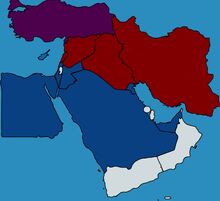
The middle eastern theatre of WW3
Meanwhile, french, british and american air forces kept on clashing with their russian counterparts, but they received no support from their arab allies, due to the close ties of many middle eastern nations with Russia. On the ground, the western allies engaged with the arab coalition against Iran and its revisionist partners, who were supported by various radical islamist groops, conducting terror attacks to slow down the allied approach. Turkey invaded the nothern territory of Syria and Iraq to exterminate the kurds, using anti-terror ambitions as a excuse for its operations. The turkish dictator Erdogan saw this war as the perfect opportunity to play both sides and prevent the kurds from forming an independent state at Turkeys border, that's why he ordered massive airial attacks against kurdish strongholds in the entire region, leading to heavy casualities. The increased turkish attacks lead to new waves of PKK terror attacks against turkish police and military facilities, which was then used to justify increased military force against kurdish regions in the southeast of Turkey. First reports of turkish troops activly targeting kurdish civillians came up, but were muted by both the turkish controlled media and the Allies, since they kept supporting Turkeys war effort against Syria and Iraq as part of their appeasement policy , unknowing that Erdogan already collaborated with the Revisionist Powers. The turkish operations also forced the YPG and Peschmerga to increasingly join forces with Baschar al Assad as they did in October 2019, while allied troops reached the outskirts of Damascus. Syria and Iran resorted to chemical weapons use, while digging in, which slowed the allied advance to Damascus down.
The Afghanistan conquest
In order to support the allied war effort in the Middle East, the US tried to redeploy their Reaper Drone fleet from Afghanistan to the base in Cyprus, but a large portion of drones were destroyed after they crashed down following the destruction of the Ramstein airbase in Germany, from where the drones were operated. Smaller drone squadrons, as well as airial transport units flew over neutral Turkmenistan in order to avoid iranian air forces. Over the Caspian Sea, the US transport fleet suffered heavy attacks from Russias caspian fleet, as well as iranian ships and planes, which was later called the Battle of the Caspian Sea. The Revisionist Powers knew that the Allies would use their troops stationend in Afghanistan to open a second front into Iran, in order to relieve pressure from Saudi Arabia and its coalition. Although, the western allies only had a very small military presence in Afghanistan after the US-Taliban peace agreement of 2020.That's why a joined surprise attack was launched at Afghanistan to take the rest of the allied reinforcements out, leading Russia, China, Iran and Pakistan, as well as forced troops from the central asian republics to simultaniously invade Afghanistan. Due to the largely reduced military presence of western forces following Trumps pull-out of Afghanistan, the Allies lacked in numbers to effectively counter the advancing enemy. The Revisionist Powers also received support from the Taliban, who seized the opportunity to take down the western troops. Afghanistan, which originally declared its neutrality, tried to fight back, but the afghani forces lacked morale, due to a decade of futile fighting against the Taliban, as well as widespread anti-western sentiment.
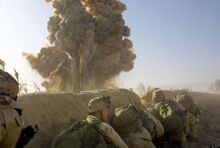
US soldiers taking cover during an explosion. Source: Getty Images
Allied troops from Operation Resolute Support showed heavy resistance against the attackers, although Turkey withdrawed its forces at the beginning of hostilities in Afghanistan. The in Afghanistan stationed soldiers of Armenia and Mongolia reluctantly joined their invading counterparts, and after armenian attacks hit georgian forces of Operation RS, Georgia declared war on Armenia. Due to the fact that the revisionist invasion caught troops from Azerbaijan in the crossfire, Azerbaijan also joined the Allies against Armenia in the Caucasus. Troops from passive and neutral NATO countries, like Denmark, Croatia, Portugal, Slovakia, Slovenia, Luxemburg and Albania came also under attack, forcing those to officially declare war on Russia, Iran, China and Pakistan, although they still not mobilized their armies at home. Czecheslowakia, Hungary and Bulgaria still remained neutral, even though their troops were also attacked. The non-NATO country of Bosnia-Herzegowina also declared war on Russia, creating increased tension in the Balkans, especially with pro-russian state Serbia, that feared possible clashes between NATO and Russia in the region. Romania declared war on the revisionists as well, preparing its troops to support Poland and Ukraine at the Western Front. Due to the multi-directional invasion of the Revisionist Powers, the Allies were forced to retreat into the heart of Afghanistan, effectivly being surrounded. While allied forces tried to prevent a enemy breakthrough in the Battle of Kabul, the afghani president Ashraf Ghani sought an armistice with the Revisionist Powers, leaving the Allies without afghani support. After a month of fighting, the last remaining allied troops surrendered at Laschkar-Gah, leading thousands of soldiers to be lead into captivity. The Taliban were able to seize the entire nothern part of Afghanistan, including Kabul, forcing the government to flee to Kandhahar.
Allied struggles on the Western Front: The Battles for Warsaw, Helsinki and Kiev
After the fall of the Baltics, Russia continued to focus its operation against Europe by sending its troops in Poland further to the West, taking Lublin and threatening to encircle Warsaw. The polish army, while being forced into steady retreat until the allied reinforcements can fully engage, prepared itself to defend its capital against Russia. Fierce fighting emerged, with both sides pounding each other with heavy artillery and missile strikes. Thanks to the incoming support from the europeans, canadians and americans, the Allies were able to increase their advantage in the air, heading towards air superiority. As a result, the russian air force played rather defensivly, while also deploying their anti-air weapon sytems closer to the Western Front, leading allied losses in the air to mount rapidly. Meanwhile, Russia send the bulk of its tanks and amoured vehicles into Poland, to further push towards Warsaw, leading to the biggest tank battles since WW2.
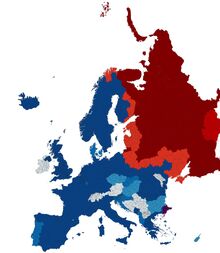
The Western Front at the End of 2021 (North Macedonia not shown as a passive allied state)
In the Baltic Sea, allied attempts to break through to the Baltics failed, due to Russias Baltic Fleet mining large portions of the sea, while sticking close to the chores. The allied reinforcement from Britain, France, Belgium, the Netherlands, Germany, Montenegro, Spain and Canada finally consolidated itself enough to catch up with their polish co-beligerents, while the US support arrived in the ports of Germany, although lacking severely in manpower needed at the Western Front. Following the Pentagons "Assault Breaker II" strategy, the US deployed 12 B-52H Bombers at the Western Front, armed with Assault Breaker standoff missiles, which were able to release swarms of smaller submunitions with infrared sensors,in order to hunt down and destroy enemy tanks behind the frontline. The US also brought in several JSTARS aircraft to guide the 52s. In the same time, Russia and China forced conscripts from Kyrgystan, Uzbekistan, Tajikistan, Kazachstan and Mongolia to be deployed at the Western Front to support the Revisionist Powers, while Russia ordered the mass mobilization of its population. Revisionist forces were able to take Pulawy, and a few days later Radom, due to constantly harassing allied supply lines, while also using its advantage in tanks and anti-air capabilities , but lost thousands of troops in the process. The Allies started to increase the defenses in and around Warsaw, while taking position to stop the russian approach from Mlawa and Siedlce. Allied air forces were able to install a certain level of air superiority, leading to some of the largest dogfights in history.
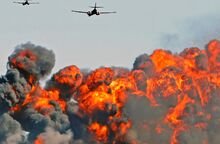
Aerial bombing in Eastern Europe. Source: Getty Images
On the ground, the Allies struggled to bring the russian advance to an End: the UK and France had not only to concentrate on Poland, but also the support for Scandinavia, as well as the Middle East and the Eastern Front, thus limiting their overall capabilities. Germanys army lacked severely in operational equipment, and trained personnel, due to years of heavy mismanagement and underfunding of its military , making it effectivly unable to provide considerable support to the Allies. This, along with lacking support from the US and the limited strength of smaller NATO Partners, lead the Allies to be pushed back to Warsaw. The russian army, and its ally Belarus reached the outskirts of the polish capital, while suffering massive air, missille and artillery strikes, and with its counterattack, the casualty numbers on both sides mounted massively in a very short time, similar to the opening phase of WW1. After the mass evacuation of Warsaw, the Allies dug into the city, hoping they could hold their ground until further reinforcements could be consolidated.
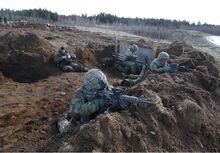
Allied troops in Eastern Europe. Source: Getty Images
In Scandinavia, both the Allies and the russians used the network of lakes in Finnland as natural barricades to strengthen their positions, leading the finnish front to become the next part of the frontline that went static, after Norway. Russians troops were closing in towards Helsinki thanks to both aerial attacks and missile strikes coming from the waters around occupied Estonia , forcing the finnish government to flee to the islands in the Bottnian Strait. The geography of Finland, with its forests and vast network of lakes narrowed the routes of the invading russian armored divisions down a lot in the south, allowing the finnish to hold on to Helsinki for a fairly long time. The usage of portable anti-armor missiles from the scandinavians forced the russian artillery to flatten vast amounts of terrain to allow its armored units to move towards Helsinki as safely as possible, creating massive casualties. Due to continuous bombardment, the civilian population of Helsinki started to seek shelter in the underground bunker systems of the capital, while on the surface, russian troops were besieging Helsinki. In Ukraine, the troops of Salenskyj received one defeat after another, and after weeks of brutal bombing and trench warfare around Kiev, the ukrainian capital falled into the hands of Russia and the Donbass rebels. Pro russian ukrainians sabotaged the war effort of the pro-western army of Salenskyj, leading to civil war like uprisings in the free parts of the nation. Thousands of refugees entered Romania, Moldova, Slovakia and western Poland, hoping to find shelter. The remaining population then saw some form of total mobilization and partisan resistance, due to many ukrainian citizens being armed with black market weapons following the war of 2014. Romanian troops entered Ukraine as the first NATO forces in the area, while suffering missile attacks from the direction of the now russian controlled Black Sea, targeting the NATO anti-missile shield there. Many of the missiles were intercepted, but the romanian capital still received some hits. The allied troops then used the swamplands in Ukraine as natural buffers to slow down the revisionist advance , while strengthening their defenses. After a month of non-stop fighting, as well as tens of thousands of casualties in both military personnel and civillian life, Warsaw fell into the hands of the Revisionist Powers.
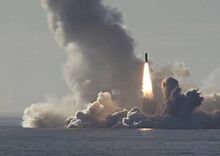
Submarine launched russian missile attacks Source: Getty Images
The allied defeat at Warsaw brought the Allies to the realization that this war won't stop any time soon, that's why the nations of France, the UK, Germany, Belgium, the Netherlands, Norway, Sweden and Finnland ordered the general mobilization of their population, for the first time since WW2. Especially Germany was reluctant to add more manpower to the allied war effort, due to its lack of equipment, trained personnel and the widespread anti-war sentiment of its population, leading Germany to conscript individuals that were unfit for the regular standards of the Bundeswehr. While most of Europe mobilized its citizens for a possibly long and bloody war, the Allies prepared themselves for a big offensive targeting Kaliningrad in the upcoming year. Russia also prepared for further offensives, that's why it deployed its new Armata tank fleet, as well as a Tupolev squadron in Poland against the Allies.Meanwhile, as a symbol of peace and solidarity, artists from all over the world joined together both in person and through video in order to perform a new „Live Aid“ Event, aimed at gathering donations for refugees in Asia, Europe and the Middle East. Singers, Bands and Songwriters managed to organize multiple simultaneously occurring concerts in London, Paris and Vienna, with another one taking place in New York , making it the largest beneficial concert in human history, which was able to gather around 100 million dollars for humanitarian causes.
2022
India joins the war
With both its main rivals, Pakistan and China, siding against the US, the asian powerhouse of India, originally a SCO and BRICS member, ended its neutrality and joined the Allies by declaring war against China and Pakistan. While indian troops clashed with pakistani forces in Kashmir, where both sides were engaged in a tense conflict in 2019, India mobilized its forces against China in the himalayan mountains. The original position of bases and troops favored India, since the majority of chinese bases and missiles where aimed to the East. Indian troops entered the Himalaya and enjoyed a numerical advantage against the chinese , but due to the harsh terrain and large altitudes to cross,
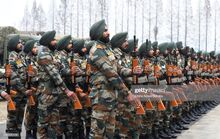
Indian display of troops. Source: Getty Images
India struggled to bring in much of its attack helicopters, tanks, self propelled artillery and aircraft. Since only a small fraction of roads was available for larger armed formations due to topography and brutal winter conditions, China managed to await the indian forces in various choke points with its guided missiles fired from the mountains , leaving both sides with only light infantry troops and smaller portions of artillery to fight the enemy. The artillery and missile bombardements in the mountains created a multitude of avalanches, which killed thousands of people, not only in military personnel but also civillian life. China managed to hit several indian bases in Himachal Pradesh, Jammu and Kashmir with its bombers, thanks to its superiority in recon satellites. Since China was only able to station a rather small fleet of aircraft in the few bases in the inhospitable plateau of Tibet, India managed to perform a series of arial incursions all over the Front, with focus on Kashmir. China established some balance of airpower by using commercial airfields in the Plateau of Tibet as long as it took to redeploy more troops to the west. Both sides struggled to use their long range Radar systems , due to the Himalayan Mountains, leading the majority of fighting to be done by regular infantry units. The Invasion of pakistani Kaschmir, where both sides already had around 700.000 soldiers stationed lead to massive casualties in just about a Week. The mountainous geography of Kashmir made it Impossible for larger armed formations to break the defences of either combatant, leading this part of the Front to become quite static. Both India and Pakistan tried to neutralize enemy airfields with missiles, but pakistani lack in missiles, compared to India, and the larger distances the pakistani weapons had to cross, lead to a minor indian advantage.
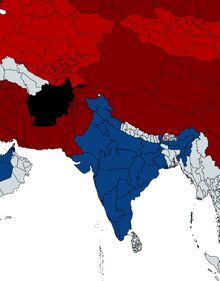
The indian Front at the beginning of 2022.
Indias superiority in intelligence assets, like UAVs allowed it to monitor pakistani air and ground movements, which lead to the neutralization of a large portion of Pakistans airforce by the end of the first month. Following the constant harassment of pakistani airfields, India started to use its multi-role aircraft in ground striking operations, in order to support its ground forces for upcoming invasions of Pakistan. While India continiously concentrated its troops for a full scale Invasion of Pakistan, said Revisionist Power on the other hand attempted to invade India where its defences were the weakest, which was in the area of the Thar desert, but the harsh terrain made it impossible for larger armed formations to cross into India, allowing the defenders to bring the pakistani push to a halt. Pakistani troops then used the widespread desert to draw out indian forces, inflicting somewhat heavy casualties on the defenders. In a first invasion wave aside from the Kashmir campaign, India started an offensive into the flat Punjab region, leading to some of the biggest tank battles in History. Since India only had a limited number of roads available for its troops in this narrow area, it also prepared an invansion of the Thar desert, despite the risks, while also staging everything needed for an amphibious assault on the pakistani coastline. The pakistani navy, supported by the airforce stayed close to the coastal area, due to numerical superiority of indias navy, but it was able to keep the enemies fleet at distance with its relatively modern anti-ship missiles. In order to keep up with indian forces, Pakistan also received forced conscripts from Tajikistan, Uzbekistan, Kyrgyztan and Kazachstan, just like Russia did in the West.
The Battle for Europes seas
While Europe prepared more and more fresh recruits as a result of mass mobilization for the battle against Russia, the war on the european seas was heating up. In the Baltic sea, russian vessels continously layed out sea mines to deny access to the polish and baltic coast for allied ships, while using their Kalibr missiles to disrupt allied supply lines from the sea. The navys of Finnland, Sweden, Poland and Germany tried to break through russian naval defenses, but due to continious submarine attacks, air raids from the occupied Baltic coastline and anti-ship missile attacks, said navys suffered heavy losses, without reaching the polish coast. The danish navy patrouilled the entrance of the Baltic Sea, and its own shores, while remaining far enough from the open sea to avoid direct clashes with russias fleet.Since the allied fleets dwarfed russias Baltic Fleet, russian vessels stayed close to the coastline and the Baltic Sea entrance close to the danish defense lines to play more defensivly , supporting the Russian airforce by sea. Russian Tupolev bombers in the nothern Atlantic were able to perform several incursions into the north sea, using long distance stand off missiles to hit allied ships that tried to sail further north.
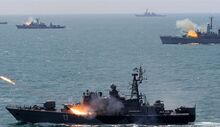
Allied ships during a joint offensive. Source: Getty Images
Allied vessels then patroled the UK-Iceland-Greenland gap, in order to prevent any russian attemp to sail further into the atlantic. While the allied navy secured said gap, the fleets of Britain, France, Norway, Belgium, the Netherlands and the US then tried to threaten the base of russias Nothern Fleet in Murmansk, while also targeting the russian coastline. The result was the Battle of the Barent sea, which became one of the largest naval battles of the entire war. The russian Nothern Fleet stayed defensivly, in order to protect the russian coast, inflicting damage to the allied fleet through its attack submarines. Allied ships also came under attack by russian aircraft and anti-ship missiles from the direction of Murmansk, and even though the allied navy slightly outnumbered the russian fleet, the Allies suffered heavy casualties. After losing many ships and aircraft against the russians due to submarine, air, and missile strikes, the allied attack was called off. In the Baltic sea, russian airborne assault troops were landed on the swedish island of Gotland and the Aland islands in the Gulf of Finland, taking those in a rather short period of time. Russia used the time it bought by mining the sea to fortify the swedish island of Gotland, turning it into another base of operation from which it can threaten allied supply lines with additional Iskander missile attacks. In Poland, the Allies tried desperately to slow down the russian approach, in order to get enough time to fully consolidate its mobilized troops. US bombers and allied fighter aircraft managed to establish some form of air superiority, using their vast missile arsenal to hit russian supply lines within conquered territory. Further incursions into russian territory resulted in desaster though, due to Russias S-300 and S-400 anti-air defenses, which were able to hit the enemy from within russias borders. After the fall of Warsaw, Russia started to dug into the city, using it as some kind of fortress against allied approaches, while revisionist troops pushed towards Bromberg and Danzig. Polish troops on the Hel peninsula tried to slow down the russian approach from Kaliningrad by using artillery and guided anti-tank missiles, but they became trapped by russian attacks from the sea, and air and missile attacks from the Kaliningrad exclave, leading them to be almost completly cut off from the mainland.
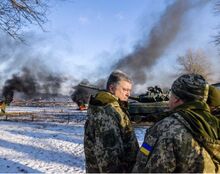
Former ukrainian president Poroschenko visiting troops in the field. Source: Getty Images
In Ukraine, the fresh reinforcements in form of the romanian army did not managed to stop the revisionist advance to the west, but were able to prevent deeper incursions from the Revisionist Powers in the North around Lutsk with the support of the Black Sea Fleet, Russia managed to take the coastal town of Odessa, closing in to the ukrainian-moldovia/transnistrian border. Protests of the muslim crimean tartarians against the continous influx of russian forces into the Peninsula, which were seen as an opressing force by many tartarians, where brought to an violent end by the occupying troops. Russia accused the West of encouraging the tartarian protests, which also lead to some minor acts of sabotage against the russian military. As a result, russian troops in Crimea started to use military force against the protesters, leading to days of civil unrest which culminated in a hundred tartarians being massacred by the russians. Russian troops stationed in the moldovian breakaway region of Transnistria were already mobilized and ready to engage in combat, When their counterparts in ukraine reached the outline of the border. Russian troops in Transnistria then allowed soldier movements from Ukraine into Transnistria, without moldovian permission. The moldovian government then demanded that russian troops from ukraine should leave Transnistria immediatly, in order to prevent Moldova from being entangled in the war. The moldovian demands were ignored and russian troops crossed transnistria to prepare an offensive against Starokozache and Russko-Ivanokova in Ukraine, while also taking position in Ribinitai in Order to encircle allied troops in Ukraine. Russian forces then occupied not only the airport of Tiraspol, but also the trainstation in Tighina, which was already outside Transnistria. The pro-western government of Moldova increased the pressure on the rather pro-russian president Donov to take action, which he denied at first. But after russian missiles launched from Transnistria hit allied targets in Ukraine, the counterstrike not only hit the breakaway republic, but also Moldova, leading to a ultimatum towards Russia that any acts of war from russian troops in Transnistria should be halted. It's ignored, leading Moldova to declare war on Russia. In the same time in Poland, revisionist troops where able to take Thorn and Bromberg, while fresh recruits from all over Europe arrived on a daily basis in Poland.
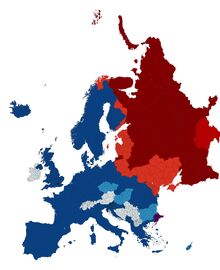
The Western Front at the beginning of 2022. (Edit: North Macedonia not shown as a passive allied state)
The US in the meantime kept bringing in new ressources for the Allies and the aproximate 70.000 US soldiers in Europe, despite occasional submarine attacks. The american EUCOM took over the role as the main allied command in Europe, while NATOs AIRCOM, LANDCOM and MARCOM became the base commands for allied land, air and sea operations overall. The majority of russian submarine attacks remained unsuccessful, due to allied naval superiority and the vast number of enemy vessels to hit, while allied guarding ships prevented larger russian breakthroughs through the UK-Iceland-Greenland gap. Among the US weapons delivered to Europe where large numbers of HIMARS and other rocket launcher systems, aimed for hitting russian targets by long range artillery bombardment. The US also brought in several anti-air and missile defense sytems, just like Patriot and THAAD batteries. Meanwhile, the Allies managed to gather and consolidate enough forces to send more reinforcements along the entire Western Front: Troops from France, the UK, Germany, the US, Canada, Belgium, the Netherlands and Montenegro took position in Poland, while reinforcements from Italy, Spain, Portugal, Greece and Romania , with french and german support, went to the last free areas of Ukraine. Slovakia, which feared the war will reach is borders as well, also send troops to the crosssection between the polish and ukrainian part of the front. After weeks of fierce fighting, Moldova was overrunned by the Revisionist Powers, forcing the moldovian government, as well as the remaining moldovian troops to Romania, while russian troops managed to conquer the Odessa Oblast.
The Fall of Taiwan
At the Eastern Front, both the Allies and Revisionist Powers struggled to gain the upper hand. On the Korean Peninsula, China managed to establish numerical superiority of ground troops, leading to a revisionist push into South Korea through the second battle of the DMZ, allowing chinese, russian, north korean and mongolian troops to take Donducheon. Even though chinese missile and submarine attacks were able to harass the allied supply lines in the Pacific, the troops of the US, South Korea, Japan, the UK, Australia and New Zealand managed to receive further material ressources and aditional manpower to hold their ground. The american INDOPACOM in the meantime officially became the main allied command in Southeast Asia and the Pacific.
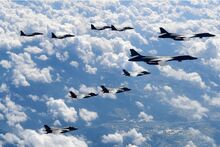
Allied Aircraft in East Asia. Source: Getty Images
The Allies were able to create some parity with the Revisionist Powers in the sky, since both the russians and chinese were able to deploy only a fraction of their airforce in Korea, while North Koreas airforce contained mostly outdated Cold war era aircraft, leading the Revisionist Powers to suffer heavy casualties in the sky due to superior allied air defences. This aerial advantage was then used by the US to conduct a series of bomber strikes against revisionist targets in Korea, the East China Sea and occasionally the chinese coast, leading to several losses on both the ground and the sea for China. The middle kingdom decided to neutralize the allied strongholds in the Pacific, starting with Guam. China launched a Wave of supersonic DF-26 "Guam-Killer" and DF-21 missiles, hitting the US bases in Guam and several Nimitz class carriers as retaliation, leading to heavy civillian casualties on the island and among the US Navy and airforce. China then also launched various DF-10 990 pound missiles against Japan and Taiwan, hitting targets on Kyushu and the Senkaku and Sushima Islands, as well as all over Taiwan. Months of naval blockade and increasing numbers of chinese landing troops, supported by waves of airstrikes and missille attacks, lead most of Taiwan to fall under chinese control. Taiwanese forces fell back to Taipei, where they intended to launch a campaign of local counter attacks in order to hold at least some portion of the country until reinforcements arrive. Since the majority of the taiwanese population was mobilized and armed, the chinese invaders were still met with pockets of resistance, leading to several massacres against taiwanese civillians.
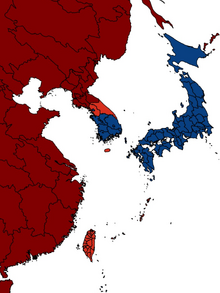
The East asian part of the Eastern Front at the beginning of 2022.
Chinese forces swept the cities and shooted every civillian that refused to obey, or otherwise opposed the chinese advance, while the chinese airforce, supported by chinas larger network of recon sattellites, specifically bombed any civillian area where it suspected any kind of resistance. Through these massacres alone, 10.000 taiwanese would die until the end of the war. After sucessfully taking Taiwan and the Senkaku and Sushima Islands, chinese forces landed in Okinawa, after months of bombing and missile strikes. Despite heavy resistance from the japanese brigade and the US forces stationed in Okinawa, China managed to take the majority of the island in a few weeks, due to chinese ships and submarines preventing any allied reinforcement to through. With both Taiwan and Okinawa as new bases of operation, China prepared for more land grabs by planning to perform Island hoping towards Kyushu. China then stationed multiple A2/AD systems on the conquered islands, creating a new chain of defenses against the Allies. Since the Allies managed to dominate the sky over the Eastern Front, the US kept on interferring with the chinese advance by performing various B-52 stealth bombing campaigns, which demolished many makeshift bases of the chinese on conquered territory while also damaging chinese vessels in the South and East China seas. In the meantime in Korea, the revisionists were able to push further through allied lines, since reinforcements were constantly harassed, allowing the revisionist troops to break through and take Uijeongbu , Chuncheon and Gangneung. This allowed chinese, north korean and russian troops, with mongolian support to encircle Seoul, leading to fierce urban fighting. In Japan, russian aircraft performed several incursions and missile strikes on Hokkaido, while the russian Pacific Fleet battled japanese vessels in the Sea of Japan.
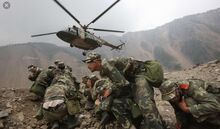
Chinese forces in the mountains. Source: Getty Images.
The russian navy was pushed back and suffered several casualties, forcing it to take a more defensive position further north, while submarines hunted allied vessels in the sea of Japan and conducted a series of missile strikes against targets on Hokkaido, in order to prevent a amphibious invasion of russian islands. In the Himalayan Mountains, both indian and chinese forces were still caught in a dealock, since neither side was able to bring enough soldiers and heavy equipment over the mountains. China managed to increase the numbers of aircraft on reconverted civillian airfields, so it was able to inflict more damage to incoming indian planes and attack helicopters. Since China was building up forces in the West for almost two months, the Revisionist Power pushed for an offensive into Arunachal Pradesh, Sikkim and Kashmir, leading to heavy casualties on both sides due to the difficulties of mountain warfare. Both sides were only able to use parts of their missile arsenal against the enemy, since they were stationed in opposi directions. Still, chinese edge in fighter jets and recon sattellites, as well as a slight advantage in attack helicopters, allowed China to sucessfully push into indian territory during the battles of said areas. But the indian part of the Western Front remained static, since the chinese advance came to a stand-still due to indian numerical superiority on the ground. In order to sucessfully take on India, China knew it would need to bypass the Himalaya, leading to chinese demands to Indias neighbouring countries for free passage, as well as traditional chinese allies, and indian adversaries, to join the revisionist cause. Many nations were reluctant to comply to these demands, although small nations like Nepal and Bhutan were basically forced to join either side, since both of these nations were wedged between China and India. Nepal showed willingness to grant free passage to the chinese in order to prevent aggression from the Middle Kingdom, while hoping for economic gains. Nepal assumed the vast mountains would provide enough protection against possible indian retaliation, that's why Nepal allowed chinese troops to cross its territory towards the indian border.
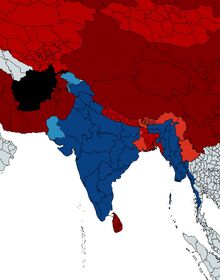
The indian part of the Eastern Front 2022.
Bhutan on the other hand denied China access to its territory and declared its neutrality, while Myanmar also refused to obey to China. In the pacific, the Phillipines finally declared war on China after the Invasion of Taiwan and chinese grabbing of islands throughout the region. The authoritarian president of the Phillipines, Rodrigo Duterte was rather reluctant to join the Allies, despite the Mutual defense agreement between the Phillipines and the US, since he was more pro-chinese than other asian US Allies, leading the Phillipines to play both sides prior to the war. Nonetheless, the Phillipines became part of the Allies and brought in naval and air power against the chinese in the East and South China Sea, while allowing allied forces to come to its territory as another base of operation in addition to Australia. The increasing influx of allied ships from the Pacific to the seas of the Eastern Front lead to massive tension with Indondesia, that followed a more pro-chinese stand in the years before the war and was already engaged in tensions with Australia due to its aggressive stance against indonesian refugees on the seas, while also granting asylum to west papuans. Indonesia used the war to intensify its fight against west papuan freedom fighters by utilizing brute military force against the seperatists. Indonesian troops, that were already more present in this area to protect its neutrality in the world war, were even landed on West Papua to attack the rebels, while being supported by local islamist militias. Indonesian warships came extremely close to allied vessels, that were stationed on the new guinean island of Manus, leading to new accusations from the indonesian government, that the Allies would support west papua in the way Australia did with East Timor in the 90s. There were also several incidents where Indonesia claimed that allied ships and aircraft were violating its seas and airspace without permission, leading Indonesia to increase the presence of its navy in opposition of allied supply lines. This lead australian and US ships to almost clash with indonesian vessels, which were closing in on them. Tensions escalate when indonesian jets were scrambling allied aircraft on their way towards the Phillipines, forcing those to conduct warning shots against the indonesian assets. Indonesia responded by shooting warning shots against allied vessels that were perceived as being to close to indonesian waters.
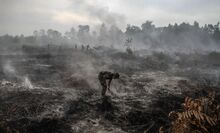
Indonesian forests after massive fires. Source: Getty Images
These warning shots were seen as offensive actions, leading allied vessels to hit indonesian ships and slighty damaging one, which ultimately forced Indonesia to declare war against Australia. The much larger indonesian navy then cut off allied supply lines in the seas around Australia and its own Islands, while both the australian and indonesian navys and airforces engaged in first smaller battles in the Sea of Timor. Indonesia dispersed its navy on a wide Front in the Sea of Timor and Arafura, while keeping its airforce closer to the shores of its smaller islands. Australia, supported by its advantage in surveillance planes and radar systems conducted several air raids against the indonesian navy, as well as Rote island, the Moa and Babar islands and Tanimbar islands, which destroyed several potential airfields and set indonesian jungle forests ablaze. These airstrikes did not killed many people though, since said islands were not densely inhabited. Meanwhile, Nepals free passage of chinese troops lead India to declare war on Nepal, while Bhutan joined the Allies, after chinese troops where entering its territory without permission. Myanmar also declared war on China, after it also saw chinese troops crossing the border without the myanmar government agreeing to it. Bangladesh, a neighbour nation of India, which also had its conflicts with said asian powerhouse, joined China in opposition of India, as well as out of hopes for economic gains from China. Chinese troops then managed to invade Myanmar and create a corridor towards Nepal, while bangladeshi troops invading West Bengal also closed in to chinese troops in Skkim. Sri Lanka, which hosted a chinese submarine base as part of the "One road-one belt" initiative also declared war on India due to chinese pressure.
The Southern Front: War against humanity
In the Middle East, the Allies were able to manage small successes, compared to the other fronts, but the Hormuz campaign still remained in a dealock. Well armed iranian speed boats and fast-attack craft performed several surprise attacks against the US Navy, while covert mines, occasional iranian quiet submarine assaults and mobile shore-based attacks , leading to steep american losses which turned the strait into a naval no-man's land. In Order to counter this iranian asymmetric warfare, the US deployed several Littoral Combat ships, which were able to operate at high speeds and could fight close to the beaches, while also being capable to launch attack helicopters and submarines. At the lebanese part of the front, the shia-militia of Hizbolah, supported by Iran, managed to lure israeli forces into the steep valleys of southern Lebanon, where they were vulnerable to open attacks. Israeli attempts to destroy Hizbolahs rocket arsenal failed, due to the network of over a thousand tunnels and bunkers Hizbolah has dug over the last years.
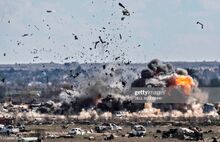
Explosions on the syrian battlefields. Source: Getty Images
The air and missile attacks of Israel lead to many civillian casualties, since Hizbolah placed its strongholds close to the lebanese population, that why hizbolahs forces were intermingled among civillians as a form of human shield. Although the Trump administration backed Israel, which blamed Hizbolah for the civillian casualties, many nations of the world still blamed israel for that. Israeli ground troops, supported by american special forces managed to take Tyros and Dibbine, while a few days later, Sidon also fell into israeli hands, allowing the Allies to threaten Beirut. The lebanese armed forces, being dominated by Hezbolah for decades, showed only little resistance, since they severely lacked morale and hoped the shia militia would be exterminated, or at least heavyly weakened through this war. Israel suffered several missile strikes from multiple directions, launched by Hizbolah, Iran, and iranian proxy forces in syria and Iraq, and even though the advanced israeli iron dome missile defense intercepted many incoming missiles, Israel still received many hits, due to the enormous numbers of missiles fired. Since the Allies dominated the sky, the Revisionist Powers struggled to manage any forms of land gains, Even though they heavily relied on artillery bombardements, which flattened many allied held population centers, with no regard for civillian life.
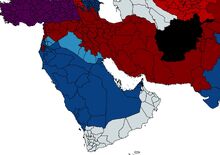
The southern front in 2022.
Iranian infrastructure and bases along the coast were hit by air-to-ground missiles and the superior saudi and US airforce, although these did not managed to perform any deep incursions into iranian territory. Iran tried to counter, using its own ballistic missile arsenal, and even though the saudi patriot missile defense systems provided some protection against the attack, Iran still was successful in hitting strategic saudi infrastructure and population centers. On the ground, the relatively flat desert fields around Kuwait and Iraq allowed both sides to bring in large armed formations and heavy artillery, leading to the devastation of large inhabited areas, especially since neither side showed regard for civillian life. Even though the Allies had the upper hand in terms of technology, the Revisionist Powers enjoyed numerical superiority, making the allied advance very difficult.
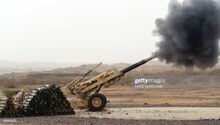
Saudi artillery in action. Source: Getty Images
Nonetheless, troops from Israel, Egypt and Jordan, with the help of french, British and american forces were able to break through syrian defences and encircle Damascus. In the meantime, gulf troops lead by Saudi Arabia pushed deep into the deserted areas of Iraq, allowing them to threaten Bagdad and moving closer to the Iranian border by taking Basra, forcing Iran to strengthen its defences on its southwestern border. In the same time, both sides were engaged in the worst war crimes of the 21st century. Saudi troops, accompanied by sunni militias swept every city they conquered and gathered Shia boys and men, who were then mass executed in order to "secure" the conquered territories. Saudi Arabia justified this barbary with religous reasons, as well as "anti-terror" measures, claiming the killed individuals where either iranian spys or fighters. This was met with loud outcries from the population of western Allies, while their governments to stayed silent in order to prevent losing Saudi Arabia as an Ally. In Iran, opressed Sunni minorities started to demonstrate against the regime, while iranian forces also commited several massacres against sunnis in Iraq, Syria and Kuwait. The mullah regime blamed the enemy for this civil unrest, and therefore declared those who demonstrated as enemies as well. As a result, the iranian revolutionary guard started to fire into crowds of Sunni protestors, while arresting and deported those who survived. Iran build several prisons/labor camps in its more remote areas, where they incarcerated Sunnis and forced them into labor as POWs, even though those were iranian citizens. Many sunnis, but also western nationals and other minority members where executed and tortured in these camps, which was exploited for allied propaganda.

Turkish troops in conquered kurdish cities. Source: Getty Images
Turkey, an official ally who secretly collaborated with the Revisionist Powers, also followed through with its campaign against kurdish regions in the north of Syria and Iraq. The troops of turkish dictator Erdogan marched through every single kurdish city and bombarded those with no regard for civillian life. Despite heavy resistance from the Peschmerga and YPG, turkish forces were able to conquer the majority of kurdish cities north of the Euphrates. While continuing with their conquest, turkish troops commited countless war crimes against kurdish civillians . Kurds were mass killed and tortured, while men and boys where forced to dig ditches. Women and girls where often abducted for weeks and raped, before most of them where ultimately killed as well. Turkey denied any claims of these massacres, calling them fake news and anti-turkish propaganda, while also insisting that every measure taken in the conquered areas was just against "terrorists".
Onslaught in the Caucasus
While both Europe and Asia continued to plunge deeper into chaos and destruction, the caucasus, as a crosssection between those continents also saw increased actions of war. While Georgia engaged in combat against russian backed forces in the self-proclaimed republics of South Ossetia and Abkhazia, both Armenia and Azerbaijan went to war against each other. Despite having a numerical superiority against Armenia, the positions of troops at the beginning of hostilities did not favoured the azeris. The autonomous azeri region of Nakhchivan was almost completly surrounded by armenian troops, while the mountainous terrain of both nations only allowed their armoured formations to act as direct infantry support.
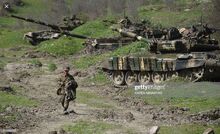
A soldier in the disputed region of Nagorno-Karabakh. Source: Getty Images
The autonomous and disputed region of Nagorno-Karabakh had an army of its own, which was build up and supported by Armenia, allowing armenian troops to enter Nagorno-Karabakh in order to push into Azerbaijan, while armenian troops attacked Nakhchivan, using artillery to shell this cutt off part of Azerbaijan. Through this intensive bombardement, Armenia managed to take Dyudengya and Shakhbuz, while further north pushing towards Tovuz. The armenian offensive through Nagorno-Karabakh also saw some success due to armenian troops entering Mardakert and Agdam city, threatening Ganja. The armenian lack of fighter jets on the other hand allowed Azerbaijan to establish air supremacy, using israeli Jets and drones for both surveillance and offensive operations. Azerbaijan also used its arsenal of ballistic missiles to stop the armenian push, but due to both sides relying mostly on infantry units entrenched in the mountains and hills , these missile strikes remained rather ineffective. Armenias inventory of anti-air defences lead to increased azeri casualties, although azerbaijans advantage in fighter aircraft allowed it to hit several anti-air batteries in counterstrikes. Due to the mountainous terrain, the movements of both sides were heavily slowed down, while azeri jets used turkish standoff missiles to hit armenian targets all over the front, allowing it to increase the pressure on Nagorno-Karabakh. Azerbaijan was able to add a large portion of its reservist pool into the army, which enabled it to retake the conquered territory, while also pushing into the armenian side of Nagorno-Karabakh, threatening Stepanakert. Attack helicopters were used by both sides to maneuver smaller concentrations of troops over the hills, while Armenia pushed further into Nakhchivan.
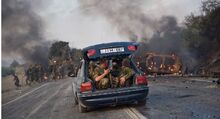
Georgian troops during fighting in the caucasus. Source: Getty Images
Iran supported Armenia by conducting some smaller airstrikes against azeri targets close to its border. Turkey on the other hand used the aggression against Nakhchivan to justify a declaration of war against Armenia. The aproximately 5000 russian soldiers in the armenian capital of Yerevan where concentrated in the North of Armenia, to open another front against Georgia, while also avoiding confrontation with Turkey over Armenia. In Georgia, pro russian insurgents from the rogue regions of South Ossetia and Abkhazia continued to attack georgian forces gathered around the disputed borders, supported by more than 3000 russian soldiers and russian medium range aircraft and artillery. Georgian troops were able to break through barricades around Ghogethi, and the Tsitelubani and Orchosani region, which were used over the years to take additional georgian territory through creeping annexation. While georgian forces advanced towards Akhatgori and shelled Tskhinavali, the push into Abkhazia was halted by incoming russian soldiers. Russia launched a series of missile attacks against targets all over Georgia, including Zugdidi, Gori, Agara and Karelli, while the russian Black Sea Fleet started to shell georgian positions around Abkhazia. The russian forces at Georgias southern border were able to either take or destroy important infrastructure around Amamlo and Naghvarevi, relieving the pressure on South Ossetia. Turkish troops agreed to stay out of Georgia, while russian forces on the other hand did not interfered with the turkish offensive against Armenia, due to the mutual cooperation agreement Turkey had with the Revisionist Powers.
The Battle of Kaliningrad
With the scandinavian part of the frontline being static, and the Revisionist Powers almost completly taking Ukraine, the Allies were desperate to stop the revisionist advance in Poland. More and more recruits are streaming into the war zone, while allied aircraft and anti-air defences were able to further install supremacy in the sky, despite constant russian harrassassment of allied airfields all over Europe. After the last polish troops from the Hel peninsula have been rescued, and civillians have been brought into the safety of refugee camps along the polish-german border, allied forces started the offensive against the russian stronghol of Kaliningrad, from where a lot of Iskander-missile attacks against central Europe have been conducted.
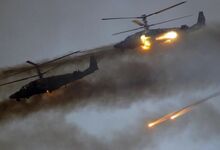
Russian helicopters in action. Source: Getty Images.
Since the Revisionist Powers focused their strength further south after the fall and fortification of Warsaw, the Allies hoped to neutralize the comperatively small exclave of Russia, in order to stop the revisionist advance. Allied surveillance aircraft and satellites helped them in their local build ups of forces, while smaller offensives all over the polish front occurred as an diversion. Troops from Poland, Germany, France, the UK and to an smaller extend the US and remnants of the lithuanian army started the offensive against Kaliningrad by launching several air and artillery strikes against the exclave, while allied navy assets conducted missile attacks against the russian Baltic Fleet and its base. It was the first time in the entire war that official russian territory became target of actions of war, leading to a fierce counter attack from russian and belorussian forces. Due to the nummerical advan of allied troops, the european offensive did managed to push into the territory of Kaliningrad, while allied air losses mounted rapidly because of russian S-300 and S-400 sytems stationend in the exclave. Russia reinforced Kaliningrad by deplyoying its airborne brigades, including air droppable armoured vehicles. Russias Baltic fleet then launched several Kalibr missile strikes against allied targets on the ground of Kaliningrad, with no regard for their own soldiers there.
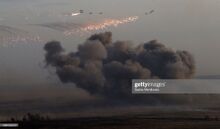
Russian aircraft droping bombs. Source: Getty Imgages.
The Allies also managed to perform a series of airborne landings due to still being superior in the sky, which lead Russia to use its Iskander inventory with the shortest range possible, creating hundreds of casualties in both allied and russian personnel. Allied air superiority though allowed the attackers to track down several mobile Iskander launchers, leading those platforms to be neutralized. The allied advance soon started to slow down due to increasing russian bombing campaigns against the front line, as well as the inexperience of the new allied recruits. Especially the german forces suffered huge casualties , since Germany conscripted thousands of unfitted recruits with an absolute minimum of training. Russian Spetnaz special forces were deployed in order to interupt allied communications, which was addioned by electronic jamming sytems, just like the Krasukha-4 which was able to blind ISR platforms. In order to stop the allied attacks against Kaliningrad, Russia resorted to the use of rather inhumane conventional weapons.
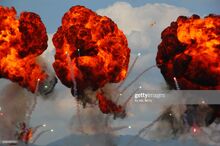
Explosions following the detonation of incendiary bombs. Source: Getty Images.
Russia decided to deploy its arsenal of TOS-1 MLRS weapons, which fired rockets with fuel-air explosive warheads en masse against allied targets. The warheads spreaded a chemical cloud in the air, that seeped into buildings and every Open space, before being ignited by a secondary explosive. The heat of the long lasting explosions caused lethal burns, the overpressure created lead to the creation of a partial vacuum due to the sudden combustion of air , killing hundreds to thousands of soldiers in grotesque ways. The explosions and resulting fires caused the victims to suffer bone fractures, internal hemorrhaging and suffocation, due to the air that was being sucked out of their lungs. Russia also used Smerch and Uragan MRLS platforms that were using incendiary warheads as well. In order to neutralize russian mobile artillery pieces and anti-air defences, NATO deployed several long range LRA-B bombers at the Western front, which were able to jam even low frequency VHF radars. Germany deployed a huge line of Leopard 2A7 tanks, which saw some minor successes while supported by allied air forces, but since the Bundeswehr only used tungsten ammunition, they were often unable to break through the armour of Russias T-80, T-90 and the superior T-14 Armata tanks. France on the other hand deployed its LeClerc tank brigades that were using autoloader systems capable of shooting up to 12 rounds per Minute. The allied tank offensives were also supported by several attack helicopters, like the american Apache,that were using hellfire missiles , as well as the Eurocopter Tiger armed with Hellfire, PARS 3, HOT 3 anti-tank missiles, as well as Spike missiles. The israeli made 31-pound spike missiles were able to hit targets from a distance of 800m-8 km, piercing through tank armors after the detonation of the tanks own reactive armor, leading to heavy losses on the Revisionist side.
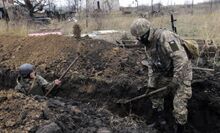
Ukrainian soldiers digging trenches against russian attacks. Source: Getty Images.
With both sides throwing in the bulk of their most destructive weapon systems, the fighting started to turn into a war of attrition, leading to enormous losses on both sides. With the battlefields being engulfed and devastated by exposions and terrible fire storms, those who survived the carnage would remember the Battle of Kaliningrad simply as "Kalinins Hellgate". After almost a month of brutal fighting, the Allies were forced to call off the attack. At this Point, the Battle of Kaliningrad was the worst Battle of the Western Front so far. The Allies realized that at this rate they wouldn't be able to stop the Revisionist Powers from overrunning Poland, forcing them to change their strategy completly. They started to dig in and fortify the entire Front, leading to a network of trenches, barricades and other fortifications along a line incoherently stretching from the Baltic Sea to Moldova. This was possible due to allied air supremacy and technological advantage, while Russia also fortified multiple of the conquered cities in Poland. The area between the lines became the battlefield of tank, infantry and artillery attacks, leading it to be nicknamed the "New No-Mans Land".
Slaughter in South Asia: the Indo-Pakistani Front
While China saw some success against India in the Himalaya, India itself was on the advance against its year long nemesis Pakistan, which was supported by the former soviet republics in central asia. Indian forces kept pushing through the Thar desert, but the harsh terrain lead Indias armored vehicles to break down , while the pakistani defenders used the wide landscape to their advantage, pursuing a guerilla tactic against the invading indians.
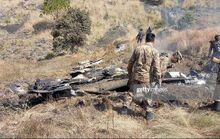
A shot down aircraft during hostilities in Kashmir. Source: Getty Images
At the same time, indian naval assets initiated several operations against pakistani forces, which were kept close to Pakistans shores, due to Indias far more superior fleet, while Pakistans batteries of modern anti-ship missiles kept the indian fleet at bay for as long as possible. On the ground, the war in South Asia saw only minor progress. The indian offensive through the Thar desert kept slowing dow, since the lack of infrastructure and the harsh conditions in the desert lead the armored vehicles to become increasingly inoperational in larger quantities, while the lack of natural obstacles, like trees, allowed the pakistani defenders to inflict somewhat greater casualties to the indians by using the more urbanized areas of this region on the pakistani side of the border as defences. Further south, the wetlands of the Indus Delta prevented any larger indian formation to cross significantly into Pakistan, leading to brutal guerilla warfare in the swamps. Due to the fact India kept harrassing Pakistans airfields and bases over the year with missile strikes, while overwhelming pakistani fighter jets with th quality and quantity of their airpower, India managed to neutralize the majority of Pakistans airforce as a threat until the end of 2022, leaving Pakistan to only perform occasional harrassassment strikes from bases further in the west.
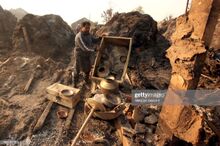
Indian local in the rubble of his home after shelling between indian and pakistani forces. Source: Getty Images
While the fighting in Kashmir was still in a deadlock due to the mountainous terrain in the north, the battle of Punjab intensified even more. After months of intense tank fighting, India managed to push through the flat spaces of Punjab into Pakistan, allowing it to take Lahore. This forced Pakistan to increase the defences around Islamabad significantly, since the pakistani capital was very close to the front in Kashmir. Chinese forces entering the battle through the chinese part of Kashmir managed to relieve a bit of pressure on Pakistan, but this wasn't enough to prevent the indians from further advancing into Punjab. The invasion of Pakistan created a rift between the pakistani military leadership and the government, since the generals threatend to use nuclear weapons if deemed necessary, even without authorization from the government.
2023
The Eastern Front: Chinas conquest continues
At the beginning of 2023, China occupied Taiwan, the Senkaku and Sushima Islands and taiwanese islands in the South China Sea. With the new year came a new wave of chinese offensives against allied Islands. Chinese missile strikes from the continent kept targeting japanese bases around Kyushu, allowing China to neutralize a large fraction of Japans anti-submarine Aircraft. This then lead to a increased numerical advantage of chinese submarines in the waters of the East China Sea, causing the majority of japanese submarines to be destroyed. While China used its submarines and naval missile and anti-aircraft assets to keep pressure on Japan around Kyushu, chinese troops in the South managed to use the conquered Senkaku and Sakashima islands as staging grounds for amphibious and airborne assaults against Okinawa.
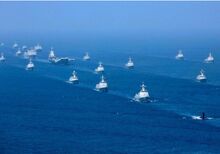
The chinese fleet in the South China Sea. Source: Getty Imagey
The months of continous missile strikes and the harrassassment of allied reinforcement routes allowed China to successfully overwhelm japanese and american forces on Okinawa, despite US air support. Since the supply lines of the Allies coming from Australia has been interrupted by the fighting between Australia and Indonesia, and reinforcements from japanese mainland are hindered by chinese forces in the East China Sea, China was able to use more of the taken territory to perform island hopping. As soon as chinese forces kept closing in on japanese mainland, the Islands taken from Japan weren't able to sustain enough forces to realistically threaten Kyushu. American forces coming from the Phillipines managed to slow down the chinese advance by inflicting heavy casualties on the invading forces from a distance. While the revisionist advance on the korean peninsula was slowed down due to the combined effort of american, south korean, japanese, british and australian troops, Seoul remained encircled and under siege as one of the last allied bastions in the north of South Korea. American bomber raids against chinese coastal targets came to an almost stand-still, since the continous attacks on allied bases in the Pacific and the newly deployed chinese anti-access defense systems on conquered islands heavyly disrupted the US-led approaches.
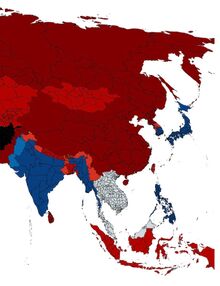
The Eastern Front at the beginning of 2023
Seeking a different strategy against China, the Allies attempted to increase their effort to strangle China econonomically by creating multiple naval blockades, since China was very reliant on marine trafficking. The indian navy, despite being in preparation of an amphibious invasion of Pakistan and probably also Sri Lanka, supported the allied blockades by sailing into the malaysian strait of the South China Sea, attempting to cutt of merchant shipping lines, while also increasing the pressure on the chinese navy. Since the indians had to cross larger distances to reach the more narrow waters of the strait, China managed to prepare an ambush against the indian navy with indonesian support, using their submarines and long range naval missiles to inflict damage to the approaching forces, although losing several vessels itself in the process, weakening its positions in the South China Sea. The fighting still caused a massive disruption of marine trading, leading to heavy tensions with the southeast-asian nations bordering the South China Sea. In Malaysia, Singapore and Vietnam voices became loud to stop the chinese expansionism in favor of the Allies, while those also increased the political pressure on Thailand and Brunei to join as well. In China itself, various protests of young chinese and the Uighur minority erupted around the date of the Tiananmen massacre, causing civil unrest and brutal countermeasures from the chinese security forces for the sake of "protecting the peace in China". Xi Jinping accused the Allies of orchestrating the riots in order to destabilize China, which was used as a justification for violence against the protesters. Hundreds of people where killed all over China during the riots, while many arrested Uighurs and regime-critics were transported into Chinese "reeducation camps", where they were tortured and forced into labor, while also many of them were executed right away. As an last attempt of diplomatic approach, the UN, which condemned the war since the beginning and deployed blue-helmets along all frontlines called for a meeting to seek a dialogue between the Allies and Revisionist Powers.
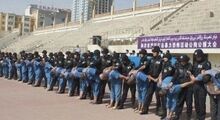
Uighur captives detained by chinese forces. Source: Change.org
While leaders of allied countries gathered in New York to attend the meeting, the Revisionist Powers, like China, Russia and Iran only dispatched a small entourage of diplomats, who arrived in New York under extremely high security measures, in order to avoid unnecessary escalation. While enormous protests of pro-allied and revisionist crowds emerged outside the UN building , inside the representatives of both sides used this opportunity to demonstrate their view of the war, blaming the other side, while claiming to act on a legitimate basis. Multiple non-politicians were invited as well, in order to show the suffering the war has caused. Soldiers who fought at the Battle of Kaliningrad delivered speeches that showed the perspective of the fighting troops of the conflict , while civilians from South Korea and refugees from Taiwan reported about the horrors the non-military population had to endure. Overall, the conference remained inconclusive despite both sides claiming they would want to try to seek a peaceful solution to the conflict. The UN would not gather again for the remainder of the war, while waring nations like the US, China and Russia even left the organization, causing the UN to ultimately crumble apart over the course of WW3.
The Western Front: War in the Balkans
At the Western Front, movements on both sides slowed down significantly after the bloody battle of Kaliningrad. The Allies kept digging in along the entire front, using razor-wires, trenches, anti-tank mines and severall Patriot and THAAD batteries delivered by the US to fortify their positions. The US also brought in waves of heavy firepower deliveries like M 134 Miniguns and Browning M2.50 Caliber heavy machine guns, that were used as stationary weapons to further prevent any more russian advances towards the west. All allied nations of Europe carried in their biggest artillery pieces, causing unprecedented destruction in the so called "No mans land", the battlefields between the fortifications and positions of both sides. The Allies were able to dig in due to their air supremacy, yet russian S-400 anti-air systems kept causing heavy casualties for the allied airforce, preventing any deeper incursions into occupied territories.
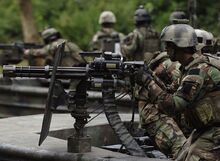
Allied soldiers with M134 Miniguns
Russia was also able to forsee the attack patterns of allied aircraft, especially the NATO F-35-Jets, because of the data it received through turkish S-400 deliveries, that were connected to NATO software by Turkey in 2019 and afterwards . In the North, Russia was still forced to take the defense in the norwegian territory around Murmansk, using mountainous terrain to fortify as well, while preventing allied advances towards its Nothern Fleet base by using cruise and standoff missiles, accompanied by shelling from the Barent Sea. In Finland, allied troops of Sweden, Norway, Finland, the UK and Canada managed to push the revisionist offensive into Lappland back around Inari, forcing Russia to increase its defenses at the nothern russo-finnish border. With the war raging from the Barent Sea to the Black Sea, tensions also started to rise in the Balkans as well. Since most balkan NATO-members were at least officially at war with the Revisionist Powers, and Serbia gravitating towards Russia, Kosovo felt right in its ambitions to build up its own army, in order to protect itself in the case that war breaks out in the Balkans too, especially since nations like Albania and Montenegro could've become targets of russian attacks. While Kosovo continued its efforts to have its own army as already declared and started in 2018, Albania supported this ambition, and offered to help Kosovo improving its relatively young armed forces.
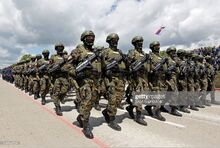
The serbian army at display. Source: Getty Images
Despite massive serbian protest, albanian soldiers entered Kosovo and started to train its people, while also bringing in weapons and ammunitions. Serbia, which still held a grudge against NATO for its bombing campaign during the Kosovo and Bosnia wars, demanded the albanian forces to leave Kosovo immediately, accusing Albania to pursuit a "Greater Albania" doctrine in Kosovo. Ethnic serbs in the North of Kosovo started to rally together and protest against the albanian military presence and the kosovian build up of forces. The heavy armed Kosovo police force took action against the protesters, and arrested dozens of serbs, leading Serbia to fully alert its armed forces and gather it along the nothern border of Kosovo. Serbian troops engaged in several border clashes with NATO peacekeeping forces stationed in Kosovo since the early 2000s, and as soon as the actions against ethnic serbian rallies lead to the first victims being killed in fights with the police and albanian forces, Serbia declared war on Kosovo and Albania, officially joining the Revisionist Powers in favor of Russia.
Palestine goes to War
At the Southern Front in 2023, the Allies enjoyed some success in their fight against Iran and its Allies and proxies. Clandestine special operation forces of the US inside Iran managed to destroy and sabotage key assets of the enemy, while also bringing allied insiders into safety outside of the islamist republic. Iran itself suffered from a depletion of ammunition stockpiles, even though Russia tried to hold up its supplies for its fellow Revisionist Power. The Allies on the other hand managed to use their advantage in the eastern Mediterranien to bring in more ressources to deal with the bulk of iranian, iraqi and syrian defences, while also supporting Israels effort against Lebanon and Hizbolah. The US brought increased numbers of Patriot missiles, HIMARS Rocket Systems and attack helicopters like the Apache that was already used at the Western Front. The iranian proxy forces in Syria and Iraq used explosively formed penetrators to deliver damage to american anti-IED assets on the battlefield, even though this wasn't enough to prevent US-special forces from targeting and neutralizing many of the underground bunkers, from where they received their supplies.
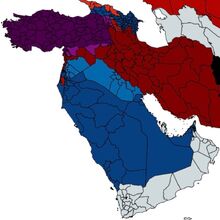
The Southern Front 2023
US B-52 stealth bombers, some of which were stationed in the region as early as 2019, were also used to circumvent iranian air-defences. Among these air defences were not only the iranian made Bavar 373 surface to air missiles, but also russian S-300 and S-400 sytems, which saw great success against allied airforces at the Western Front. In order to cope with these sytems, the Allies massively increased their sorty raids, leading to more than 1,500 strikes to be performed per day at the Southern Front. In the gulf, the US used airborne intelligence to detect enemy threats, since the nature of the strait gave the allied fleet only short warning time to react to attacks from enemy assets like Irans Ghadir-class minisubs. In order to deal with iranian anti-ship warfare in the Gulf, the US also brought in Rolling Airframe missiles, Evolved Sea-Sparrow missiles and standard missiles, that kept decimating Irans own cruise missile inventory. America deployed up to three carrier groups in the Region, although the continous battle in the Persian Gulf forced the majority of the fleet to operate from the Arabian Sea, targeting Irans southern coast off the shores of neutral Oman. Despite many iranian anti-ship batteries along the southern coast being destroyed, the US still lost one carrier in the process, rendering the revisionists in the Middle East a somewhat propaganda success. Futher to the West, the palestinian territories kept being entangled in the war. After the radical islamist Hamas pledged its alliance to Iran as early as 2022, both Israel and Hamas kept exchanging hostilitie, causing the latter to proclaim that it won't stop attacking Israel until it drops out of the war in favor of Iran, hoping that this could help Hamas to increase its pressure on Israel to push their own agenda.
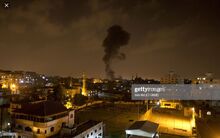
Israeli airstrike in Gaza. Source: Getty Images
After hundreds of iranian made missiles hit targtes all over western Israel, like Tel Aviv, dozens of israelis were killed since Israels Iron-Dome air-defences were worn out and depleted after almost 2 years of fighting. After a radical palestinian suicide attack in Jerusalem that killed another 100 israeli civillians, Israel decided to invade the Gaza Strip to wipe out Hamas. This caused a massive opposing reaction from the palestinian population, leading hundreds of protesters to gather at the border fences and fight against the invaders. Civillians threw rocks and used slingshots against the heavily armed israeli forces, while Hamas members used the crowds as himan shields and covers to fire at the israeli troops. This caused the israelis to take countermeasures, leding to exchanges of fire between the Hamas and the israeli forces between the protesters, which lead to the death of hundreds of palestinian civillians, exploited by Hamas and iranian propaganda.
The Eastern Front: Fighting in Southeast Asia
With fighting continuing in and around India, as well as Korea and the seas of Southeast Asia, more and more nations in the region became entangled in the war. After China invaded Bhutan and Myanmar in 2022, both nations kept on trying to push the chinese back into their territory. The US managed to land troops as reinforcements in India, along additional forces from Australia, and in smaller quantities the UK, France and New Zealand. While the majority of said troops took position against the chinese, and nepalese at the nothern borders of India, another contingent supported indian troops crossing into Myanmar against Chinas encircleing operation. China on the other hand used its political and economic leverage to convince its ally Laos to join the war on the revisionists side.
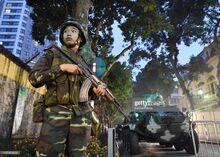
Vietnamese soldier in Hanoi. Source: Getty Images
Troops from Laos and China managed to take Taunggyi, while a push into Myitkyna could be halted. Vietnam suffered under the economic pressure it had to endure due to the battles in the South and East China Seas and the blockades both sides imposed against each other. With the regular supply lines from the sea therefore cutt, Vietnam was increasingly dependant on its alternative supply route between Hanoi and Ho Chi Minh, which was also heavily interrupted. Since Vietnam became continously weary of Chinas influence in the years before the war, while also significantly improving its relations with the US and the West as a whole, this lead more and more anti-chinese sentiments to become obvious in Vietnam. After China demanded Vietnam to let its troops enter its territory in order to keep encircling Myanmar and India, Vietnam, despite the protest of the remaining pro-chinese forces of its population, declared war on China and Laos. While chinese troops invaded Vietnam at the nothern border, the vietnamese airforce launched several strikes against the chinese cities of Geiju and Qinzhou. Since the majority of chinese anti-air defences were concentrated in the East and at the indo-chinese border, many of the airstrikes couldn't be intercepted, leading to the first hits on inner-chinese targets since the beginning of the war.
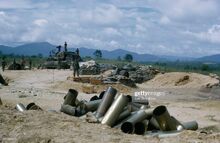
Vietnamese artillerymen after intense shelling. Source: Getty Images
The vietnamese navy on the other hand launched a series of hit and run raids against Hainan in the Gulf of Tonkin, while also attacking chinese vessels in the South China Sea in order to relieve pressure from the maritime trading lines. While vietnamese ships closed up with allied vessels in the South China Sea, ground troops were starting to invade Laos, threatening Attapeu in the South, and Sekong further North. Chinese troops battered their way through vietnamese border defences, leading the Vietnamese to engage in bloody guerilla warfare against the invaders, which caused staggering chinese casualties in the jungles of Vietnam. The ongoing fighting in southeast Asia and the Pacific forced other ASEAN nations to choose sides, in order to prevent being inactively entangled in the war. Pro chinese state Cambodia chosed to join the Revisionist Powers by declaring war against Vietnam, which on the other hand retaliated against cambodian incursions by invading its neighbour using its armored vehicles and larger number of infantry troops.
Struggle at the Indo-Pacific Front
While more and more nations of southeast Asia got entangled in the fighting between the Allies and the Revisionist Powers, the conflict in the Indo-Pacific saw no signs of easing either. Chinese submarines, now occasionally supported by their indonesian counterparts, kept attacking allied vessels and the remaining allied economic shipping lines, while also conducting some smaller missile strikes against the bases on the Mariana Islands, Guam, American Samoa and the Manus Island of Papua New Guinea. The attack on the latter, along with the fighting between Australia and New Guineas neighbour Indonesia lead the pacific island state to allow further allied military presence on its mainland for protection.
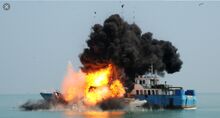
Indonesian navy destroying an malaysian fishing boat. Source: Getty Images
At the same time, Indonesia intensified its fight against west papuan freedom fighters, which it still believed were supported by the Allies, by using phosphorus bombs in West Papua. After the territory of New Guinea was caught in the crossfire of indonesian aggression, while there were also several incidents of indonesian jets entering new guinean airspace to target australian forces on Manus island, Papua New Guinea declared war against Indonesia. The naval war at the same time was also intensifying between the Allies and Indonesia, since the latter dispersed its entire fleet on a large front, effectivly cutting off East Timor, while also converting civillian airports on the Sumba, Flores, Sumbawa and Lombok islands, as well as West Timor to stage attacks against nothern coastal Australia. Australian intelligence noticed the preparations for the aerial campaign, leading to an early warning for the Allies, while the first wave of incoming indonesian attack surface vessels, was early on detected by Australias Jindalee OTH radars. Australian longe range airborne radar platforms then identified the attacking ships, some of which were armed with modern ASuW missiles, which were then attacked by australian submarines. Due to nummerical indonesian advantage, only the additional sea power of the US, Britain, New Zealand and Papua New Guinea prevented the bulk of Australias surface fleet to be decimated.Australia did manage to relocate most of its airbases further north during the last few years of the war, leading dozens of australian and other allied aircraft to always be available to prevent indonesian incursions.
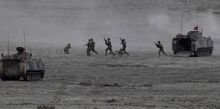
Australian forces in action. Source: Getty Images
Australian ships coming from the Butterworth base in Malaysia engaged in hostilities with indonesian and chinese naval forces in the Malacca strait, leading malaysian mainland close to Kuala Lumpur to be caught in the crossfire as well. The aggression in the Malacca strait, and the malaysian losses of trading and fishing ships due to indonesian and chinese attacks, forced Malaysia to join the allied war effort against the Revisionist Powers. Singapore, a traditional US ally saw the escalation in both the Pacific and southeast Asia with great concern, leading Singapore to also declare war on Indonesia and China. While the allied pressure on Indonesia therefore increased significantly, the island state still managed to take the small australian Christmas and Cocos Islands, featuring both long runways for potential airforce build up of the Revisionist Powers.
News from the South: Africa enters the War
The escalation in southeast Asia and the Indo-Pacific increased the economic pressure on both the Allies and the Revisionist Powers. With both sides imposing blockades against each other, while the most important maritime traffic routes have been disprupted, the beligerents were eager to find ways to replace the ressources missing, or other ways to relieve the pressure on them. The Revisionist Powers under China therefore encouraged their regional partners in Africa to take action against allied troops stationend on the continent and their ressources. At the same time, allied troops were making plans to secure the oilfields of North Africa, since the flow of middle eastern oil has been heavily disrupted by the war. Saudi Arabia, the UAE and Egypt therefore encouraged general Haftar and his forces in Libya to start new offensives against the opposing libyan government in the West, in order to further cutting it off from the oilfields in the North of the country.
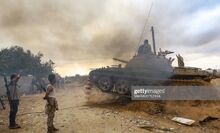
Anti-Haftar forces near Tripoli. Source: Getty Images
Since Egypt was heavyly reliant on subsidised oil from Libya after the First Gulf War, egyptian troops of el-Sisi joined Haftars attack and carried out airstrikes on libyan targets, while Haftars forces started to shell Tripoli once again like they did in 2019. Egypt justified this actions officially by using terrorist movements through its shared border with Libya as an excuse. The UAE and Saudi Arabia delivered weapons and financial ressources for Haftar, while the general also encouraged militias to participate in the conflict from the South. The libyan government condemned this act of aggression and therefore declared war on Haftars supporters Egypt, Saudi Arabia and the UAE. The US provided Haftar with diplomatic cover, after Saudi Arabia and Egypt lobbied over the years in his favor. Ironically, Haftar also enjoyed assistance from members of the russian paramilitary Wagner-Group, which provided support in form of aerial and artillery expertise. Turkey, as a supporter of the anti-Haftar factions in Libya also condemned the escalation in North Africa, and threatend to protect its interests in Libya with all means necessary, while Qatar, another supporter of the libyan government also declared it will not tolerate this kind of aggression, leading the gulf state to provide more financial aid for its libyan allies, which in return increased the tensions between Qatar and Saudi Arabia. Haftars forces, supported by the egyptian air force also increased their offensives towards Libyas coastline. The coalition of Haftars army, allied militias, tribal forces and egyptian troops launched new attacks on Sirte, Zintan and Nalut, while the march towards Tripoli was still bogged down. Many tribes in Libya also engaged on Haftars side against Tripoli, while receiving diplomatic goodwill from Tunisia, which seeked a Lybian-Lybian solution for the conflict and already supported many tribal leaders before the war, causing tensions with Tripoli. Turkish troops already deployed in Lybia took position around Tripoli and conducted several ground and drone operations against Haftars forces, while avoiding direct confrontation with Haftars backers for now. The UAE, as a important backer of Haftar, also conducted a series of airstrikes along its egyptian counterpart, using F-16 planes to target pro-governmental militias in the north of Libya. The Tripoli government on the other hand encouraged tubu tribe warriors in the south, as well as anti-Haftar chadian militias to operate against the generals coalition, leading to an increased influx of chadian rebels and extremists flooding through the southern border of Libya.
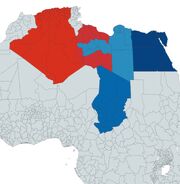
The emerging North Africa Front 2023.
Chad, which was engaged in clashes with the same rebels that were infiltrating Libya to fight Haftar, accused the government in Tripoli of supporting terrorists in the Sahel, heightening the tensions between those two north african nations as well. Turkey , which hoped to gain access to Libyas oilfields and hydrocarbone ressources in the Mediterranian as a mean to counter Egypt, Israel and Greece, delivered weapons and other hardware to the government of Tripoli, while its navy started to interfere with egyptian vessels delivering supplies for Haftar. The tensions caused between the Allies caused by this lead to the first demands by Saudi Arabia, Egypt and the UAE to dispand Turkey from the Allies, while stopping the support for Erdogans regime. The western Allies on the other hand were still reluctant to oppose Turkey, fearing it may stops fighting against Iraq and Syria, or maybe turning to the Revisionist Powers, unknowing that there was already a cooperation between the two sides. Algeria, which had deep ties with Revisionist Powers like Russia and China, also positioned itself against Haftar and his supporters in the wake of this new escalation, worrying about Libyas stabillity and the potential consequences a collapse of its neighbour, while falling under the influence of its rival Egypt. German naval forces, which were guarding the libyan coastline against illegal weapon shipments coming from sea, where attacked from the land and air, although it wasn’t clear which side was responsible for this.
The Western Front: Battle for No Mans Land
With the year nearing its end, both sides at the Western Front remained in a stalemate. Since winter was setting in, larger movements of heavy equipment became incresingly difficult, leading russian logistics to come close to the brink of collapse, due to Russias forces being overstreched from the Barent Sea all the way to the Black Sea. In the north, the Allies of Scandinavia, Britain and Canada tried to compensate for the deadlock by engaging in guerilla warfare against the russians. Similar to german shocktrooper tactics during WW1, and finish anti-soviet warfare during WW2, norwegian, swedish and finish troops used the remaining forests of nothern Scandinavia as cover in order to perform surprise raids against pockets of russian defences.
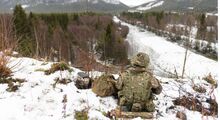
Soldier overlooking the area in Norway. Source: Getty Images.
The allied attack-forces were using new kinds of weapon sights, which combined thermal imaging and image intensifier sights for precision attacks. Since the russian troops where thinned out due to the large front Russia had to cover, this kind of guerilla warfare proved to be very effective against russian attempts to break the stalemate. Russia tried on the other hand to compensate for allied raids by executing Iskander missile strikes against the North Cape, which saw increased fortification as well. More missile strikes hit targets around Hammerfest, Alta and Kautokeino, further disrupting allied supply lines from Norway into Finland. The allied defenders were able to remain somewhat mobile though, using ski-mobiles, Viking armored ATVs, unarmored BV-206s and regular snowmobiles, which allowed the Allies to move in pace with their convois and attacking brigades. In order to protect the allied lines in Scandinavia, the Allies deployed multiple NASAMS air defence sytems, which were using american MPQ-64 Sentinel 3D radars to detect both russian aircraft and missiles, like the Buk-missile. Further south, both the Allies and the Revisionist Powers remained in a brutal fight for the so called "New No Mans Land" in Poland, Ukraine and the romanian-moldavian border. While the main front lines remained static, the killing fields between the trenches, barricades and other fortifications saw fierce tank and infantry battles, supported by heavy artillery fire and air-, as well as missile strikes.
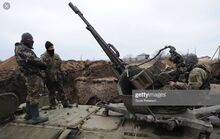
Anti-aircraft guns in a trench, aimed against the russian airforce. Source: Getty Images
Both sides created heavy guarded openings in their lines, to allow their tanks, mobile artillery pieces and their infantry to march towards the battlefield, while the defences were continously improved with anti-air defences and heavy firepower. The Allies lacked in the latter though, and were usually outgunned by the russians, due to the atrophy of allied artillery units during the years of the „War on Terror“. This lead among others the UK to use cluster missile munitions, to compensate for their lack of heavy firepower. While the Allies also counted on american made miniguns and Browing heavy machine guns, Russia deployed its PKM heavy machine guns, some of which were equipped with ammunition-feeding backpacks, called Scorpios, in order to use a portion of the guns as mobile weapons as well. Since boths sides dug in to hold their gains as long as possible, Russia had to bring in its bigger artillery pieces as well, in order to destroy allied fortified positions. Hundreds of russian 2C4 Tulip self-propelled 240 mm mortars were modernized and brought into service at the Western Front, creating worries of potential use of nuclear weaponery, since the 2C4 had a nuclear mission in the past during the First Cold War. Russia also deployed the TOS-1A Buratino, a thermobaric missile launcher dedicated to destroy heavyly fortified enemy positions through emitting flammable gas clouds that ignite the surrounding air. These weapons proved to be incredibly devastating on the battlefield, but due to their short range, they were suceptible to anti-Tank weaponry and allied counterfire. The russian lead revisionist forces knew that at this rate, a complete occupation of Poland and Finland would be impossible, leading Putin to change the focus of the european campaigns.
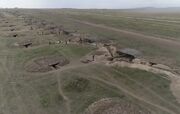
Russian artillery pieces in fortified positions. Source: YouTube
Instead of neutralizing NATO forces by occupying as much territory as possible, he wanted to force the Allies to reevaluate the effort the counteroffensives would take, meaning that the Revisionist Powers at the Western Front now followed a strategy of attrition. They thought if they can hold on their gains, while inflicting heavy damage and casualties on the Allies, they would be able to grind the enemies forces down. Russian and bellorussian armored units also utilized a strategy nicknamed „tank-carrousels“, where tanks and self-propelled artillery pieces shell enemy positions, while being in continuous movement between two specialized trenches, in order to avoid enemy counter-fire. Fighting intensified between both sides around Lodz, russian occupied Lublin, and the crosssection between the polish and the ukrainian sector, close to the slovakian border. A russian and bellorussian offensive geared towards Rzesów and Prömsel was slowed down by allied F-16 Fighting Falcon airstrikes, while german PzH 2000 self-propelled howitzers enabled the Allies to counteract the revisionist attacks through Time on Target barrages.
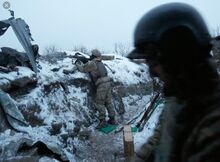
Rifleman position in a trench during winter. Source: Getty Images
At the same time, slovakian troops increased their reinforcements for the crosssection, supporting ukrainian, french, german, italian, greek, spanish, portuguese and romanian troops around Stryy, Ivano-Frankivs'k, as well as Chernovtsy. The russians, supported by their allies from Belarus and forced conscripts from the central asian republics, tried to prevent the allied attempt to break through the crosssection, by starting attack waves of Su-27 flanker family aircraft, aiming at diminishing allied air superiority. Those air raids were supported on the other hand by russian made S-400 surface to air missiles, leading to heavy losses for the Allies in the skies over Ukraine and southeastern Poland. The combination of flanker airstrikes, Iskander and S-400 missiles lead to allied troops losing air cover in the crosssection, which allowed the Revisionist Powers to improve their defences in Ukraine and Moldova. Russian movements in southwestern Ukraine remained in a halt though, since neither side was able to break through the enemies defences at the border of the now frozen swamplands of the Danube Delta. Revisionist artillery in Moldova, supported by transnistrian militias and the russian airforce started to shell Galati, Braila and Tulcea, in order to disrupt allied supply lines at the Black Sea coast. The russian Black Sea fleet played rather defensively, staying close to the ukrainian coastline around Crimea, while conducting several missile attacks against romanian targets. In the Balkans, the conflict between Serbia, Kosovo and Albania kept on escalating as well. With the serbian army entering the north of Kosovo, Albania felt fully justified to fully mobilize its army, while sending it into Kosovo to fight against the serbs. Serbian artillery and airstrikes managed to disperse the resistance in a way, that allowed the army to threaten Pristina while also slowing the albanian reinforcements down.
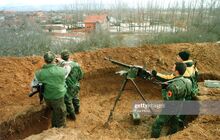
Forces of Kosovo monitoring the serbian lines close to Pristina. Source: Getty Images
The ongoing war between Serbia and Albania inflamed tensions in Bosnia and Herzegowina anew, leading to massive pro-serbian protests in the serbian-dominated Republika Srpska. The new Balkan war lead the people of Republika Srpska to feel justified in their attempts to form an auxiliary and militarised force, while stressing that the dissolution of Bosnia is due. Bosnia, which was already officially at war with Russia, although staying inactive, felt that these protests and the following violent clashes against bosnian security forces were supported by both Serbia and Russia, and after intelligence reports became public that Republika Srpska talked with Serbia about a possible serbian presence on bosnian territory, Bosnia and Herzegowina declared war on Serbia. With fellow NATO member Albania fighting against a revisionist partner, both Montenegro and Croatia decided to declare war on Serbia, while sending their first expeditionary forces towards their respective borders with Serbia. At the same time, the Allies in Europe came together and initiated a wide series of joint programs for the development of new weapons, aircraft, tanks and other systems, in order to deal with this kind of warfare against the Revisionist Powers.
2024
The fight for dominance in Africa
Since the escalation of conflict in Libya continued at the beginning of 2024, tensions in northern Africa started to boil up even more. The allied backed forces of general Haftar saw a series of victories, in form of successfully taking Zintan and Sirte, allowing them to close a corridor between government controlled areas between the Nalut and Al-Jabal Al-Gharbi region. The ongoing and ever increasing offensives of Haftar and his allies lead to a new wave of refugees trying to seek shelter in Algeria and Tunisia, while migrants from the Sahel faced heavy struggles to reach Libya and its coastline due to the escalating fighting. This new refugee crisis intensified the tensions between Algeria and Haftars coalition, since the north african state tried for months to mediate between both parties in favor of the originally UN backed government of Tripoli.
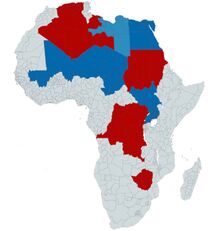
The african theater of the war at the beginning of 2024
France on the other hand deployed new forces in Libya, in order to secure lybian oil and the southern mediterranien coastline. This deployment signaled open french support for Haftar, as well as allied willingness to defend its interests in Africa as well, which was supposed to deter potential revisionist aggression on the continent. But despite this intention, the increased allied activity in North Africa lead to revisionist approaches of their own, especially towards Sudan, Zimbabwe and the D.R. Congo. China offered those nations to cut their debts it already in the past to pressure its will on Africas nations, in exchange for military support against allied troops stationed in Africa. China planned to use these african regimes as a distraction, in order to tie down allied forces that could've been redeployed at the main frontlines. Pressured by their debt towards China, while also receiving promises of economic benefits after the war, Sudan, the D. R. Congo and Zimbabwe started to attack neighbouring countries with a western military presence. This lead to sudanese attacks being carried out towards Chad and South Sudan, while Congo also attacked Uganda. American troops stationed in Congo has been captured as soon as hostllities broke out, although the few remaining forces in South Sudan joined the fight against its nothern and southern neighbours. As a result of the escalation, both Chad and Uganda declared war against the attackers, while France and the UK also declared war against the D.R. C. and Sudan due to their ties with the attacked african nations.
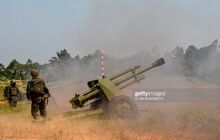
Congolese artillery in action. Source: Getty Images
Meanwhile in the north, the ongoing operations of Haftar and his supportive coalition lead to once again condemnation from Algeria, and after shells fired from pro-Haftar forces accidentally hit algerian territory, Algeria decided to intervene on Tripolis behalf. The algerian airforce attacked allied targets besieging the areas around Tripoli, while algerian ground troops engaged in first battles with the coalition around Ubari. After Algerias entrance into the war, and the attacks against allied troops conducted by the Revisionist Powers, the Allies pressured their partner nations of Mali and Niger to declare war against the Revisionists, since both of them hosted allied troops, while also harboring important natural ressources. Chadian and allied troops halted the offensive coming from Sudan, while reinforcements from Mali and Niger started to pour into the Sahel country.At the same time, the Allies demanded that Algeria should stop its intervention in Libya, which was rejected by the algerian government. Algeria on the other hand wanted the allied support for Haftar to be halted. Since both sides rejected each others demands, allied troops from Mali, Niger and Chad started to attack algerian forces in Libya and along their respective borders.
The Eastern Front: The Bloodshed of the ASEANs
While another continent was now entangled in the war as well, the conflict in Southeast-Asia escalated even more. The vietnamese attack along the chinese border came to a halt, and after massive air strike and missile attack campaigns, the chinese, taking advantage from its by now mobilized population, launched a counteroffensive into nothern Vietnam, creating a corridor towards its ally Laos. Further south, the vietnamese incursions into Laos proved to be successful, leading vietnamese infantry formations to close in towards the Xekong river, taking Ban Bak, Chevan and the outskirts of Attapu. Cambodia, which joined the Revisionist Powers in favor of China launched a series of attacks into southwestern Vietnam of its own. But after a day of intense shelling, the cambodians were forced to retreat, allowing the vietnamese to push into Cambodia as well.

Cambodian troops in the jungle. Source: Getty Images
The first wave of attacks were targeting Svay Rieng and Prey Veng, while the vietnamese army was also able to push into Cambodias southwestern flank with the help of its superior navy. As a result, the vietnamese were able to take Kampot, Sihanoukville and Koh Kong. Meanwhile, the chinese invasion of Myanmar came to a halt around Taunggyi and Naungpate, due to indian and american troops entering Myanmar as reinforcements. The americans were able to convince India to station troops in its territory, in order to stop the chinese advance into India and Southeast-Asia. In exchange, the americans agreed to help India against Pakistan, while also refraining from calls that India should join the fight against its close partner Russia. While Australia as a member of the so called "Quad" also started talks with India for troop deployment in Southeast-Asia, the indian navy engaged with its malaysian counterpart in smaller skirmishes with the indonesians, as part of an attempt to clear a path to the South China Sea through the Malakka strait, while also securing the Andaman sea for the Allies. The Kingdom of Thailand, being wedged between the waring nations found itself struggeling to maintain its neutrality. While both the allied and revisionist armies were engaging in brutal jungle warfare against each other around Thailand, the thai economy was facing a total collapse due to both allied and revisionist blockades, while the fighting in Asia and the Pacific lead to a complete breakdown of the tourism industry. Since Thailand was a major Non-NATO-ally, and was conneted to the US through long lasting defense treaties, Thailand saw no choice but to join the war on the allied side, declaring war against Laos and Cambodia, while still being hesitant to to do so against China. The thai army decided to support the vietnamese offensive against Cambodia, by pushing towards the western cambodian cities of Battambang, Sisophon and Samraong, stopping around the Tonle Sap lake area. The thai forces also simultaniously launched a invasion into Laos, taking Pak Lai and even overrunning the lao capital of Vientiane, forcing its leadership to escape to Luang Prabang.
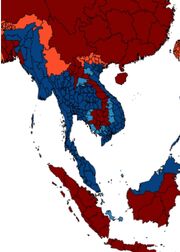
The Front of Southeast-Asia
With an increasing number of armies fighting each other in the jungles of Southeast-Asia, both sides started to engage in bloody guerilla warfare against each other, mimicking the carnages of the Vietnam-War. The fighting nationas tried to blend into their environment and the local population, while conducting a series of hit-and-run-raids against the respective advancing enemy, in order to inflict massive casualties and disrupt the supply lines of larger unprotected army formations. As a result, casualties on both sides mounted rapidly, leading to an increased domestic outcry against the military operations in Southeast-Asia. The vietnamese, but also the cambodians and laotians resorted to arming civillians and turning them into militias against the chinese and Allies respectively. As a result of this kind of guerilla warfare, both sides started military operations against insurgencies in civillian areas, leading to several massacres against the population, especially in nothern Vietnam. In the meantime at sea, naval forces from India, Malyasia and Singapore were able to occupy the indonesian islands of Banka-Belitung and Natuna Besar after the Battle of the Natuna Sea.
The Southern Front: Advance of the Allies
While the Allies were still caught in a stalemate in Europe,as well as being unable to break through the chinese defences at the Eastern Front, they actually saw more success in the Middle East. After years of relentless fighting and aerial bombardement, the Battle of Beirut lead to a clear israeli victory, leaving Lebanon as one of the first revisionist countries to mostly come under allied occupation. But the victory wasn't total. Hizbollah still engaged in urban warfare in several pockets of resistance all over Lebanon, while still firing salvos of missiles into Israel as a terror campaign. Since the years of fighting diminished Hizbollahs arsenal, while disrupting its iranian supply lines in Syria and Iraq, the shia militia faced increased material shortages, rendering its terror attacks mostly symbolic in nature. In Syria, the pressure on Damascus remained high, even though the usage of chemical weapons during the siege of the city lead to thousands of allied and civillian casualties.
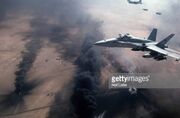
US planes over Iraq. Source: Getty Images
The Syria campaign of the allied-arab coalition achieved a series of strategic victories, in form of cutting of the influx of iranian fighters coming to Syria through Iraq, leading the iranian forces there to be mostly isolated from their reinforcements. Allied troops were even able to push as far North as Dayr Az Zawr, where their advance was halted by the presence of turkish forces. Turkey was able to conquer the majority of Syrias kurdish areas, leading thousands of civillians to be either displaced or killed. The last resistance of the SDF and YPG retreated into the now allied controlled Dayr As Zawr region, leading to the first negotiations with western allied forces for peace and protection. Any remaining kurdish resistance in the turkish occupied territories, armed or unarmed, were struck down with brute force, leading to several accusations of deliberate massacres against civillians. In Iraq, the Revisionist Powers faced even more setbacks. Allied troops were able to close in to the now fortified iranian border, after the Battle of Basra. This allied advance forced the revisionists to mostly retreat behind the Euphrates, Shatt al Arab and Tigris rivers, while also fortifying Al Kut and Baghdad. After keeping the majority of its naval assets in a safe distance in the Arabian Sea, the US decided to more offensively support their ships that were already in the Gulf of Oman following some breakthroughs in the Strait of Hormuz. The iranians used their Khalij Fars anti-ship missiles to inflict as much damage as possible to the incoming waves of US vessels, while the americans started a more aggressive bombing campaign not only against revisionist targets along the frontline, but also against targets in Iran itself.
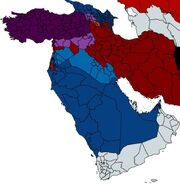
The Southern Front 2024.
The US used the british base of Diego Garcia to launch bomber strikes against iranian targets, while american Superhornet jets took off from the only 2 aircraft carriers in the Arabian Sea. The iranian targets hit included Bandar Lengeh, Minab, Buscher and Borazjan, while the iranians themselves were able to use their air defences to nibble away at the US jet fleet. The lack of sufficient numbers of SAM sytems, as well as american edge in jamming technology lead to the neutralization of a large fraction of Irans anti-air defences, leading to secret talks between russian and iranian officials about Iran possibly aquiring the russian made S-400 system, that was already been used by Turkey, while also negotiating the purchase of Russias newer S-500 sytem. The barrages of allied missile strikes, mostly using Tomahawks and similar weapons, lead to the majority of iranian surface vessels in the gulf being destroyed, forcing the remaining ships to take a defensive stand around iranian islands in the strait of Hormuz. In the meantime, the iranian proxy forces of the Houthi-rebels in Yemen managed to tie down relatively large formations of saudi forces, slowing down Saudi Arabias progress at the front, while also futher disrupting the saudi flow of oil through the Red Sea. This ongoing assaults lead the saudis to demand more support from the US against the yemeni rebels, which was met with heavy resistance from the american congress, since Saudi Arabias Yemen-campaign was a source of grave criticism in America, even before WW3 broke out.

Turkish forces overlooking a anti-kurdish offensive. Source: Getty Images
At the same time, Israel increased its air-, and missile strikes against targets and Gaza, while also sending in ground forces into the West Bank, to prevent additional palestinian insurgencies and terror attacks. Meanwhile in the Caucasus, most of Armenia was already occupied by the turkish army, leaving only a small pocket of armenian resistance in Nakhchivan, which was still held by armenian forces throughout the last years of the war. While the azeris, who were able to fully consolidate their gains in Nagorno-Karabakh, started negotiations with Turkey about how much armenian territory should go to Azerbaijan, Iran made an agreement with the turks to stop any agression against Azerbaijan, in order to have more ressources for its fight against the Allies at the Southern Front, now that Lebanon collapsed. The remaining russian troops in Armenia, which were already unharmed throughout the Caucasus campaign due to the turkish-revisionist collaboration pact, were called back to Russia in oder to be used as reinforcements along the Western Front, as well as expeditionary forces for a potential arctic offensives sheduled for later the same year. The russians retreated through Nakhchivan into Iran, and were brought to Russia with the help of the Caspian Fleet. The russian retreat was seen as an act of treason by the armenians, who were left behind to fight the turks on their own. Civil resistance, as well as armenian guerilla insurgencies against the turkish invaders lead to several massacres against armenian civillians, for which both sides blame each other. The armenians used these incidents for propaganda, comparing the massacres with the Armenian Genocide.
The Western Front: Europes fight for Unity
At the Western Front, both sides remained largely in a stalemate. The thousands of casualties, and the lack of of any significant gains lead to growing opposition against the war overall. Europes capitals were haunted by increasing numbers of anti-war protests, some of which became noticeably critical against NATO and the american war effort, despite only a relatively small american presence in Europe. Passive NATO member Hungary under Right-Wing leader Viktor Orban offered to mediate between Russia and the european Allies, as some form of diplomatic effort. Italys Lega party also offered to send a delegation to Moscow, in order to mediate potential peace offers. In the same time, revisionist forces struggled to man the entire frontline because of the length of the battlefield. Logistics proved to be a fragile area for the russians, leading to shortages of supplies at various sectors of the front. In order to relieve pressure on its forces, Russia once again resorted to a terror campaign, to break the already wavering will of the Allies.
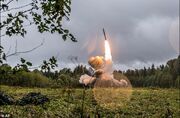
Russian Iskander missile being fired. Source: AP
The Revisionists sourrounding Russia fired salvos of Iskander missiles against european targets, mostly of civillian nature,creating chaos and confusion among the european population. Especially allied capitals were heavily hit, while additionally a lot of rail and road infrastructure was destroyed as well, in order to cut off european supply lines. Russia also tried to intimidate the US by putting its newer weapons at display, leading Russia to deploy its young Avantgarde hypersonic missiles against the capitals of France and the UK, which was the first time during WW3 that mainland british and french targtes were hit. Russia therefore tried to demonstrate that it was able to penetrate even the defences of other nuclear powers. The hypersonic missile strikes remained very limited though, because Russia didn't want to waste too many Avantgardes for conventional attacks, while also preventing the provocation of a possible nuclear counterattack from the french or british. The hungarian delegation of Orban in the meantime returned from talks with russian officials, but instead of pushing for a peace treaty under european conditions, they publicly advocated for peace in russian favor, calling it a "peace of understanding and common interests". Right-wing conservative leaders and politicians all over Europe soon adapted this standpoint, leading representatives from Italy, Greece and the already passive NATO members of Bulgaria, the Czech Republic, North Macedonia and Hungary to advocate for peace under the current conditions from Russia. They justified this move by declaring that the war was largely the fault of China and the US, and that Russia simply defended its own security interests, referring to NATOs eastwards expansion as justification. At the same time, the italians, who became quite sympathetic of the Revisionist Powers in the past because of their support during the Covid-19 pandemic, stopped fighting and remained only defensive in their actions. Other political parties in countries like France and Germany also joined this chorus, meaning that representatives from the french Rassemblement Nationale and the german AfD party proclaimed that peace with Russia would be vital for Europes survival, while blaiming the war on globalists and liberalism.
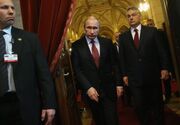
Viktor Orban meeting russian president Putin. Source: Getty Images
While right-wing fractions all over Europe received positive feedback from their followers, there were also massive backlashes because of this. New protests emerged alongside the already existing pazifist demonstrations,that critized the Russia-sympathizers, leading to additional chaos and civil unrest on the continent. The allied leadership in Europe also massively critized the voices calling for peace in russian favor, leading to heated political discussions, changes of personnel and even investigations. Some of these investigations, that were described by their targets as "conspiracys" against peace, found evidence of collusion between Russia and right-wing politicians from various nations. One of these investigations lead to the revelation after the war, that Viktor Orban and his associates received offers during their meetings in Moscow of potentially getting ethnic hungarian territory in Ukraine and Romania, in exchange for pro-russian diplomacy and neutrality in the conflict. These political squabbles lead to disunity amongst the Allies, and therefore a slowdown of their overall war effort at the Western Front. At the same Time, a series of terror attacks in Ireland and Nothern Ireland occured, all of which were claimed by the so called "New IRA", which already conducted terror attacks on the irish island in the years before the Brexit of 2020/2021. Originally, the New IRA was mostly insignificant in Nothern Ireland, but british security agencies noticed increased russian efforts to support and encourage these IRA dissidents, in order to drag the attention of the UK away from the battlefield.
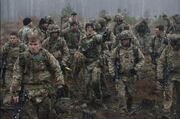
European NATO troops in the field. Source: Getty Images
Multiple car bombs were detonated in front of british security targets, like police stations, and new military sites that were opened because of the world war. Bomb attacks were also conducted against targets in Great Britain, and even though the New IRA took responsibility for these attacks, the british secret service suspected that these attacks were rather committed by russian sleeper agents, in order to inflame conflict with the irish terrorists. Nonetheless, the UK decided to increase its security efforts in Nothern Ireland, leading to the deployment of a token force of a few hundred soldiers in Belfast, as well as a dozen soldiers in Londonderry, where the attacks occurred more frequently. During this period of struggles, another tragedy hit the UK admist the crisis: Queen Elizabeth II died at age 98 due to the consequences of pneumonia, leaving the Kingdom asking who will take the throne. Prince Charles, knowing about his low popularity as well as Britains desire for a fresh leadership,stepped down as a heir of the throne in favor of his older son William, making him King. While the european allies struggled to mantain their unity and focused attention, the war at the Balkan Front was still in movement. Serbia fully invaded the now rogue bosnian territory of Republika Srpska, in support of local ethnic serbs, while also attempting to outflank both Croatia and Montenegro. This lead to the Battle of Sarajevo, where the bosnians lost to the nummerically superior serbs, allowing those to secure their positions in Bosnia and Herzegowina, while also shelling the croatian and montenergian borders respectively.
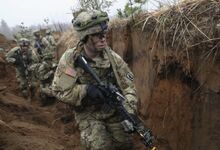
US troops in a trench in Eastern Europe. Source: Getty Images
The first Battle in Pristina also ended in serbian victory, forcing the kosovarians to retreat to a line from Pejë to Gjilan. NATO aircraft launched from Montenegro started to strike targets in Serbia, including Novi Pazar, while Sombor and Apatin were hit by croatian airstrikes. After the initial air-campaign, the Allies launched their invasion of Serbia, which lead the latter mentioned border cities to be taken by croatian and slovenian troops, which were supported by italian reinforcements. Romania also initiated an offensive against Serbia, leading to air-raids not only against the romanian-serbian border, but also Belgrade itself. The romanians received reinforcements from Slovakia, France and to a lower extent the UK, while the pressure on Hungary and Bulgaria to join the Balkan campaign increased. Greece also joined the coalition against Serbia, leading greek troops to join their albanian counterparts in Kosovo despite souring relationships between Greece and Albania. Even though Serbia was under pressure from multiple fronts, it was still able to inflict casualties on the allied airforce, due to its purchase of russian S-400 air defenses. Meanwhile, the Allies at the Western Front saw themselves forced to prepare for the worst, meaning a potential russian breakthrough and advance towards the german border, leading them to extensively fortify the polish-german border as a last line of defense. This heavy defended line was nicknamed as the „Merkel -Line“, meant as a mockery reminiscent of the Hindenburg-, and Siegfried-Lines of the germans during the last world wars.
The Arctic War begins
Since Russia was facing more and more pressure due to the stalemate at the Western Front, and first failures at the Southern Front, Vladimir Putin was looking for ways to distract the Allies, while cutting off potential ressources for Russias enemies. As a result, the russians decided to start a campaign in the Arctic, which was rich in ressources and close to allied nations like the US and Canada. While the americans stationed almost all of their naval forces in the Pacific close to the Eastern Front, the Allies of Europe kept their vessels in the North and Baltic Sea, while also guarding the Medditeranian, meaning the waters of the Arctic were almost defenseless due to the lack of naval assets. Russia, which already occupied the norwegian island of Svalbard, exploited this by sending ten submarines of its Nothern Fleet east of Bear island into the Greenland Sea.
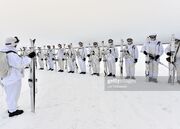
Russian arctic mechanized infantry brigades. Source: Getty Images
Six of those submarines belonged to Russias Akuta class, and where used to deliver big payloads of cruise missiles to the american Thule base in Greenland.The attack took out an important missile-warning system of the US, while the few danish vessels present in the Sea of Greenland were destroyed by the submarines as well. These ships conducted coastguard missions, and their destruction, as well as the attack on Greenland overall forced the danes to take a more aggresive approach against Russia. Royal danish troops from mainland Denmark, as well as conscripts from the Faroe islands were mobilzed in order to be send to Greenland. With no considerable military forces present to oppose them, russian special forces were landed on Greenland, leading to concerns about potential operations against continental North America.The Joint Arctic Command of Greenland, Denmark and the Faroe Islands therefore received support not only by Denmarks neighbour Norway, but also Canada. Canadian ground troops were landed in the west of Greenland, while squadrons of the Canadian Royal Airforce were launched from the Alert airbase in the far north of the country. Russia responded to that by launching its own squadrons of MiG-31 interceptors and Tu-95, as well as Tu-142 bombers from bases in Svalbard and the russian Nagurskoye airbase. The russian planes were able to intercept most of the canadian planes, while still suffering casualties as well. When the canadian airforce retreated back to its own airspace, Russias Tu-95 bombers attacked the canadian Alert airbase, completely destroying it in the process. On the ground in Greenland, the danish Slædepatruljen SIRIUS elite navy unit was the only military resistance that faced the landed russian Spetsnaz special forces.
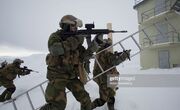
Norwegian forces attacking an arctic outpost. Source: Getty Images
Since this danish unit only consisted of 14 soldiers on dogsleds, who were armed with WW1 type M1917 Enfield rifles, they were forced into a quick retreat, but put up a very fierce fight against the russians, which was compared by allied propaganda with the last stand of Leonidas‘ 300 spartans during the Persian Wars. The Spetsnaz forces tried to gain hold of the artic inaccessible area, while trying to disrupt Greenlands communication with the outside world. The US saw itself forced to react to this escalation in the Arctic as well, leading it send the 24th Marine Expeditionary Unit to Iceland, in orderte prepare for counteroffensives with their danish, canadian, swedish, finnish and norwegian counterparts. The troops were then flown from ships with the Iwo Jima Amphibious Ready Group, in order to set up safe landing zones in the south of Greenland. Being faced with a now better equipped and nummerical superior enemy, Russia decided to call off the Greenland assault in favor of a upcoming arctic campaign in the East. The landed russian special forces retreated with the help of russian submarines coming from Svalbard, and left without suffering one casualty. Before they left, the Spetsnaz prepared various traps for the incoming Allies, leading to some military and civillian victims in Greenland.
Trouble in India
Since the war in Asia kept escalating as well, India saw itself confronted with a multitude of challenges, streching from the indo-pakistani front, over the Himalaya, Bangladesh,Southeast-Asia and the Indian Ocean. While India received more reinforcements from the US and Australia in order to fight against China, indian forces managed to push back against bangladeshi incursions in the Bengal region. Bangladeshi forces secretly supplied heavy weaponry to secessionist insurgencies in Nagaland, Sikkim, Tripura, Mizoram and in part even Jammu-Kasmir, leading to guerilla campaigns in inaccessible areas like waterways, jungles and high hill tracks. This bangladeshi guerilla campaign also included a large series of suicide attacks against most of Indias large cities, like New Dehli and Mumbai, while Pakistan also initiated djihadi suicide attacks against indian targets. Despite these terror strategies, India managed to destroy all of Bangladeshs naval forces, and the majority of Pakistans navy. Indian naval and airforces also neutralized the chinese naval base in Bangladesh, which was part of China’s Belt and Road initiative, while a couple of chinese ships managed to escape towards Djibouti and later on Madagascar.
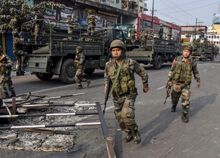
Indian soldiers patrolling cities. Source: Getty Images
While the indian army pushed through the wetlands of the Indus-delta towards Karachi, the last batteries of Pakistans anti-ship missiles were finally destroyed, leading India, to prepare a amphibious invasion of southern Pakistan. The Battle of Punjab became stagnant though, since pakistani, and central asian forces managed to turn the urbanized areas of the region into tripwires for the advancing enemies through resorting to urban warfare. Following the bloody Battle of Karachi, the indian army, supported by american and australian special forces, managed to consolidate its gains in southern Pakistan. With India advancing on almost all sides, Pakistans top generals asked increasingly for nuclear release, but were denied by Islamabad. The Kashmir campaign remained in a deadlock though, since India had to face not only the pakistani army, but also the combined forces of chinese and central asian troops. The indian approach was also slowed down by muslim protestors rioting against the advancing soldiers. These riots, along with the increasing number of suicidal attacks lead to a violent indian crackdown against muslim protestors in all of India. Several hundred civillians were killed during these uprisings, causing accusations of human rights violations and an massive outcry in the muslim world. The RSS, a paramilitary branch of Narendra Modis leading party, committed several acts of violence against muslims all over the nation, while thousands of muslims ended up being imprisoned in Indian detention camps, specifically build for the detention of muslims and other non-hindu minorities. Many leading political figures of Modis party openly rallied against muslims and categorized them as threats and „traitors“, leading the RSS to receive a wide array of authorizations, including a greenlight for violence, if it was, quote „necessary for the security of the Indian people“.
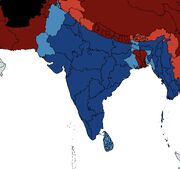
The Indian Front 2024
While most allied nations remained silent on this issue, Turkey issued a severe warning against India that it would cut back on its economic relations if India doesn’t stop its anti-muslim actions. Turkey also greenlighted „humanitarian aid“ for Pakistan, explaining that this was supposed to help the pakistani civillian population. India on the other hand accused Turkey of using this aid as an disguise to bring in military support for Pakistan. In the same time in the Indian Ocean, Sri Lanka, which faced almost a year of naval blockade, surrendered to India, leading to an occupation of the island. Many sri lankians opposed this surrender , and resisted the occupying indian forces. This caused additional crackdowns on sri lankian rioters, while many people of Sri Lanka suffered from malnutrition and disease because of the naval blockade prior. Despite the increased guerilla effort of Bangladesh, India managed to not only retake the West Bengal region, but also Chittagong in Bangladeshs East, cutting it of from chinese supplies coming from Sikkim. India planned to use this advance to drive a wedge between Nepal and Bhutan, while hoping to liberate the latter from chinese occupation. The chinese tried to react to these indian gains by deploying long range missiles against several metropoles, that were already under attack by pakistani and bangladeshi suicide attacks, in order to create chaos and confusion. This was an attempt to drive Indias attention away from from the nothern part the front, although China avoided attacking New Delhi, because it feared that any conventional missile attack on Indias capital could be mistaken for nuclear strikes. These missile strikes on the other hand remained limited in their scope, because its arsenal suffered shortage, while Chinas main focus remained on the Pacific.
The African Front: the East Africa campaign
In Africa, both the Allies and Revisionist Powers kept competing with each other for ressources and influence on the continent. While North Africa was already engulfed in a full blown conflict, other fronts emerged as well. In eastern Africa, the D.R.C was entangled in a war with Uganda, because of Ugandas american military presence. Congolese troops were also fighting forces in South Sudan in support of fellow revisionist co-belligerent Sudan. Despite fighting South Sudan in the South, and allied forces in Chad in the West, the sudanese regime also opened a front in the East against Ethiopia in order to cut off allied supplies of gold, in order to weaken the financial ressources of the Allies, while also targeting US troops in Ethiopia. Ethiopia therefore declared war on Sudan, and received military support from american and british forces. At the Horn of Africa, the Allies and Revisionist Powers tried to secure access to the Red Sea, in order to protect this vital vein of global maritime traffic.
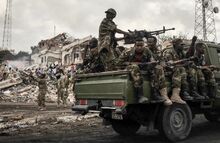
Somalian troops in Mogadishu after an explosion. Source: Getty Images
China engaged in secret talks with both Eritrea and Somalia, using their huge debts as leverage to pressure them to join the revisionist cause. Meanwhile, the Allies decided to counter chinese influence at the Horn of Africa, leading to an preemptive offensive against the chinese in the geopolitical important located nation of Djibouti, which hosted a plethora of foreign bases. This was the reason why the First Battle of Djibouti saw not only american, but also french, spanish, german and japanese troops fightin against the forces in Chinas only foreign military base. The djibouti government remained inactive though, since it was very dependent on chinese money as well, while the italians also remained rather passive, due to the increased ties between Italies right-wing government and China following the Belt-and Road initiative before the war. The saudi forces in Djibouti also remained neutral due to the close economic relationship between Saudi Arabia and China. After a week of siege and aerial and naval bombardment, the chinese in Djibouti were defeated by the Allies. This defeat caused the chinese to once again pressure Djiboutis neighbors to take action again the Allies, in order to deny their access to the Red Sea. China invoked Eritreas grudges against former enemy Ethiopia, as well as territorial conflicts with Djibouti, while also promising economic benefits and a cut down of debts. Somalia was persuaded by targeting its growing anti-american sentiment due to years of indiscriminate drone strikes performed by the US. This lead both Eritrea and Somalia to attack allied forces either in neighboring countries or inside their own territory. Eritrean forces engaged in bloody fighting against Ethiopia as well as Djibouti, where the Allies dug in after the chinese defeat. Somalia on the other hand tried to seize US assets and forces inside its own borders, while also attacking disputed areas in the self-declared state of Somaliland.
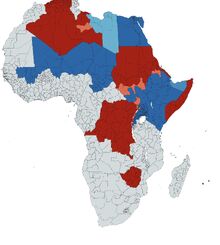
The African theatre later in 2024
Troops of the U.A.E. evacuated back to the Arabian Peninsula, causing critique from its western allies. Forces of Israel in Eritrea also retreated through the Suez Canal, while turkish forces in Somalia staye in the country whilst remaining neutral. This lack of support lead to massive tension between the US and Turkey, leading the americans to partially stop weapon sales into Turkey, while questioning Turkeys loyalty openly for the first time in the conflict. Somalias action of war also caught kenyan, ethiopian , burundi and ugandan troops of the African Union Mission to Somalia in the crossfire , leading those nations to declare war against Somalia as well. Kenya, which was a close partner of the UK and US, while hosting troops of these western powers, decided to step into the fighting in the East, leading Kenya to declare war against the D.R.C. Kenyan troops therefore entered not only Somalia and South Sudan, but also Uganda, in order to support the latter against the congolese. The escalation in East Africa also caused Burundi and Rwanda to declare war against the D.R.C. due to their close ties with Uganda. Meanwhile, algerian troops in North Africa managed to reclaim the Ash Shati Region in Libya, while allied troops in the Sahel chosed to only shell the borders of Algeria and Libya. The pressure on Morocco and Tunisia to join the allied war effort as major non-NATO allies grew with every day of fighting in North Africa, yet the people of both nations remained rather reluctant to sympathize with the West. First reports were published that turkish troops, stationed in Lybia before the war, were attacking the advancing egyptian, arab, french and opposing lybian forces of general Haftar in Lybia, leading to calls from the Saudi lead coalition to push Turkey out of the alliance.
The digital Battlefield: War of Cyberspace
While WW3 raged on the physical battlefields all around the globe, the fighting also reached a front that was yet untouched in the history of global war: cyberspace. Both the Allies and Revisionists were engaging in cyber attacks against each other, but before that, this kind of digital warfare was seen as a way to prevent open hostilities before WW3, as seen during the Iran crisis of summer 2019, as well as the opening stages of the sino -american conflict following the beginning of the Second Korea War. Now that the war has raged for 3 years, both sides resorted to a more offensive use of cyber operations. While communication systems were constantly hacked and disabled, other aspects of the cyberspace were seen as suitable means of causing chaos and confusion, even at the home front.

Large parts of New York City after massive power ouTages. Source: Getty Images
Servers all over the globe were targets of massive hacking operations, leading to the collapse of countless websites and communication services, while also the power grid of both allied and revisionist countries came under digital attack. Russian and chinese hackers were able to breach through american cyber defenses and caused a series of the biggest power outages in the history of North America. Entire cities along the East-coast of the continent suffered from almost complete blackouts, including New York City, Washington and Portland, as well as Halifax in Canada. The power outages caused chaos and mass hysteria in the affected areas, and lead to the deaths of thousands of americans and canadians, due to car accidents because of uncontrolled traffic and blackout in hospitals. These cyber attacks also lead to looting and pillaging in several of the affected cities, causing additional mayhem and deaths in the process. But revisionist cities also suffered from cyber attacks in return, causing the same problems in highly populated areas, like Shanghai, Beijing and even Moscow. While the chaos associated death toll remained rather low in Russia, a cyberstrike against occupied Hong Kong caused Chinas grip over the city to loosen, leading to renewed protests and riots of Hong Kongers, who were met with brute force. Digital systems on the physical battlefield also came under attack through hacking operations, leading to several cyber strikes against missile defense systems of both sides. Whenever these cyber strikes were followed by physical attacks in order to exploit the weakness of the enemies defense, they proved to be very effective. Yet, cyberstrikes on their own appeared to be almost useless in the actual combat, since both sides had enough competence in this field to counter many of these attacks.
The Invasion of the Aleutians
After the short lived Greenland campaign, Russia planned another arctic offensive in order to divert the attention of the americans, as well as creating additional chaos and panic among the US population. That’s why in the early fall of 2024, Russia launched its first attack against US territory, by targeting the alaskan island chain of the Aleutians. Almost all of Americas naval assets were stationed in the southeastern Pacific, against China, meaning there was only very little maritime defences around the first islands of the Aleutians. Russian submarines launched direct Kalibr-missile strikes against the US Radar station of Eareckson Air station on Shemya island, accompanied by aerial bombardment from a Tu-95 bomber squadron. The missile launches and incoming aircraft were detected by the Cobra Dane Radar System, but due to a lack of defences on Shemya island, the attack remained overall successful, leading to the destruction of Eareckson Air station. Ships of Russias Pacific fleet, that were pulled back to the Ochotsk Sea and the Kamchatka peninsula during Russias operations against Japan, launched missile attacks against the mostly uninhabited Attu island in order to destroy potential runways for american planes or spy drones, while several Su-35 fighter and Tu-95 bombers started landing on the remote alaskan island.
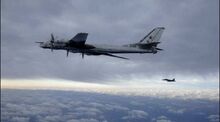
Russian bomber and jet close to alaskan airspace. Source: Getty Images
Tanaga island also saw landings of russian troops, who started to create makeshift driveways for their aircraft. The Americans, who had to focus their remaining ressources and assets in the Arctic in Alaska and the Bering Sea, increased their coastal defences, but didn’t attempt to retake the uninhabited islands Russia was occupying. The invasion of the Aleutians still caused massive shock and outrage among the american people, while leading to enormous criticism of the oppositional Democrats, who were questioning Trumps inactivity against this russian aggression. The invasion of american territory was then used as justification to impose emergency laws in the US, leading Donald Trump to postpone the upcoming election in November 2024, using executive orders to bypass congress, while enjoying unconditional support from the Senate majority republicans. The cancellation of the election created a wave of historic protests, especially in democratic states, while also a certain amount of republicans expressed their deep concern over this development. These protests soon resulted in various violent clashes between anti-Trump demonstrators and his loyalists, while sieges in front of the White House became a common occurrence during the crisis. Trump and his loyalist associates were quick in denouncing these protests as treasonous, leading Trump to enforce a more aggressive policy to strike them down. The US forces in Alaska were put in a heightened state of alert, while the US airforce monitored the alaskan airspace, in order to prevent russian attacks on mainland Alaska. The russian invasion forces in the same time tried to gain momentum, using their initial successes to take as many aleutian islands as possible, before facing significant resistance closer to Alaska. The US deployed several interceptor squadrons of bombers and jets itself, leading to the first aerial dogfights in american airspace in postmodern history.
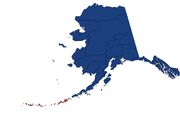
The Nothern Front at the end of 2024.
The americans were able to inflict significant casualties to the russians, but suffered losses themselves, and since most aircraft was deployed at the frontlines of the Eurasian continent, the US was forced to take a defensive position around the eastern Aleutians and the alaskan peninsula in the south. Russian submarines managed to fire missile salvos against the biggest islands of the Aleutians, Umnak and Unalaska, leading to the first killed american civilians during warfare on US soil since WW2. With Americas small number of surface vessels being forced to protect the shores of mainland Alaska, the russian island hopping campaign was able to take Umnak in a short period of time, while engaging in aerial fights over Unalaska. Due to the combined effort of russian submarines, aircraft and surface vessel, in combination with the thin american defences, Russia managed to land invasion forces on Unalaska as the last Aleutian island of the campaign. In order to save manpower, Russia forced its fellow Revisionist Power Mongolia, as one of it co-belligerent closer to the Arctic, to free soldiers who were deployed as occupational forces on the uninhabited Aleutians, so that Russia can focus itself on the ones closer to Alaska. China also deployed some spec forces to assist the russians, while using the campaign for propaganda purposes.
The Southern Front: The War against humanity continues
At the Southern Front in the Middle East, the Revisionist Powers kept struggling against the Allies. The last pockets of armed resistance in Lebanon were struck down, leaving the nation to be occupied by Israel and allied reinforcements. Syria also faced a total collapse, now that the troops of Assad and the last Hizbolah militants were cut off from iranian supplies. This situation forced the syrian forces to increase the use of chemical weapons, especially during the still ongoing siege of Damascus, as well as the Battle of Dayr Az Zawr, leading to a re-emerging chemical arms race between the Revisionist Powers and the allied arab coalition lead by the saudis.
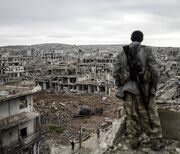
Destroyed city in Syria. Source: Getty Images
During the entire war, both sides kept improving their chemic weapon stocks, and used them on several occasions, which caused unprecedented human sufferage among the civilian population. Iraqi and Iranian troops resorted to chemical weapon use as well during the Battle of the Euphrates and the Battle of the iraqi-iranian border. With this kind of escalation, the war against humanity kept escalating as well. The chemical weapons weren’t used just for military reasons, but were rather used against specific civilians targets, like the few remaining Shia-neighborhoods in Syria, as well as hotspots of the Shia community in Iraq. Both of them came under attack by Saudi Arabia and its allied sunni-militias, who committed countless atrocities against the civillian population, while reports were made, that christian and jewish communities along the frontline were massacred by not only saudi and saudi-allied forces, but also iranian backed militias and even turkish forces. The turkish army, and its own allied militias were accused of using white phosphorus bombs against kurdish targets, including civilian areas, which was dismissed by Erdogans leadership as anti-turkish propaganda, produced by terrorists. In Iran, the mullah regime under the Ajatollah tried to send a message to their enemies, by publicly executing sunnis, who were accused of being spies of the Allies. At the same time, iranian and iraqi troops started to dig in close to the iranian border and the Euphrates region, in order to slow down the allied approach. Iran also fortify, its entire southern and western border, in preparation for a possible allied invasion. With most of Irans naval forces being destroyed, except some close to shore defences, the gulf states of Oman and Bahrain finally decided to officially declare war on Iran, while sending troops to the frontline.
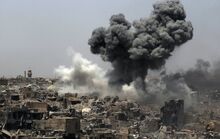
US lead airstrike in Iraq. Source: Getty Images
Both of them already supported the Allies more or less directly, but were hesitant to fully join as long as Iran had control over the Persian Gulf. This left Quatar as the last Gulf state not supporting the allied cause, which caused severe tensions with Saudi Arabia and its arab coalition. Accusations of quatari financial support for Iran became loud, and allied requests of using Qatar as a staging ground for future amphibious invasions of Iran were denied, leading Saudi Arabia to once again implement a blockade against Quatar. This development not only created tensions between Saudi Arabia and Quatar, but also between Saudi Arabia and one of Quatars closest allies, Turkey. Both nations engaged in rather hostile rhetoric with each other, with reports coming up that saudi and turkish forces were allegedly attacking each other in Syria, where their respective spheres of influence met.
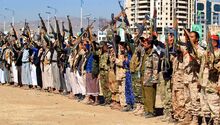
Houthi-supporters in Sanaa. Source: Getty Images
Saudi forces also started a full invasion of western Yemen, so that the Allies could secure the entrance to the Red Sea. With the help of the airforce, the already thinned out saudi forces were able to march to the outskirts of Sanaa, the main stronghold of the iranian backed Houthi-rebels, but suffered heavy casualties during the campaign. The Houthis were able to inflict sensitive losses to the invading troops, by using iranian made missiles and various kinds of drones, which was used by Saudi Arabia as a justification for indiscriminate bombardment of Houthi-held areas, causing mass-casualties among the civilian population. Starvation and disease were spreading in the already war-torn country, causing protests in the West against Saudi Arabias actions. At the Israeli-Palestinian Front, the Invasion of the Gaza Strip was still going slow, due to not only armed resistance of Hamas and the Islamic Palestinian Djihad, but also lightly armed civilians, which forced the israeli troops to show more restraint in order to avoid unnecessary conflict with the arab coalition and the western allies. The mixture of armed militias and civil opposition caused dozens of civilian casualties on a daily basis, while the israeli airforce conducted precision strikes against Hamas strongholds. The palestinian insurgency in the West Bank was met with heightened military presence of Israel, but it avoided airstrikes in this theater in order to avoid casualties in the israeli settlements. Palestinian militias also increased their bomb-balloon campaign against Israel, which remained only symbolic in nature, since most of the bombs were shot down before reaching populated areas.
Advance in the Indo-Pacific
The months of fighting in the Indo-Pacific saw new developments at the end of 2024. With massive pressure coming from the North, West and South, Indonesia saw itself forced to relocate most of its airfleet from Java to Sulawesi, allowing Australia and the western Allies to exploit this by using stand-off weaponry against several southern indonesian islands. After the retreat of the indonesian airforce, australian planes started a bombing-campaign against Java and Sumba island, while also attacking indonesian troops holding on to West-Timor and West-Papua.
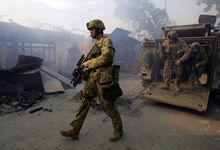
Australian troops in East-Timor. Source: Getty Images.
The Allies also began land operations against said islands, leading troops from Australia, Papua-Newguinea, the US and even the UK to cross into West-Papua, while being supported by freedom fighters. Due to the ongoing hostilities of Indonesia in West-Timor, East-Timor joined the Allies and allowed allied landings on the island in support of an invasion of the western part of Timor. Due to the continuous warfare in the Indo-Pacific, more and more micro-states joined the war effort against China and Indonesia, leading volunteers from Micronesia, the Marchall islands and Palau to fight alongside the western allies in the tropical conditions of the New-Guinea front. In the north, Malyasia also openend a land-front into Indonesia, by attacking into Borneo, while receiving support from singaporean and phillipino troops. Brunei also decided to declare war against Indonesia as a long allied partner, leading forces from Brunei to join the Borneo campaign. At the same time, malaysian planes conducted air-raids against Sumatra, while enjoying cover from singaporean and indian naval assets, that were patrolling the Malacca-strait since the battle of the Natuna Sea. The indian navy also joined its australian counterpart in the campaign to retake the Christmas and Cocos islands. The indian and australian forces also received reinforcements in form of british and french forces, which were protecting european overseas territories in the Indo-Pacific. Despite heavy resistance from the indonesian navy and airforce, Indonesia decided to abandon the occupied islands, leading the forces stationed there to surrender to the Allies.
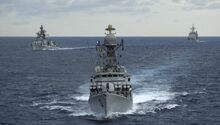
Indian vessels operating in the Indian Ocean.
Chinese forces stationed on Cocos and Christmas islands refused to surrender though, and after weeks of fighting, while being outnumbered, the chinese troops were almost completely destroyed, which was exploited for allied propaganda. With Indonesias occupied territories taken, and the protracted jungle warfare in West-Papua and West-Timor further escalating, the first voices came loud for Indonesia to seek for peace with the Allies. The allied air raids and missile attacks on Java in the meantime were leading to a constant harassment of Jakarta, which further increased the pressure on the indonesian leadership. As part of an joint ASEAN approach, both Vietnam and Thailand also sent naval forces into the Natuna Sea, with the goal to assist the malaysian, singaporean, indian and western navies in attempting to break the indonesian naval defences.
2025
The African Front: South Africa joins the frey and fighting breaks out in West Africa.
With the new year approaching, the conflict in Africa kept spreading to more and more regions. Due to the russian military and paramilitary influence inside its borders, the Central African Republic was pushed to join the Revisionist Powers, leading it to send troops to the south sudanese front, while allowing congolese troops and russian paramilitaries to encircle the allied forces in South Sudan. For similar reasons as the C.A.R, Bostwana, Angola and Madagascar declared their support for the revisionist cause, that’s why Zimbabwe was able to send troops through Botswana into Angola, in order to give reinforcements to the D.R.C as well. On their way, troops from Zimbabwe and Botswana violated the namibian border, causing a heightened state of alert in southern Africa.
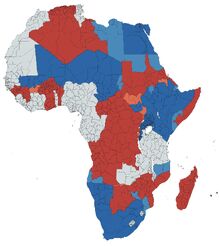
The african theater at the beginning of 2025.
With all of these additional forces closing in on South Sudan, while committing countless atrocities on the civilian population , South Africa, which engaged in the past in a peacekeeping mission in South Sudan, decided to once again provide military assistance to the south sudanese, hoping to be able to stop the escalation. This caused severe tensions in southern Africa, since this increased the chance of south african troops engaging against their zimbabwean and botswanan counterparts fighting with the D.R.C. and Sudan against the south sudanese. South African troops were sent through Mozambique and Tanzania towards allied nations close to the central african front, while sending a smaller battalion to Namibia, in order to reassure its neighbor of its support in the case of escalation in the south.
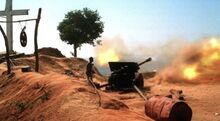
Shelling in Angola. Source: Pinterest
Zimbabwe called for the end of South Africas involvement in the conflict, and sent troops close to the border as a gesture of intimidation, while russian paramilitary Wagner Group conducted several acts of sabotage and assault against allied forces all over Africa. Among those targets were south african troops crossing into Tanzania through Mozambique, causing outrage among the South African leadership. Those attacks on the other hand were blamed on islamists in Mozambique by the russians, because they tried to avoid direct confrontation with South Africa. As a result, a smaller contingent of South Africas troops was ordered to remain in the North of Mozambique, in order to tackle potential „terrorist attacks“ against their forces marching through. Mozambique, which only agreed on allowing troops to travel through its territory to reach the allied battlefields further north, protested against the non-temporary presence of south african troops, and mobilized its forces as a gesture of intimidation. In order to avoid the economically and military strong BRICS nation of South Africa to engage more against revisionist african nations on other battlefields, the paramilitary Wagner group conducted a false flag assault against south african troops, causing fighting with forces from Mozambique. As a result, south african troops were authorized to neutralize their mozambique counterparts, leading Mozambique to declare war on South Africa. At the same time, south african and namibian troops were caught in skirmishes with zimbabwean and botswanan forces violating Namibias territory again. This lead Botswana, Zimbabwe, but also Angola to declare war on South Africa.
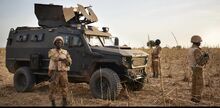
Troops from Burkina Faso on patrol. Source: Getty Images.
In western African, things also remained tense in various nations like Burkina Faso, Ghana and Guinea. Due to Trumps global retreat in the years before the war, Burkina Faso was left with significantly less support against islamist rebels in its territory, leading to growing frustration about the lacking western commitments. Russia exploited this by increasing its ties to Burkina Faso, in oder to bolster its overtaxed military against the islamists, binding them closer to Russia. The increased dependency on not only Russia, but also China allowed the Revisionist Powers to pressure several western african nations to support their war effort against the Allies. Burkina Faso attacked and captured several thousand french troops inside its territory, who were lacking in equipment to counter the aggression, while Ghana and Guinea saw themselves forced to join Burkina Faso in attacking into Mali, a Sahel country hosting american, french, british and even german troops, in order to divert the Allies‘ attention. Benin, which was also dependent on russian aid over the years also joined the Sahel campaign of the Revisionists, hoping to benefit economically from China and Russia.
The Eastern Front: Chinas Advance halted
At the Eastern Front, the chinese advance that lasted for almost 4 years slowly came to a halt in 2025. No significant progress was achieved in Korea, while the Indo-chinese Front remained static, leaving only the Southeast-Asia Front as the only one that saw still some movement from both sides. The years of allied blockades took their toll on China, which was increasingly confronted with shortages of fuel and other ressources, despite Russia and other continental Revisionist Powers trying to help China compensate for that. While Chinas economy moved to the brink of collapse, a new wave of insurgencies emerged in Tibet and Xinjang, supported by allied powers. These insurgencies diverted Chinas attention more to the inside, leading to bloody countermeasures in both regions. Especially Xinjang saw a new dimension of violence against inner chinese citizens, in form of several massacres against areas of the muslim Uyghur minorities. Thousands of Uyghurs were rounded up and brought into China’s „re-education“ camps, which became de facto concentration camps for Muslims and other individuals the regime saw as undesirable.
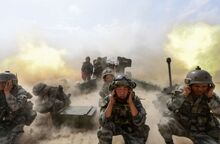
Chinese firing crew in action. Source: Google
At the same time, casualty rates at the Korean Front mounted rapidly, due to the large armies that were concentrated in comparatively small terrain. Seoul gained the name of being a „meat grinder“ , because both sides concentrated large masses of forces in and around the city, leading to unforeseen carnage. North korean troops, which were facing massive material damage due to their outdated equipment , were forced into the defense in various sectors of the front, forcing the chinese and russians to relieve pressure on their reluctant allies, by increasing their attacks on Cheongju and Andong. The mongolian troops ,that were reluctantly drafted during the war by the revisionists, were used as additional cannon fodder to slow down allied troops in Korea. The Allies on the other hand were able to inflict severe damage on the Revisionist Powers during the Battle of the Sea of Japan, rendering most of North Koreas navy useless, while leaving only the russian Pacific Fleet and the chinese submarine forces to fight off allied vessels from the eastern korean coastline. Long range missile attacks against Japan and pacific american territories became less frequently, due to shortages in Chinas arsenal. Russian anti-air defences were able to keep the allied airforce at bay, but the additional fronts that were opened by Russia in the Arctic forced the missile and air defense forces to increasingly focus on the protection of Russias coastline.
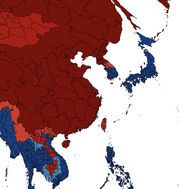
The Eastern Front during the first half of 2025.
This created enough openings for the allied airforce to harass the revisionist lines in Korea, leading to heavy casualties among the north koreans. North korean dictator Kim Jong Un faced not only immense pressure on his troops coming from the Allies, but also the chinese leadership demanding Kim to hold the line no matter what, while the north korean population suffered from mass starvation and disease. As an act of desperation, Kim authorized the use of chemical weapons of mass destruction, causing suffering among civilians and soldiers alike. Meanwhile, chinese troops in Southeast Asia were bogged down in costly jungle warfare with the Allies, who were able to prevent a chinese breakthrough during the Battle of Hanoi. Allied troops from Thailand, Vietnam and the US almost completely overrunned Cambodia, while cutting it off from Laos. Simultaneously, allied air, missile and long range artillery attacks against Hainan became more frequent, causing additional upheaval and protests in China. Due to the war entrance of Vietnam and Thailand, China had to pull back its „9-Dash line“ further away from the continental asian coastline, which threatened to create an opening between the Spratly and Paracel islands. With the combined effort of american, malaysian, vietnamese, thai and indian naval forces, the Allies managed to exploit the situation by conquering the Royal Charlotte Reef and the Ardasier Reefs. The chinese navy also suffered casualties during the Battle of Rifleman Bank, leading the chinese leadership to decide for increased mining of the South China Sea, as well as additional fortification of the Paracel islands. The conquered islands in the South China Sea then were repurposed by the Allies, who deployed their own anti-air and anti-ship defenses on these islands, which increased their range significantly.

Allied troops on the beaches of Korea. Source: Getty Images
Among the systems deployed were also the first batteries of the new US Strategic Long Range Cannons (SLRC), which were able to deliver massed fires at a strategic range of up to 1852 km (1000 miles). These cannons, which were firstly introduced in 2023, proved to be effective against revisionist A2/AD capabilities and enabled allied airforces to penetrate deeper into enemy airspace, and were therefore also deployed in Korea, where they were used against russian S-300 and S-400 units. The US also added additional GLMRS launchers with an extended range into their arsenal, leading more and more revisionist targets in North Korea, occupied Taiwan and coastal China to come into the range of allied fire. South Korea at the same time faced one of the worst humanitarian catastrophes in history. Millions of refugees were fleeing the bloodshed in the North of the country, but due to the geographical limits of the Peninsula, the gigantic armies assembled in Korea, and the range of both sides weaponry, tens of thousands of civilians fell victim to the fighting, despite trying to escape.
The Western Front: Allied Breaktrough in the Balkans
With Africa being more and more entangled in the war, the US facing an invasion of its Far East territories, and the Eastern Front seeing a slowdown of chinese progress, Europe still struggled to break the stalemate at the Western Front. While the deadlock along the Western Front seemed to be ironclad, the war at the Balkan Front saw far more movement. Despite its successes in Bosnia and Herzegovina, as well as Kosovo, Revisionist Power Serbia faced severe problems due to being almost completely surrounded by enemies. The Allies finally managed to consolidate enough forces around Serbia to attempt breaking through the enemies lines. While croatian troops, supported by the slovenians, were already invading and occupying several border towns in Serbia, Serbia itself launched an invasion of Croatia, leading to heavy fighting in the region of Vukovar.
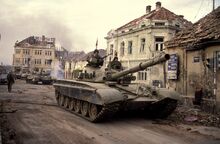
The croatian city of Vukovar during a serbian siege. Source: Getty Images.
The albanians, kosovarians, greeks and montenegrins pushed back against the serbs in Istok and Gjilan, while a montenegrin attempt of crossing into Serbia through the serbian-montenegrin border failed. The romanians on the other hand, supported by the french, british, slovakians and to a smaller extent germans, managed to perform a successful invasion of Serbia along their entire shared border, despite missile attacks launched by the russian Black Sea Fleet, leading Baćka Topola to be captured by the Allies. At the same time, allied aircraft intensified their bombing campaign of Belgrade and important serbian infrastructure, leading to heavy casualties not only among the serbian armed forces, but also the civilian population of Serbia, causing outcries in both revisionist and allied countries. Meanwhile, the Allies of Europe increasingly banded together for the development of new weapons and other systems. One of the main focuses was additional and improved fire power, which was heavily needed in order to destroy russian anti-air defences, while smashing through their own fortifications. Additionally, the Allies tried to develop ways of countering russian satellites, which gave the revisionists advantages in monitoring allied operations and movements. There were also projects for new 6th generation fighter and bomber aircraft, which saw support from the US as well. Especially Germany became increasingly dominant in the development of new weapons, leading to the production of various new artillery systems, improved tanks, rifles, aircraft and even submarines. Meanwhile, after intense diplomatic effort, Italy declared its support for the Balkan campaign, leading italian troops to be landed in Albania and Bosnia, where they engaged against serbian troops and their allied militias in ethnic serbian territory. Allied surface vessels in the Adriatic conducted several missile strikes against Serbia and Republika Srpska, causing a serbian setback in Bosnia and Herzegovina.
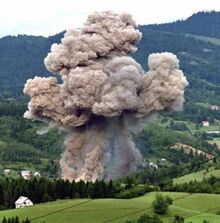
Serbian ammunition depot in Bosnia, after being hit by NATO aircraft. Source: AP photos
Main targets of the allied missile attacks were serbian ammunition depots and radar stations, while the airforce conducted waves of air raids against serbian supply routes and artillery positions. Bulgaria still remained neutral, but increased its defences along its border with Serbia, in the case of a potential attack. It also granted the Allies logistical support, as did Hungary, but this wasn’t enough to stop allied frustration with those uncommitted NATO members, leading joined allied military funding in Bulgaria and Hungary to be frozen. Due to the ongoing struggle on the continent, the europeans made a request to Washington, asking the US to send more troops to the Western Front, which was denied. The official explanation for that was, that the US would lack enough troops to follow that request, but at the same time, thousands of newly drafted and trained US soldiers were sent to the Eastern Front, in order to force a victory against China. What made things worse were public comments of Donald J. Trump, who claimed that the europeans would been able to defeat the russians, if they would’ve spent more on defense before the war, as the US demanded. Trump also publicly stated, that the europeans would perform very badly, and that they should seek peace with Russia. These comments were met with harsh criticism throughout Europe, while there were also loud critical voices in the US condemning Trumps statements. Almost simultaneously, 2000 US soldiers were ordered to be pulled out of Europe, in order to fight at the Eastern Front, causing anti-american protests all over the continent. Especially Poland, which was very pro-Trump before the war, felt betrayed by this move, and moved closer to its european allies for joined defence plans and weapon programs. Russian mis strikes on the other hand got less frequently, because Russia wanted to prevent missile shortages. These remaining strikes were still able to destroy a lot of allied highways, runways, roads, airfields and railways though, affecting central and nothern Europe the most, due to eastern Europe largely being occupied by Russia.
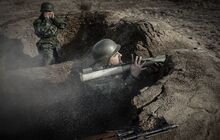
Serbian soldier firing an RPG from his shoulder in a trench. Source: flickr
As compensation for the destroyed infrastructure, the Allies of Europe came up with new, innovative ways of transporting soldiers, supplies and equipment, that’s why they introduced a new class of large airships, as a way of not having to rely on airfields and railroads. At the same time, serbian forces started to dig in and fortified their positions, creating several lines of defense against the invading troops in the north and northeast, by taking position along the Sava and Danube rivers. This on the other hand meant, that Serbia had to effectively abandon Vojvodina as a whole, in order to assure Belgrades security. Traditionally pro-russian state, and newest NATO member North Macedonia remained rather passive, but tried to move the Allies towards a rather revisionist leaning peace diplomatically, since close ties between Russia and the Balkan nation remained present throughout the war. North Macedonia still mobilized parts of its army for the case that conflict would spread, but instead of mobilizing towards the serbian border, most of the troops activated this way were sent much closer to Greece, Kosovo and Albania, causing tensions with allied nations. Despite these frictions with local Balkan players, the allied campaign against Serbia seemed to be more successful than the ones against Russia, which saw nothing but the devastation of large parts of nothern and eastern Europe. Many nations in the world eyed on Europe, asking themselves if the fate of the Allies may be determined by victory or failure of the Europeans against Russia and its revisionist allies.
The Southern Front: The Kurdish Genocide and the Bombing of Gaza
The war in the Middle East meanwhile showed no signs of becoming less bloody, especially for the civilian population. While the iranian and iraqi lines were on the brink of collapse, Syria, after many years of bloodshed and destruction, finally was defeated with the Fall of Damascus. Allied troops from the arab coalition, the UK, America, France and other western aligned nations marched into the city after one of the largest sieges in history, leading to weeks of urban clashes with hostile insurgents and snipers. Nonetheless, most of the city was conquered in a month, followed by an allied hunt for syrian dictator Bashar al Assad. With only some small pockets of syrian resistance being scattered all over the country, the Allies increased their effort to fulfill their respective agendas. While Israel fully consolidated its gains on the Golan heights, Turkey began with the forceful resettlement of millions of syrian refugees housing on its territory. Erdogans plan was proposed as a „final solution“ of all of Turkeys main struggles: the refugee crisis and the „kurdish question“.
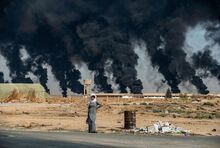
A kurdish city during a turkish offensive close to the border. Source: Getty Images
Most of syrian and iraqi Kurdistan was already under turkish occupation, but resistance of both kurdish militias like the YPG and SDF, as well as kurdish civilians remained present, which was accompanied by a new wave of kurdish related terror attacks inside Turkey. Sympathizers of PKK and the „Freedom Falcons Kurdistan“ committed a series of bombings against police stations, military security posts, and bases, leading to the death of dozens of turkish soldiers and policemen. A kurdish-related terror attack during a AKP rally additionally killed several civilians, causing Erdogan to proclaim the beginning of Turkeys „final solution“. This plan included the resettlement of syrians, arabs and assyrians in Turkeys conquered territories in Iraq and Syria, for which Erdogan wants to completely dissolve Kurdistan, while „neutralizing“ all terrorists in the region. Turkish troops marched into every kurdish majority cities, and captured all males older than 14, many of which were rounded up and executed on sight, under the justification that they were terrorist fighters who allegedly attacked turkish forces and civilians. The turkish airforce increased its indiscriminate bombing campaign against kurdish strongholds, in order to evict kurds who refused to abandon their cities. Kurdish civilians who didn’t fled the scene, despite the aerial bombing and shelling, were gathered and forcefully deported further into the syrian desert, which was reminiscent of the Armenian Genocide during WW1.
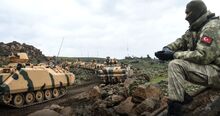
Turkish military in preparation to move against kurdish forces. Source: Turkish military
Because of this, many kurdish civilians, especially women and children, were left in harsh conditions, without sufficient supplies of food, water and medicine, leading to the death of hundreds of civilians. These acts of violence couldn’t be denied any longer by allied leadership, especially because reports about what has now become a kurdish genocide became more and more widespread. As a result, protesters in Europe and the US called for the eviction of Turkey from the alliance, while Israel and the GCC joined in verbal condemnation of these actions. Any demands for Turkey halting its attacks were met with aggression and dismissal, leading the AKP regime to call its official allies as supporters of terrorism, saying it will never stop to do whatever it takes to eradicate it.
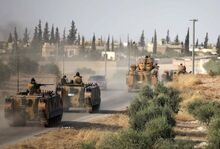
Turkish armored vehicles moving into Syria. Source: Getty Images
After increased violence between Kurds and turks in the southeast of Turkey, the turkish army even „occupied“ kurdish dominated areas in its own territory, leading to civil war like uprisings and the incarceration of almost all male kurds in the region, who were brought into detention camps in Turkeys north. Overall, one and a half million kurds would be killed throughout the entire war. At the same time, violence between Israel and the Palestinian Territories escalated as well. The Gaza campaign remained in a kind of deadlock, meaning israeli forces focused on attacking and destroying Hamas tunnels and weapon depots, while marching deeper into the Gaza Strip. After the death of palestinian leader Abbas through targeted assasination, Hamas and the Palestinian Djihad vowed to retaliate in the biggest fashion possible, while a general uproar went through the palestinian public. That’s why, during the high jewish holiday of Pessah, Hamas-related extremists and militant palestinians committed the one of the worst acts of terrorism in Israels history. Extremists in the West Bank stormed houses of israeli settlements at nightfall and massacred dozens of israeli families during their celebrations, while multiple synagogues were attacked by suicide bombers and crude missiles.
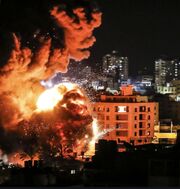
Aerial bombardment of Gaza. Source: The Guardian
In Jerusalem, almost a hundred militant palestinians killed bystanders in the streets with knifes and improvised explosives, while a series of car bombs and suicide attacks lead to more deaths and chaos in the city. At the same time, hundreds of missiles were fired by Hamas and other terrorist organizations from the Gaza strip, and despite many being intercepted by Israels iron dome defences, the ammunition shortages of the last year still lead to many israeli cities to be hit, although the casualty number of these attacks remained rather low. Israeli soldiers and security forces in Jerusalem engaged in street fights with palestinian extremists the whole night, causing both israeli and palestinian civillians to be killed in the process. During this massacre against the israelis, almost 200 civilians and dozens of security forces were killed, which was proclaimed by Hamas as being the „divine punishment“ of the israelis.
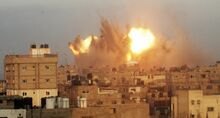
Israeli airstrikes in Gaza. Source: Getty Images
The iranian leadership and its followers publicly cheered for this massacre, as did anti-israeli protestors all over the arab world, including Saudi Arabia, Qatar, the UAE and Turkey. While the leadership of allied Arab nations tried to somewhat distance itself from these voices, Turkey and non-allied Qatar refused to condemn neither the massacre nor those who celebrated it. The western allies on the other hand expressed their shock and support for Israel, although the US was the most vocal in its condemnation of these massacres. Israeli president Benjamin Netanyahu announced that Hamas would finally be rooted out and destroyed, which was followed by a sudden retreat of israeli forces in the Gaza strip. A few hours later, waves of israeli aircraft were ordered to attack every single potential Hamas hideout, whilst receiving support of a couple of american jets and bombers. The result was the de facto carpet bombardment of the Gaza Strip, that lasted for several hours. The bombardment was so intense, that almost no missiles could be fired by palestinian extremists in response. At the end, 80% of all buildings in Gaza were completely destroyed, while almost a third of its entire population was killed. Most of members and leaders of Hamas didn’t survive this night, leading the organization to cease to exist. The nations that saw cheer for the israeli massacre were also the ones aggressively condemning the bombardment of Gaza, with som people in said nations even demanding that there should be war waged against Israel. And despite their initial support, many western Allies, except the US expressed their shock about this disproportionate retaliation. The israeli army then moved into Gaza and occupied the entire Strip, as well as the Westbank, leading the Palestinian Territories to be dissolved as such.
Allied Advances in Africa
The Allies not only saw successes at the Eastern, Southern and Western Front, but also the African Theater of the war. The east african allied coalition of Kenya, Ethiopia and Uganda managed to push back against the revisionists at the Central African Front, leading to heavy losses among the sudanese and kongolese. With the additional support of western and south african troops, the Allies also achieved considerable gains in Eritrea, which was forced to abandon most of its southern territory. Kenyan and ethiopian forces, supported by US troops, advanced into the somalian cities of Kismaayo, Jaimaame and Baidoa, meaning that the capital of Mogadischu was heavily exposed for allied aircraft and artillery. Allied troops also successfully invaded Sudan and the D.R.C, leading the sudanese positions around Ad-Damzin, Al-Quadarif and Qala An Nahl, as well as the congolese cities of Bunia, Beni and Butembo to be taken by allied forces.
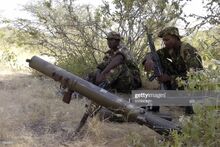
Kenyan soldiers on patrol close to the somalian border. Source:Getty Images.
Further south, the increased diplomatic pressure of South Africa pushed Tanzania to join the allied cause, leading Tanzania to open a second front against Mozambique, while in secret, south african diplomats assured Russia, that no russian nationals operating in Mozambique would be harmed, unknowing that the Wagner group was responsible for the attacks on south african troops. At the South African Front, allied troops of South Africa advanced into Bostwana and took Molepolole and Gaborone, while Serowe and Palapye were taken a few days later. South Africa also attacked into Zimbabwe and managed to occupy party of the strategically important A4 and A6 highways. Meanwhile, south african and namibian troops in the west advanced deeper into Angola, by marching through the Iona National park and the Coutada Pública do Mucusso, causing severe damage to protected wildlife in these reservoirs. In the North, allied Sahel troops of Mali, Niger and Chad, supported by the french, british, americans and the few remaining german forces, were able to push into the south of Algeria, but suffered heavy losses. In order to relieve pressure from the comparatively weak Sahel allies, western leadership pressured the major non-NATO Allies of Morocco and Tunisia to finally enter the war on the allied sides. Since both nations already suffered heavily under the war in their neighborhood, especially in terms of economic losses, the president of Tunesia, as well as the moroccan King finally declared their support for the Allies, and reluctantly declared war on Algeria. Morocco also received reassurance from the US that America would recognize and support its claims in Western Saharah, in exchange for Moroccos entrance into the war against Algeria.
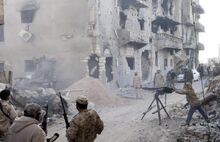
Pro-Haftar forces during urban fighting in Lybia. Source: Reuters
In order to secure the Gibraltar strait, british and spanish troops were landed in Marocco to deliver reinforcements for its algerian campaign. Tunisia received allied reinforcements from the UK and France as well, while many tribal rebels fighting in Libya declared their support for Tunisia. Italy refused to send in more troops into North Africa, since it was originally supportive of the now revisionist government of Tripoli. Italian naval forces instead monitored the Medditeranean for any illegal or enemy movement, while trying to prevent any refugees from reaching european shores. Several NGO missions reported that they found and increasing numbered dead refugees in the sea, many of which had shot and burn wounds, leading to accusations that Italy was actively firing at refugee boats. These accusations were rejected, and many humanitarian helpers in Italy were arrested for „enemy propaganda“ , while many private sea rescue ships said that they were attacked by the italian navy. Further South, Nigeria, as a country with deep ties to allied nations like the US and the UK, wanted to bring an end to the fighting in Africa, and declared its support for the allied cause, as did Côte d’Ivoire and Liberia, who suffered economic struggles due to the ongoing war. Due to the joint effort of Nigeria, Niger, Côte d‘Ivoire, Liberia and Mali, the Allies were able to push into the revisionist nations in West Africa, leading Quahigouya and Bobo-Dioulasso in Burkina Faso, Takoradi and Kumasi in Ghana, Kankan and Nzérékoré in Guinea, and ultimately Porto Novo, Parakou and Kandi in Benin to fall into allied hands.
The "Agents War"
Since both the Revisionist Powers and the Allies were deeply entangled in combat on the battlefield, both sides also heavily intensified their intelligence operations, leading to what was later called the “Agents-“, or „Shadow-War“. Spies and sleeper agents were used on all fronts in order to gain intelligence, sabotage the enemy or even actively assassinate specific targets. Especially the US, Russia and China deployed thousands of agents all over the world, who waged a covertly war against their respective counterparts. In Europe, several russian dissidents and deserteurs were attacked even far away from the frontline, leading dozens of them to be often shot in broad daylight, or even assasinated using nerve agents, caused panic and hysteria in Europes large cities about the usage of chemical weapons. In the US and Russia, sleeper agents sabotaged Communication infrastructure and spread misinformation on a large scale, including the publication of explicit material from the battlefield, which accused the opposing side of war crimes.
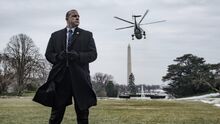
Secret Service agent observes as President Trump departs in his helicopter. Source: Getty Images.
Allied and revisionist agents also targeted their enemies power grid, in form of several hacking and even bombing operations against power lines and plants, while several high ranking politicians were killed by car bombs and snipers. Especially car bombing attacks became so frequently, that the streets of Moscow, Washington D.C. and Beijing often resembled battlefields themselves. These attacks not only disrupted the enemies leadership, but also increased panic and hysteria among the population of both the Allies and Revisionist Powers, leading a feeling of general suspicion to spread among the people. Russian and chinese security forces raided offices and private homes on a daily basis, arresting hundreds of suspects, even though many of them were wrongly accused and only arrested for either family or friendly connections to other countries. In the US, state surveillance was massively increased, in order to find and identify foreign agents, while many foreign press members and members of foreign organizations were expelled from the country. The „Agents War“ also caused massive paranoia among the leaders of the Allies and Revisionist Powers. Chinese leader Xi Jinping ordered the execution of members of his cabinet who became increasingly and openly wary of the war, accusing them to be traitors working for the US, while Donald J. Trump developed a paranoia of potentially getting poisoned, leading his overall demeanor to become more aggressive and fragile. Wiretapping and undercover surveillance also became much more common, that’s why russian audio of several politicians discussing their military strategy was leaked, as were conversations among the american leadership.
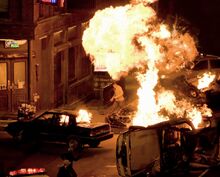
Flames bursting out of an exploded car. Source: Getty Images.
Many whistleblowers, not all of them acting under revisionist orders, were brought in front of war tribunals, and charged with treason, despite many of them just trying to reveal allied misconduct on various battlefields. During this time period, Trump ordered two thousand american soldiers to be pulled out of Europe, in order to fight against China and prepare for the invasion of Iran, causing massive outrage among the europeans. A lot of Trump critics went to the streets over this, leading to clashes between protesters and security forces, while almost the entire democratic leadership openly questioned Trumps strategy and lack of allied commitment. House Democrats and democratic senators tried to hinder Trump's decision to pull troops out of Europe, which failed due to Trump's executive orders, the emergency laws still being in place and the unconditional backing Trump enjoyed through his loyalist Senate majority. The attempt of sabotaging Trumps decision making lead the president to order the arrest of several public democratic figures, like Rep. Adam Schiff, Jerry Nadler and even Nancy Pelosi, accusing them of treason as well. All three of them were released after a week, but this action still intensified the tension inside Americas society. During exactly these tensions, the US and the allied leadership in Europe were rocked by one of the largest scandals in political history. A whistleblower, who was incredibly critical of Trump's decisions and who witnessed his strategy behind them, created a secret footage with audio, which showed a conversation between Trump and some of his political advisers. In this footage, despite lacking quality, Trump can clearly be seen an heard speaking about the situation at the Western Front. When his advisers stressed that the US needs to support their allies in Europe against Russia, Trump repeatedly asked why, and added that it would be Europe's own fault that it was performing so poorly against the Revisionist Powers. He called the europeans bad allies , and asked his advisers why he should support those „ungrateful“ europeans, when he needs his soldiers against China.
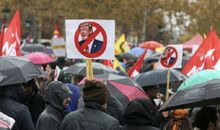
Anti-Trump protests in Paris. Source: Getty Images.
After the notion of the attending people, that the europeans would need the US, or otherwise Russia would conquer the continent, Trump openly said that he would rather want to negotiate with Russia, instead of having to deal with all of these bad and ungrateful allies. This conversation was leaked days after, causing the whistleblower to be hunted down and charged with treason in a speeded up process. The uproar caused by this revelation shook not only America, but also Europe, which feeled betrayed by the US president. Canada joined Europe in the condemnation of this reveal, while american military leaders tried their best to limit the damage of this scandal, claiming that the US would still fully support its allies. Despite these fruitless attempts of easing the tensions, european leaders and political figures, especially those who worked their way up during the war, came together in order to discuss their next moves. The younger representatives and military leaders, who were drafted during WW3 convinced their older colleagues, that the US wouldn’t come to Europe's rescue, and that it effectively abandoned its allies. Out of this dynamic, several politicians, military leaders and diplomats created a series of european only initiatives, aimed at reorganizing Europe's militaries and its strategy, despite American protest. The US was now increasingly left in the dark about european decision making, while the european command was restructured independently from the US, despite skeptical voices from various european nations, like the UK.
Operation "Goliath": Europe strikes back
In the weeks and months after the „Bombshell-Leaks“ coming from Washington, the allies of Europe, despite the reluctance of some members, co-signed the „United Forces of Europe Act“, an initiative that centralized the the command at the western front independently from the US, while turning the allied armies into one more or less coordinated force. The Allies decided that they have to attempt a large scale breakthrough, in order to collapse the overstretched russian frontlines. That’s why they started with Operation „Goliath“, a plan which intended to create the biggest coordinated land offensive in history. As preparation, new allied airships were used as High Altitude Platforms (HAP), as which they operated in altitudes close to the stratosphere, where they launched anti-satellite missiles and stratospheric drones.
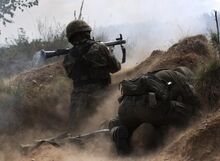
Polish troops firing a grenade launcher. Source: Michigan National Guard
Since those airships were less suspicious than ground launched missiles, their deployment was often ignored or even undetected by russian radar systems, leading to the loss of several surveillance satellites. On the ground, the Allies used a multitude of covert ways to mobilize and position the hundreds of thousands of fresh conscripts, which were readied for service over the last years and months, leading to nighttime movements, the usage of civilian and even decoy vehicles. The coordination of these movements was incredibly difficult, and the pressure on logistics immense, but due to diversion attacks at the finish front, closer to St. Petersburg, as well as the Ukranian front, the Allies were able to distract the russians long enough for them to ready their troops and deploy their new weapons. By using civilian trucks disguised as humanitarian and medical aid, the Allies managed to deploy hundreds of new artillery systems, improved tanks and munitions. This strategy would later on lead the revisionist powers to actively target humanitarian forces, out of fear that they would secretly transport allied weapons. Many of the newly designed aircraft were not operational though, and remained therefore hidden at allied storage facilities. Despite some problems occuring in the coordination and preparation of Operation „Goliath“, the Allies finally decided to launch their offensive after weeks of preparation. At 03.00 am at night, the Allies attacked simultaneously at the entire front, stretching from the Finmark in the North, all the way down to the Black Sea.
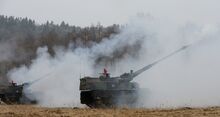
German artillery in action. Source: flickr
The new long range artillery systems, many of which were of primarily german design, shelled the frontline relentlessly, using a wide array of projectiles, ranging from rocket assisted, to smoke and even EMP shells, the latter being designed and provided by the US before the scandal. The artillery bombardment, that was directed with the help of aerostat drones, was also targeted against russian anti-air defences, like the S-400 and S-500, leading to heavy losses for the revisionist powers. Due to many S-400s and 300s being hit by long range artillery fire, the allied air force was finally able to penetrate deeper into enemy airspace, delivering bombs and missiles to the revisionists rear. The simultaneously attack along the entire front, supported by allied naval vessels in the Barent, Baltic and to a smaller degree Black Sea, overwhelmed the russians and their allies, due to their overstretched forces and the additional fronts that pinned down russian troops. Russia, after all these years of fighting, also lacked the resources to provide all fronts with the capacities needed to counter the offensive effectively. Despite incredibly high casualties, the Allies finally broke through multiple sectors at once, forcing the Russians to take a completely defensive stand in Norway, Ukraine and Moldova, while the latter was abandoned by the Russians after a few days, in order to strengthen the defences in Ukraine. Overall, Operation „Goliath“ was seen as the biggest success of the Allies so far, and an embarrassment for the Russian autocrat Putin.
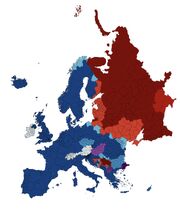
The Western Front during „Operation Goliath“.
The russians also engaged in fierce fighting in the Odessa Oblast, but due to the numerical superiority of the Allies, as well as the combined effort of air, naval and artillery forces, the pocket of revisionist resistance in the Oblast was soon encircled and cut off from the rest of Ukraine, leading to heavy casualties and the capture of hundreds of russian soldiers. Putin ordered that the main focus of the Russian counter-operations should be put on the polish section of the front, as well as the Baltic coastline and southern Finland, in order to avoid St. Petersburg being threatened. The new european approach partially blindsided the Americans, leading US troops to be exposed to enemy fire, because of lacking communication with their european counterparts. Since american casualties in Europe mounted because of this development, Trump and his immediate associates demanded the offensive to be halted and coordinated under the direction of the US leadership, which was rejected by the reorganized european command. Despite the US stopping some weapon deliveries to Europe because of this, the americans reluctantly followed through with the new approach of the europeans, since the US couldn’t afford Russia to succeed at the Western Front, since Russia would then focus on the Eastern and Nothern Front against the US. Several european nations gained new commanding powers in what was now dubbed the „Alliance of the United Forces“ (AUF), leading the UK to get the main command over the european navy, France getting the main command over the army, while Germany took over sub-commands like the allied tank and submarine forces, as well as many logistical and supervisory commands. The european air-command, and the nuclear deterrence was equally distributed between Britain and France, while Germany also retained a lot of influence in the air command.
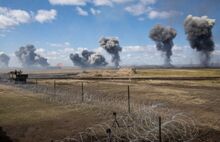
Russian lines close to bombardment. Source: Getty Images.
Many of the southern european allies, as well as the neutral NATO member Hungary felt left out the distribution of influence, despite Italy and Spain being core members of the reorganized AUF naval and air corps. The new structure still had immense flaws, that often slowed down the european offensive, but the initial gains lifted the spirits of the war torn continent, and energized especially the younger recruits who were firstly drafted during this war. Due to the constant demolition of russian anti-air defences, the successes on the ground were accompanied by firece dogfights in the sky, as well as waves of allied bombardment raids against the revisionist lines. This new situation lead the chinese to dispatch some 2 thousand soldiers to the western front, in order to relieve pressure off their most important ally in the war.
The War in South America: Venezuela joins the Revisionist Powers
At the same time on the other side of the globe, the venezuelan Regime of Nicolas Maduro suffered a massive crisis. Due to the ongoing blockades of the Allies against Venezuelas longtime revisionist sponsors, China and Russia, Venezuela came to the brink of collapse. Riots and protests became even more frequent, while the super-inflation and overall dire economic situation caused increased famine and disease in the south american country. The regime blamed the US for this ongoing crisis, and intensified its anti-american rhetoric massivly, while a large portion of the venezuelan people joined in on this animosity. The majority of the venezuelan army remained loyal to Maduro, while the rebelling armed forces lacked significance, due to the missing foreign support after WW3 broke out.
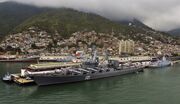
Russian naval vessels north of Caracas. Source: Getty Images
With the survival of the regime being in question, Maduro searched for ways to relieve pressure on Venezuela, while also hurting those he deemed responsible for the crisis, which was why he decided to take offensive action against the Allies. The decision was made to harass allied maritime traffic the same style Iran allegedly did in the Persian Gulf 2019 onwards, that’s why Venezuelas only 2 submarines went on a hunting mission in the coastal waters of the southern Carribean Sea, attacking and harassing shipping lines of US ally Colombia and allied carribean territories, like Curaçao and Aruba. While most of these attacks remained minor in scale and impact, they were enough to worry the allied leadership of a potential South American Front being opened in Venezuela, especially since russian aircraft and soldiers were still present in the bolivarian country. Those forces, including a small Tupolev bomber squadron that was deployed there as soon as the war broke out, were activated by the Kremlin in the wake of the allied advance at the Western Front, leading those aircraft to run bombing raids on allied territories in the Carribean, leading Aruba, Curaçao and Montserrat to be attacked. Due to almost all american naval assets being sent into the Pacific, the US lacked in significant maritime presence in the Carribean, with no aircraft carrier being deployed at Americas southern flank. This lack in presence was exploited by the russian and venezuelan airforce, causing cargo ships and drill stations in the Caribbean Sea and even the Gulf of Mexico to be assaulted as well. The attacks against oil platforms lead to devastating ecological consequences, due to millions of barrels of oil that leaked into the Ocean, while also hurting the allied fuel supply.
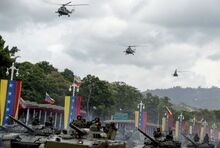
Mobilized venezuelan troops during a display of force. Source: Getty Images
The anti-Maduro Lima Group, often called the Rio-Pact, condemned Venezuelas aggressiveness, yet the group of south american nations remained reluctant to directly call out Russia, due to the good relationship between the federation and South America. The only south american nations that openly expressed support for Venezuela were Bolivia and several factions in Uruguay, while voices in Suriname, Nicaragua, Cuba and some of the bolivarian island states in the Carribean also declared their support of Maduro. In order to prevent any possible escalation, France, the Netherlands and the UK dispatched a small war ship group to the Carribean, so that their territories there gained some protection. Politicians in the US also called for a naval presence to secure Americas southern flank, while also calling for attacks against the russian aircraft in Venezuela. This debate was accompanied by several south american initiatives, like Colombia mobilizing its army along its border with Venezuela, while hunting its few submarines. Wary of a potential strike of the US, Russia and venezuelan dictator Maduro tried to circumvent this scenario, by once again taking offensive action. Due to their support for Maduro since the failed Guaido coup of 2019, the carribean islands of Dominica, Saint Vincent and the Grenadines, as well as Saint Kitts and Nevis allowed Venezuela and Russia to build a military presence on their territory. The support of Saint Vincent was more reluctantly though, because it feared a possibly violent invasion of russian and venezuelan forces, due to Venezuelas claim on Bird Island. This presence was enhanced by the few russian vessels and the one iranian ship that were deployed to Venezuela when the war broke out in the summer of 2021.
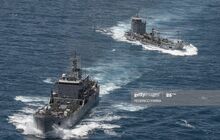
Venezuelan navy vessels in coastal waters. Source: Getty Images
Especially the helicopter flattops were used by the venezuelans and russians to pursue a piracy campaign in the Carribean Sea, leading commercial vessels to be assaulted and captured with the help of helicopters, similar to how Iran captured various oil tankers during the „Tanker-War“ of 2019. US planes taking off from Puerto Rico managed to sink a venezuelan ship, while conducting air strikes against revisionist forces stationed on smaller carribean islands. This lead the revisionists on the other hand to once again attack and effectively occupy the ABC islands, while venezuelan dictator Maduro declared war on the US. Colombia, a close ally of the US declared its support for America, should the fighting come to the continent. Meanwhile, Brazil started to mobilize its troops along its border with Venezuela, for the case of open hostilities.
The Qatar campaign: Turkeys betrayal
With the Western Front coming into motion , and a new front being opened in South Americ, things remained tense in the Middle East. Allied troops kept closing in to the iranian border in Iraq, causing an increased usage of chemical weapons to prevent the invasion of Iran, while the Allies were successful in their attempt to outflank and encircle the remaining iraqi resistance. In order to relieve pressure from the land offensive, the allied CENTCOM main command in the Middle East decided to dare an amphibious invasion of Iran in the Persian Gulf, since most of Irans navy was already destroyed. The only obstacle to prepare the invasion was the last iranian ally in the region, Qatar, which still supported Iran with cash and illegal weapon sales outside of the region. This was enough reason for the saudi regime lead by Muhammad bin Salman to consider military action to neutralize Qatar, while gaining access to its ressources and its territory as a staging ground for the operation against Iran.
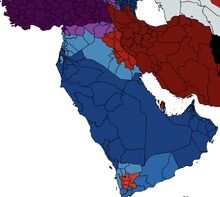
The middle eastern theater of the war in the latter half of 2025
The western allied leadership remained skeptical about the necessity of such an undertaking, especially since US troops were still stationed in Qatar. Nonetheless, the invasion of Qatar was reluctantly greenlit, leading saudi, arabian, jordanian and omani forces to attack into the gulf state. Turkey, which also had a military presence in Qatar, a close ally of the Erdogan regime, demanded that the quote „illegal invasion“ of Qatar, or otherwise Turkey would see itself forced to protect its interests at the gulf. The warning was ignored, and despite fierce resistance of the rather well equipped qataris, the Allies were able to push deep into the state very quickly. US troops stationed in Qatar left their housing to prevent retaliation, and joined their arab counterparts in the ongoing offensive. Qatars modern, and often western weaponry made the allied advance very costly, despite additional support coming from the few british aircraft stationed in Qatar before the campaign. The Qatari army pulled back and established a defensive line further north to protect Doha, allowing the Allies to consolidate a large fraction of their gains. The allied forces also closed in to turkish troops, that now took position along the qataris in the defense around Doha. Allied calls for a turkish retreat were ignored, and after arab , american and british forces kept advancing towads the qatari lines, they were attacked by turkish forces without warning. This resulted in heated exchanges of fire between officially allied troops, causing the deaths of a few hundred arab and american forces. The attack lead to a enormous outrage from a majo of allied countries, while the GCC and US leadership demanded Turkey to withdraw from Qatar and give reparations to the Allies, which was firmly rejected by the Erdogan regime. Erdogan instead claimed that allied troops attacked their turkish counterparts first, and that allied support for the Qatar campaign would equate state terrorism. The allied command, as well as NATO specifically summoned an emergency meeting, in order to decide what to to with Turkeys rogue behavior. At the same time, a british destroyer in the eastern Medditeranean was hit and severely damaged by a submarine of unknown origin, which was consequently hunted down and destroyed by allied anti-submarine assets. As it turned out through careful examination, the vessel in question was a russian one, which caught the allied leadership in the region by surprise. Since there was no possibility that a russian submarine could’ve entered the Medditeranean through the Suez or Gibraltar chokepoints, accusations were made that Turkey would allow them to enter through the Bosporus Strait.
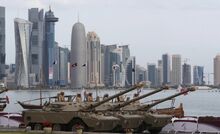
Qatari tanks at display in Doha. Source: Getty Images
Other NATO and GCC members also used the emergency meetings for speaking up against the Kurdish Genocide, which was still occurring in Syria, Iraq and partially Turkey itself, causing heated disputes on public stages. Erdogan and his subordinates aggressively denounced these accusations, and repeated their talking points abo ut how the West would support terrorism and that Turkey would protect its interests by the actions taken over the course of the war. While allied representatives engaged in severe arguments, pro-allied and pro-turkish demonstrators clashed with one another outside of the conference settings, leading to violence and injuries among the protesters. There were also reports of turkish security forces also participating in the clashes, but not to drive the sides apart, but allegedly to attack anti-Erdogan protesters of the other side. The betrayal of turkish troops in Qatar, the turkish support for Revisionist Powers like Pakistan, Libya and Somalia, as well as the Kurdish Genocide and the apparent collusion with russian forces forced the Allies to ultimately eject Turkey from NATO and the overall war alliance, leading all financial and military support for Turkey to cease. Erdogan condemned these actions, and characterized them as a „declaration of war“, as well as the „West showing its real face“. While the Allies officially declared that turkish troops were no longer seen as friendly forces, and that any action against allied soldiers would be retaliated, there were still calls claiming that there’s no desire for confrontation, and that the Allies would stay out of Turkeys way as long as it would do the same. Turkey on the on the other hand declared, that allied troops would from now on be seen as hostile forces, and that Turkey would never give in to any western demands. Violent protests between anti-turkish demonstrators and pro-AKP european nationals of turkish descent emerged all over Europe, with Germany, the Netherlands and Austria being affected the most.
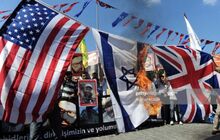
Turkish protesters burning israeli, american and british flags. Source: Getty Images
Racist attacks against turkish institutions were reported, while on the other hand kurdish institutions and political centers were attacked by Erdogan sympathizers. This caused the situation between the West and Turkey to become far more tense, while there were small allied gains in Qatar, the place were this crisis originated. After additional missile bombardment coming from the gulf, the Allies were able to approach Qatar also by sea, forcing the qataris to abandon Dukhan and Al Khor, leaving Doha as the last stronghold of the gulf state. The immense pressure, and the allied numerical advantage lead to first offers by the qataris for a ceasefire, which could culminate in negotiations with the Allies about a truce. At the same time , Turkey opened its borders in the west for around 1 million syrian, iraqi and azeri refugees, and pushed them towards Europe with deliberate pressure coming from Turkeys security forces, as retaliation for western actions against Turkey. Greece and Bulgaria, who both fortified their respective borders with Turkey over the last few years during the war, were confronted with thousands of refugees trying to enter their territory, many of them engaging in violent clashes with security forces, while turkish forces actively helped the situation to escalate by destroying border fences and attacking greek forces through the crowds. While greek and allied authorities warn Turkey against further hostilities, Erdogan threatened the Allies that anything he deems as an aggression against turkish interests will be seen as a declaration of war.
The War of the Carribean: Cuba and Maduro join forces
While the Allies were able to achieve progress at the Western and Southern Fronts, things kept escalating in the Carribean. The ABC islands, as well as some islands of the Small Antilles were still under some form venezuelan occupation, supported by russian forces and bolivarian sympathizers in the Carribean, while the Allies still lacked a larger naval presence in the Carribean Sea. As a reaction to the venezuelan hostilities, the US and its south-american ally Colombia tried to increase the pressure on Venezuela by imposing a total blockade of any goods going to Venezuela specifically In order to demonstrate America‘s resolve, the US publicly sunk cargo-ships that were destined for Venezuela, after allowing the crews to leave the vessels. Among those were dominantly cuban vessels, since Cuba was Venezuelas biggest regional supporter. As a consequence of this, Cuba, which already suffered heavily through allied blockades itself, declared war on the US, while 3 days later, as a show of political support, Nicaragua also declared war against America. After publicly joining forces, both Cuba and Venezuela searched for a potential retaliation against the US, leading them to decide for operations against US and allied territory, which could be exploited by revisionist propaganda. Cuban forces attacked and invaded Haiti as a staging ground for offensives against the US-territory of Puerto Rico.
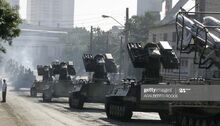
Cuban missile launchers being deployed near Havanna. Source: Getty Images
Venezuelan and russian aircraft on the other hand already conducted airstrikes against Puerto Rico, using St. Kitts and Nevis as a launch platform. This forced the scarce naval force of the US to divert its attention from the southern Carribean Sea to Puerto Rico, leaving only a minimum of defences in the Straits of Florida. With America being distracted by attacks on Puerto Rico and the American Virgin Islands, the Revisionist Powers saw themself tempted to dare a risky, yet ideological valuable endeavor: an attack against mainland America. Since two thirds of the US continental airforce has been called mostly to the Eastern Front, and another large portion being tied down in Alaska, the remainder of the US only had a bare minimum aerial defences, encouraging cuban, venezuelan and russian forces to attempt an assault on southern Florida. At 5 am, the 4th of July 2025, revisionist aircraft launched from the Cay Sal Bank of the Bahamas entered american airspace, and conducted a series of missile strikes and bombing attacks against US territory, starting with Key West. Among the first targets being hit by the revisionists was the Naval Air Station Key West, after which the rest of the Florida Keys were targeted. Despite some minor damage, most of the Florida Keys remained unharmed since the revisionists tried to reach and focus on Miami. The US airforce mobilized every aircraft available at the Homestead Air Reseve Base, leading to the first ever dogfights occurring in mainland american territory. The revisionist attackers were able to hit and damage several buildings in Miami, causing chaos and panic among the civilian population, that has initially gathered to celebrate the american Independence Day. At Nightfall, the US airforce managed to destroy all invading aircraft, some of which crashed into the Everglades and caused fires in the swamps, while at the end of the day 150 americans were killed during what was later nicknamed „the Florida Blitz“.
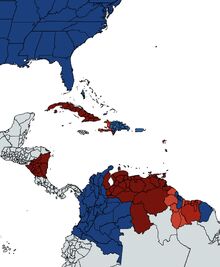
The south american and carribean theaters of the war during summer 2025.
Donald Trump tried to proclaim the kill rate of the US airforce as a tremendous success, despite the oppositional Democrats and Trump critics all over the US seeing this as an embarrassment and humiliation for America , which lead to a new wave of anti-Trump protests in various US states. Cuba and Venezuela, despite losing their entire attack force during this day celebrated the attack as prove of American weakness, while Revisionist Powers all over the globe exploited the Florida Blitz for their own propaganda. Venezuela also planned another hit against the american supply of resources, this time by targeting oil drilling facilities of US companies in Guyana, with which Venezuela was engaged in a century long border dispute. Venezuelan troops, supported by attack helicopters assaulted EXXON oil facilities in the disputed region of Guyana Esequiba, leading dozens of americans to be captured. At the same time, pro venezuelan state Suriname was convinced by the Revisionist Powers to seize the opportunity and take territory it also claimed not only in Guyana, but also French Guyana, leading forces of Suriname to enter the mineral-rich region of Tigri in Guyana, and the area between the Itani and Marouini rivers in French Guyana. This aggression lead France to declare war on Suriname, while french soldiers were able to push the invaders back into Suriname, awaiting more reinforcements from France and the Allies. All of these actions of war finally convinced US ally Colombia to actively fight against the south american Revisionist Powers, that‘s why colombian troops, supported by a small, already present american contingency, attacked venezuelan forces guarding the border between Venezuela and Colombia. The leadership of Colombia alongside US officials, called for military support from the already activated Rio-Pact, leading the governments of most south american nations to evaluate a possible entrance into the war. Venezuelan ally Bolivia on the other hand called for a ceasefire and threatened that a US invasion of Venezuela would also mean war with Bolivia. While the first hostilities started along the colombian-venezuelan border, cuban forces assaulted the US base of Guantanamo. Due to their numerical advantage, the cuban army was able to overwhelm the small US presence of Guantanamo after a week of brutal fighting, which lead to the liberation of Guantanamos inmates. The liberation of the prisoners of Guantanamo, among them many once internationally warranted terrorists and criminals, was celebrated not only by the cuban regime, but also revisionist propaganda channels all over the world, with some even comparing this event with the liberation of concentration camp prisoners during WW2.
Old grievances: the Algerian-Moroccan Front
Fighting also continued in Africa, with most of the continent being entangled in the war at this point. While south african troops advanced further into Botswana and Zimbabwe, the allied campaigns in central Africa and Angola remained more static. In the north, allied troops of the Sahel, supported by the british, french, americans and germans, advanced further into Algeria, while Morocco launched a push into the algerian border region with help from spanish, british and french forces. Especially the involvement of the latter caused some unrest and protests against the Allies in Morocco, due to its french colonial past. Nonetheless, the moroccan army continued its fight, while at the same time, tunisian forces attacked Algeria from the East, forcing Algeria to divert its attention from Libya to its own borders.
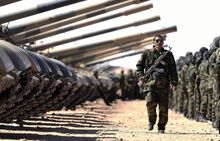
Polisario associated fighters gathered in front of heavy weaponry. Source: Getty Images
The increased involvement of Morocco in the war also lead to a new flare-up of tensions in the Western Saharah conflict, where Morocco still occupied a large portion of the country since the peace agreements of 1991. Due to the moroccan offensive, Algeria once again increased its support for the Polisario Front Movement in Western Sahara, supplying it with additional manpower, weaponry and intelligence. Both algerian and Polisario forces attacked the moroccan built wall separating the country into spheres of influence, leading algerian troops to break through east of Mahbas, while the Polisario Front was able to destroy the wall in the sectors close to Guelta Zemmur, Oum Dreyga and Awsard. Additional Polisario assaults took place south of Techla and Guerguerat, forcing an aggressive reaction of Morocco, which lead to several accusations of human rights violations committed by the moroccan army. With large parts of the moroccan army geared towards Western Sahara, Algeria tried to establish a counteroffensive by attacking into Morocco, allowing algerian troops to take Oujda, while threatening Nador and Taza. Morocco on the other hand relocated some of its forces from Western Saharah further north, which gave it the opportunity to strike into Algerias south, leading algerian troops in Tindouf to be overwhelmed. The allied push coming from the Sahel on the other hand was slowed down significantly, due to the harsh conditions in the Saharan Desert. Russian made Iskander missile launchers were used by the algerians to strike deep into Morocco, allowing it to diminish allied advantages in the air by hitting airfields and bases.
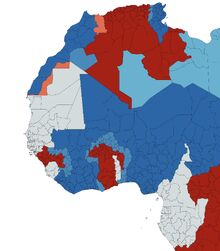
The Algerian Front after the entrance of Marocco into the war.
Morocco itself was reduced to conduct only a few series of frontal airstrikes, due to Algerias advantage in long-range SAM systems. The moroccan navy, supported by the spanish, french, british and even portuguese tried to compensate for Moroccos losses in the air by supporting anti-air defences and utilizing their capable SAM systems to assist in the coastal ground war. Algerian submarines went on a harassment campaign, attacking their moroccan counterparts, while intercepting allied supply shipments from Europe. Moroccos southwest at the same time was overrun by algerian forces, which were supported by Algeria more numerous attack helicopter fleet. The Atlas mountains on the other hand prevented a deeper incursion of algerian troops into Morocco. At the same time, the allied campaign against the relatively new revisionist supporters of Benin, Burkina Faso, Guinea and Ghana proved to be very successful, leading large fractions of these countries to get occupied by allied troops, resulting to the first calls for a ceasefire. Meanwhile, french troops were landed on revisionist Madagascar, in order to protect the french islands off the coast of eastern Africa from potential revisionist operations, while also denying the enemy access to important shipping routes. Off the coast of the Seychelles, indian and chinese vessels, that were heading towards Madagascar, engaged in one of the few naval battles in the Indian Ocean. On the island itself, russian military officials and members of the Wagner-Group supported the army of Madagascar in attacking and sabotaging allied troops. Chinese troops, who managed to escape to Madagascar after the fall of the chinese naval base in Bangladesh, used this opportunity of chaos and confusion in Madagascar to sabotage the indian naval base in the north of the islands, including bomb attacks and sabotage of communication devices. With indian forces engaging against the small chinese presence in Madagascar, and french troops fighting against russian paramilitaries and the madagascarian army, the leadership of the african island feared a total loss of control. Out of despair, madagascarian forces decided to use a very risky move to halt any military action on Madagascar: using biological weapons.
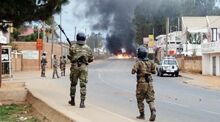
Security forces in Madagascar during unrests. Source: Getty Images
Madagascarian troops in rural areas collected the corpses of people who died from the plague after the consumption of wild animals, and threw them into bodies of water which were used by mainly allied troops as water supplies. This attempt of weaponizing the disease failed, due to no foreign soldiers getting infected with the virus. Instead, this lead to a new wider outbreak of plague among rural citizens of Madagascar, causing panic not only in Africa, but also around the entire world. After this discovery, the french government decided to abandon the Madagascar campaign, as did India. Allied troops stationed on Madagascar were brought to Réunion and the Seychelles, where they were quaratinend under the highest security protocols. This reckless actions of the madagascarian leadership also lead the revisionist powers to abandon Madagascar themselves, forcing russian troops and paramilitary members to retreat towards South Africa and Mozambique. Such methods weren’t only used by Madagascar though, since a few weeks after the first reports of Madagascar using improvised biological weapons, troops in the D.R.C used the same strategy to slow down the allied offensive at the Equatorial Front. Congolese soldiers used civilian and small cargo planes to drop the corpses of Ebola patients over allied positions at night, while also dumping several bodies into local water supplies as well.
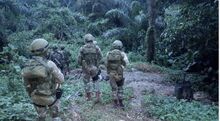
South African pathfinders in the D.R.C. Source:Reddit
This caused another larger outbreak of Ebola, which was able to spread relatively quickly due to the conditions created by the war. Due to some soldiers of allied african countries indeed getting the disease, the allied approach towards the D.R.C. and other african Revisionist Powers in central Africa came to a halt, although an increased number of congolese civilians getting infected as well. At the same time, South Africa reported various successes in its own campaigns, leading to major gains in Mozambique thanks to allied support from Tanzania and Kenya, while Botswana was almost driven to the brink of collapse. The offensive against Zimbabwe, despite being in movement, was slowed down, forcing the south africans to relocate more troops from Botswana to Zimbabwe. At the Horn of Africa, somali forces were driven away to only a thin stretch of territory along the coastline due to attacks of allied african countries coming from the east, and western forces coming from the north. There were also numerous reports of turkish troops in Somalia and Libya increasingly attacking allied forces at the respective fronts.
Progress in Indondesia
In the Indo-Pacific, the Allies also managed to advance further in their campaign against Indonesia. Troops from Malaysia, Singapore, Brunei and Thailand were able to break through at the Borneo Front, allowing them to invade West-, South-, and even parts of East-Borneo, while the advance in South Borneo was halted after the taking of Pontianak. Malaysian, thai and indian troops were also simultaneously landed in Riau, after allied naval and airforces consolidated their dominance in the Malakka Strait. This forced the indonesian leadership to concentrate as much forces on the ground and in the air around Jakarta, so that the capital might be spared of allied bombardment.

The Indonesian Front at the end of 2025.
Due to Indonesias attention being spread on multiple island fronts at the same time, australian, american, new zealandish and british forces were able to finally take the indonesian part of Timor, while, after months of brutal jungle warfare, allied troops, with the support of west papuan freedom fighters and volunteers from the pacific micro-states eventually took control of West Papua. The taking of Timor and West Papua also enabled the Allies to secure enough maritime space in the Arafura Sea, Selat Moa and the Banda Sea to invade and ultimately conquer the Moluccas, using airborne units from Australia, the US and New Zealand. Indian, thai and malaysian also adanced into the Aceh region of Sumatra, while australian aircraft increased their sortie raids against Sumatra and Java, by using the reconquered Christmas Island as a launch platform. In order to prevent a total allied breakthrough, the indonesian government resorted to several strategies to slow down the allied advance. The still capable indonesian surface fleet retreated to the Java and Flore Seas, and layed out vast amounts of sea mines in the Makassar Strait, Selat Madura, Selat Suna and the Straits of the Flore Sea.
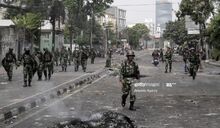
Indonesian military in the streets of West Papua. Source: Getty Images
Indonesian resistance in Sumatra, Borneo and the already occupied islands meanwhile resorted to guerilla warfare against the Allies, leading to extremely bloody jungle fighting all over Indonesia. Despite this heavy resistance, there were still calls from both allied and indonesian officials for a ceasefire, especially due to the fact that the biggest Revisionist Power in the region, China, has shifted its focus again further north on the defence of Korea, its own coastline and the Vietnamese Front. Due to the Malacca Strait being mostly under allied control, the Allies were able to use the strait to shorten their supply routes to Southeast Asia and the Indian Ocean. The Allies at the same on the occupied islands of Indonesia were not only met with resistance of indigenous insurgencies, but also various islamist terror groups and jihadist rebels, who targeted not only allied militaries, but also western civilians, who were still stranded on the islands of Indonesia after hostilities in the southern Pacific started. The fighting in Borneo and Sumatra also reached a new level of escalation, after the war became a battle of attrition following the taking of Pontianak and Pekanbaru: indonesian troops resorted to using napalm to bombard and flatten allied positions in the vast jungles of Borneo and Sumatra, causing severe damage to indonesian wildlife in the process.
The Nothern Front: Assault on Alaska
After the Aleutian campaign of 2024, revisionist troops of Russia, China and Mongolia still occupied most of the scarcely inhabited alaskan islands. Due to increased naval and aerial presence of american and canadian forces around Alaska, further amphibious assaults of the Revisionist Powers were almost impossible, with a last occupation being successful on the american Small Diomede island, as well as Saint Lawrence island. American and canadian aircraft flew striking raids against the occupying forces on a regular basis, but neither the Revisionist Powers, nor the Allies themselves saw this Arctic campaign as a priority, leading the number of allied airstrikes to gradually decline over the later half of 2025.
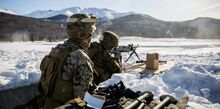
Alaskan military in snowy conditions. Source: Google
This caused massive outcries of the oppositional Democrats, who still accused president Trump of being too soft on russian aggression against US territory, which on the other hand lead to more verbal attacks of the president against the opposition, followed by several crackdowns on political opponents of Trump. Truth was that the US still lacked in capacities to drive the revisionists out of the alaskan islands, due to most of Americas military forces and equipment being stationed outside of US territory, mainly at the Eastern Front. This, in addition of the more and more obvious fact that president Trump saw Russia, an economically inferior rival, as the lesser threat of the main Revisionist Powers, and therefore didn’t see a re-tacking of the Aleutians as a priority, despite the political damage caused by the invasion. The revisionists on the other hand were also unable to move further in their attempt to close in to US mainland as much as possible, since the Allies heavily increased the pressure on Russia, China and Iran on multiple fronts at the same time, forcing the russians to choose an different strategy for distracting the Americans, while also hurting their supply of resources. That’s why Russia exploited the lack of int of the american leadership in the Arctic campaign by stationing medium range missile batteries on the Small Diomede Island, Saint Lawrence Island and Saint Matthew Island, which was occupied earlier in the same year.

American troops during an explosion in Alaska. Source: Getty Images
Russian destroyers also moved as close as possible to the alaskan shore, while submarines were not deployed, due to fears that the usage of submarine-launched missiles could be falsely indentified as a potential nuclear strike. Icebreakers were used to allow russian vessels to come closer to the nothern coastline of Alaska, and while the harsh winter conditions of the Arctic made navigation difficult in the Chukchi Sea, it also allowed revisionist forces to remain less detected by the american and canadian airforce and navy. American troops were landed on Unalaska almost simultaneously, leading to small skirmishes between US and revisionist forces. While these soldiers attempted to push the russian, chinese and mongolian forces out of Unalaska, and hopefully the rest of the Aleutians, russian forces on the Small Diomede Island and Saint Lawrence Island launched several missile salvos, while russian vessels in the Chukchi Sea initiated Kalibr-missile attacks against the alaskan coastline. Several missiles hit and damaged dozens of structures in Wales, while the attacks coming from Saint Lawrence island severely damaged the alaskan port of West Nome. The Kalibr-missiles attacks were able to hit important coal and oil fields in the north of Alaska, which interrupted the american coal supply from Alaska for several weeks into the new year. Most of these delays stemmed not from the damage itself, which was rather minor, but rather the fact that work had to be suspended due to the threat of additional attacks. Attack aircraft of both the US and Canada flew multiple sortie raids against russian forces on the occupied american islands off the coast of Alaska , while anti-ship raids in the Chukchi Sea were hindered by harsh weather conditions.
2026
Brazil joins the Allies: The War of the Amazon
At the beginning of 2026, the war of South America and the Carribean kept spreading even further. Due to the enormous political pressure Trump was facing because of the „Florida Blitz“ and the hostilities against Alaska, the Trump administration decided to increase its efforts against the Revisionist Powers south of Florida. Because of this strategic shift, the US ordered 3 aircraft carriers to the Carribean Sea, among them one who was stationed in european waters as support of allied operations against Russia, causing additional rifts between the US and the AUF command of Europe. F-15 Jets and bombers stationend in the american mainland were deployed to fly bombing raids against Cuba and occupied carribean islands, while american aircraft launched from the carriers participated in an aerial campaign in support of Puerto Rico.
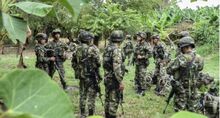
Colombian troops close to the venezuelan border. Source: Getty Images
Additional strikes were performed against the venezuelan coastline, although the fact that many planes had to be refueled in air limited the number of approaching aircraft available for the attack. The relatively competent venezuelan anti-air defence was able to inflict some casualties on the attackers with its S-300VM and Buk-M2E missiles, but since they lacked in numbers, those defences were unable to fend off the combined forces of the american and colombian airforce, which received support from the French, Dutch and British. This lead only to minimal allied casualties, especially since american UAVs were able to detect moving anti-air batteries, although the US lost a stealth fighter in the battle for Venezuelas skies, which was exploited by revisionist propaganda. Colombian forces in the west were able to penetrate venezuelan defences along the borders, leading to the first foreign troops invading Venezuela. While the fighting in Guyana remained static and geographically limited, forces of French Guyana, with incoming reinforcements coming from the french mainland, were able to push deeper into Suriname. The increased aerial campaign of the Allies caused the majority of the venezuelan airforce and navy either to be destroyed or left without supplies, leading Venezuela to lose control of almost all islands of the Small Antilles it had a presence on, while venezuelan troops in Trinidad and Tobago, as well as the ABC islands to hold on to their positions. The focus of the allied air campaign was then shifted to Cuna, in order to create opportunities for a possible invasion of the island state, while allied vessels approached the venezuelan coastline with almost no resistance of revisionist forces. Since most of the air and missile strikes conducted by the colombians and americans hit industrial as well as secondary government targets, Venezuela increasingly lacked in supplies and materials to keep up with its losses, causing new unrest among its civilian population.
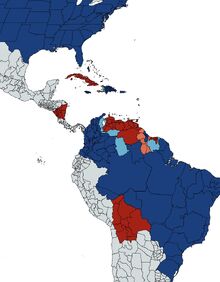
The South American theater at the beginning of 2026.
With the majority of Venezuelas airforce being neutralized, american amphibious assault troops were able to land on the venezuelan islands of Gran Roque, Blanquilla and La Orchilla, allowing its airforce to use these islands as additional launching platforms for aerial bombardment raids. American, british and french troops meanwhile supported local defences of Haiti and the Dominican Republic against the cuban invaders, leading to the first heavy casualties for the cubans during this war. While the pressure on the Revisionist Powers in the Carribean was heavily increased, the fighting around Venezuela lead to a massive influx of refugees pouring in into the neighboring Brazil, causing violent clashes between brazillian security forces and many, often unarmed, venezuelan refugees. This escalation finally convinced the brazillian leadership under Jair Bolsonaro to engage against Venezuela, leading already mobilized brazilian forces to cross into Venezuela. The objective of Brazil’s intervention was to stop the war from further escalating, while also preventing more refugees from reaching Brazil because of it. The brazilian intervention also lead Venezuelas ally Bolivia to declare war against Brazil, the US and Colombia in opposition of the allied invasion of Venezuela. Bolivian forces, among them many special forces and mercenaries crossed into the border regions of Brazil, and set many of the brazilian soy fields located close to the frontier ablaze, as a way of hurting Brazils economy, while sending a political message against the Allies. Bolivian field artillery and tanks at the same time shelled the brazilian city of Rio Branco, leading to only minimal damage. While there were reports about bolivian forces attempting to pass through the Pantanal wetlands, the venezuelan counterattacks against the brazilian invaders remained futile, due to Venezuelas mountainous south and the Amazon rainforest, which made any kind of infantry movement extremely difficult. Brazil decided to focus on the Venezuelan Campaign, using its own size and topography at the same to thwart any attempt of bolivian advance in the south. Brazilian troops were also mobilized close to the border to Suriname, but not because of any invasion plans, but rather to monitor the growing french military presence in its neighborhood, due to Brazils growing animosity towards France.
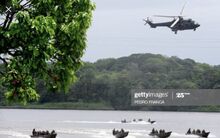
Brazilian forces crossing the Amazon river. Source: Getty Images
Brazilian field artillery started to shell targets all over the East of Bolivia, while the brazilian airforce joined its american and colombian counterparts. The continuous airstrikes in Venezuela caused a total collapse of the already fragile venezuelan power supply, leading to additional uprisings in the entire country, which were struck down with brute force by Maduros regime. American airstrikes meanwhile weakened cuban defences enough to attempt an amphibious invasion of Cuba. But due to the limited manpower the US had available, the landed marines were unable to secure as many beachheads as originally planned, leading to increadibly bloody fighting on the cuban beaches, forcing the US marines to abandon the invasion attempt. This was for many americans reminiscent of the Bay of Pigs desaster, and therefore perceived as an american embarrassment. With fighting getting more serious all over the Carribean and the Amazon, other Rio-Pact members expressed their intention of engaging as well, in order to prevent the war from further escalating. This lead Peru and Chile to issue a warning to Bolivia, that if it doesn’t stop any hostilities against Brazil, they would join the war against the Revisionist Powers. The venezuelan airforce meanwhile managed to strike multiple targets along the Magdalena River in Colombia, destroying bridges and therefore slowed down colombian supply lines and troop movement.
The Eastern Front: Allied breakthrough in Korea
In the meantime, the Revisionist Powers at the Eastern Front were facing crisis, after increased pressure of the Allies, who managed to assemble more and more resources in both manpower and material. Due to the allied breakthroughs in the southern Pacific, as well as Chinas struggle to provide enough supplies after years of fighting and blockades, the Allies were able to break the stalemate of the Korean Front in multiple sectors. While the chinese reinforced their positions north of Wonju, while the revisionists overall prepared a second line of defence stretching from Inch‘on, over Chuncheon to Gangneung, for the case that a full retreat is needed. The Allies broke through the revisionist lines encroaching Seoul in the northwest, while another push using aerial strikes, long range artillery bombardment and missiles strikes allowed the Allies to take Hwado.
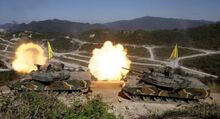
South korean tanks in action. Source: Getty Images
The increased pressure lead the regime of north korean dictator Kim Jong Un to authorize a wide scale use of chemical weapons, which were used by the north koreans along the entire front, causing massive military and civilian casualties. The ongoing carnage in Korea also continued to create massive influxes of refugees, which were trying to seek shelter both north and south of the front. In the north, north koreans who were suffering from mass starvation and disease because of the war tried to flee towards China and Russia, forcing those to expend additional forces just for the handling of those refugee waves. In the south, millions of south koreans tried to escape the massive armies fighting each other in a relatively small stretch of terrain. This refugee situation became one of the worst humanitarian desasters in human history, often referred to as the „Great Korean Exodus“. South Koreas dependence on imported goods, such as food, also caused famine across the Peninsula, with millions of south koreans starving since most of the war. The Allies were able to ship in more and more supplies, but the majority of those were relegated to the troops fighting at the front and not the civilian population. Newly founded humanitarian organizations, which were using financial and infrastructural resources of the unofficially disbanded UN, organized the supply of food for almost 1 million koreans, while using civilian cargo vessels, as well as an contingent of european airships to bring thousands of korean civilians to safety, with most of them being brought to Japan, the Phillipines, the Micro states in the Pacific, as well as Hawaii, where they were waiting to be transferred to asylum camps in California.
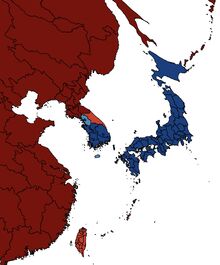
The pacific islands aside, most of the nations harboring refugees from the Eastern Front were rather reluctant to engage in humanitarian support for the civilians they hosted, with some even showing hostile behavior against the refugees. At the same time, logistics proved to be an increasingly troubling aspect for the chinese, since the additional focus on the Southeast-Asian and Indian Fronts, as well as years of blockades and shortages of fuel and other resources made it more and more difficult to provide the chinese forces in Korea with the materials they need to cope with the allied advance. Due to the combination of aerial, naval and artillery bombardement, the Allies finally accomplished a breakthrough around Wonju, forcing the revisionists to use the mountains along the eastern coastline of the Peninsula to fortify their positions, while in the west falling back the old DMZ lines of pre-war Korea. The growing dominance of allied naval assets and aircraft also allowed the Allies to land troops on chinese occupied Jeju, leading the island to fall back into allied hands after two weeks of fighting. Since Jeju was now available again as a staging ground for allied operations, the US, as well as Japan and South Korea used it to conduct missile strikes and stealth bomber raids against the chinese coastline, targeting anti-air and anti-ship batteries, while also increasingly hitting the remaining industrial targets and naval assets in the East China Sea. This growing pressure on the chinese military lead to new bursts of insurgence and rebellion inside China, which suffered massively under shortages of various goods because of the allied blockades. In the Plateau of Tibet, tibetan freedom fighters launched a new wave of insurgency against the chinese, leading to attacks being conducted against several military and police installations, which forced the chinese regime of Xi Jinping to relocate more security forces into Tibet. While new protests also broke out in annexed Hong Kong, with brutal and violent reactions of the chinese military as a result, chinese forces in revisionist Nepal faced a new guerilla campaign against themselves, conducted by allied recruited Ghurka rebels, which were supported by the UK, India and financially Singapore and Brunei.
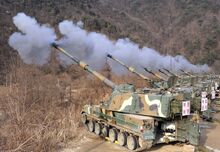
South korean howitzers firing. Source: Getty Images
The chinese communist party reacted by striking down all revolts against itself with immense brutality, leading to the deaths of hundreds of chinese civilians, which on the other hand caused more uproars and rebellion in other parts of chinese influence. Taiwanese civilians, supported by the remnants of the taiwanese army started new acts of resistance against the occupying chinese, leading to urban clashes and new massacres against the civilian population. As a result, Xi Jinping ordered the public execution of many former members of the taiwanese leadership, which was meant as a mean to scare the resistance into submission, although it only strengthend the resolve of the taiwanese to fight against the occupation force. The Allies encouraged these shows of resistance in Taiwan, Hong Kong, Tibet and even Xinjang, where they support Uyghur rebels to revolt against the chinese, who were already incarcerating thousands of them in concentration camps, where they were tortured, forced to do hard labor, and malnutritioned, while many more were executed for alleged terroristic activities. Allied propaganda also spread reports about Uyghurs being used for human organ farming, meaning that many of them were killed to gain organ transplants for both the chinese military and civilians. The validity of these claims is hard to prove, but there is to this day hard evidence suggesting the truth of these inhuman actions. First pockets of resistance also formed among the north koreans, who were suffering famine and disease even prior to the war. With almost all of its military being focused on the south, the north korean regime of Kim Jong Un lacked in enough available forces to put a quick end to the riots, which were mostly forming in the few urbanized areas of North Korea.
The Western Front: The Revisionists in Retreat
The Revisionist Powers weren’t facing crisis in 2026 just at the Eastern Front, but also in the west, where the revisionist forces of Russia, Belarus, Serbia and their few reinforcements from China and the central asian republics were confronted by a reorganized and nummerical superior enemy. The new allied european structure of the AUF continued to enable the Allies to coordinate their offensives more effectively and on a larger scale along the entire Western Front, which heavily increased the pressure on Russia, which was still overwhelmed by the allied approach due to overstretched forces, failing logistics and material shortages. Especially the so called crossection between the polish and ukrainian sectors of the front were increasingly difficult for the revisionist to hold, with belorussian territory getting directly hit by allied attacks for the first time since the war broke out.
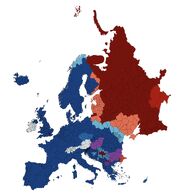
The Western Front later in 2026
The continuous waves of combined longe range artillery bombardment, mass airstrikes and incoming tank fires forced the revisionists to retreat along the southwestern border of Belarus, creating a wider opening between the polish and ukrainian fronts. Russia decided that its main focus should be Ukraine, the nothern part of the polish Front and southern Finland, in order to avoid russian territory to be threatened by allied air, missile and artillery attacks. This need to disperse its attention lead Russia to lack in enough forces and material to effectively fight back against the Allies in Scandinavia. While russian forces engaged in fierce battles with finish, swedish, norwegian, danish, british and canadian troops along the finish border in Lappland, russian forces in Norway finally retreated back to the russian border, leading the russian Nothern fleet to increase its naval bombardment of the allied coastline, to prevent its base on the Kola Peninsula to get threatened. With such a large Front being attacked simultaneously, Belarus was left to fight along its border against allied troops with a far smaller portion of the resources available for its russian ally, leading the remaining recruits of the central asian republics to be sent almost entirely to the now threatenend belorussian line. This new situation caused uprisings inside Belarus against dictator Lukashenko and his support for the revisionist war effort. Allied troops of Romania, Slovakia, Spain, Italy, Portugal, France and Germany to push deeper into Ukraine, while being supported by ukrainian militia and remnants of the moldovian forces. With these ground gains being in process, the allied leadership of Europe negotiated with other nations at war with Russia for additional support at the Western Front, leading to talks with Australia, New Zealand and Japan about sending troops to Europe. Meanwhile, the belorussian troops of Lukashenko remained under intense pressure from the Allies, forcing the Revisionists to create new lines of fortifications along the southwestern and western border of Belarus, leading them to dig new network of trenches, tank dugouts and anti-tank ditches, in order to prevent the Allies from invading Belarus.
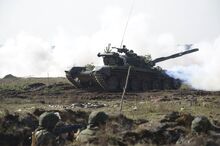
Belorussian and russian servicemen during tank fire in Belarus. Source:Getty Images
The Revisionist Powers also redeployed several S-300 anti-air batteries to the belorussian sector, to cope with the increasing number of allied air incursions into revisionist airspace. The Allies, despite their initial successes also faced troubles of various kinds, since their offensive often moved faster than they could consolidate their gains sufficiently enough, leading them to slow down their approach more than originally planned. There was also discontent among the allied leadership in Europe, because several allied nations, like the UK, Italy and the Visegrad states still had issues with being integrated into a more unified european military. The british feared to not having enough influence in this conglomerate of european forces, leading to skepticism of the value of such a project. Pro Brexit politicians argued that the Alliance of the United Forces would take sovereignty again from the UK, and would open the door for future exploitation of other european powers, leading to calls for a limitation of commitment to the AUF. Italy felt that it was left out of several decision making processes which was, along with its still present sympathy for the Revisionist Powers, the reason why Italies commitment for the allied war effort remained comparatively lackluster. While the already more reluctant Visegrad nations feared of being even more dominated by the western european powers, the US as the biggest non-european ally voiced a strong rejection of the independent european operations. American leading figures in Europe felt often blindsided by their european counterparts, while president Trump called this development even treasonous, while threatening to pull out all american troops out of Europe.
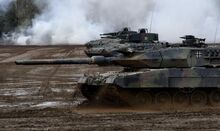
German tanks rolling through the mud in Europe. Source: Getty Images
Only due to the resistance of not only oppositional Democrats, but also many republican and military leaders, as well as a european diplomatic mission, Trump was convinced to not retreat from the Western Front, but relations kept on souring going forward. Despite this diplomatic disunity, and the still immense strain on the allied supply and logistic lines, the Allies were able to exploit their technological and numerical advantage to secure their gains to such a degree, that Russia was forced to retreat on many fronts simultaneously, like eastern Finnland, southern Poland and central Ukraine. Especially Germany, with the highest population in the EU, managed to mobilize enough forces to have a significant presence in Poland and Ukraine, while german reinforcements were also sent to the Balkans. Since the majority of these drafted forces were younger germans in their 20s and early 30s, many experienced a new kind of patriotism which was based on the joined achievements of the european Allies and Germanies accomplishments during the later stages of the war, enabling the re-militarization of Germany even more. In the Balkans, Serbia faced pressure from all fronts. Albanian, bosnian, montenegrin, croatian, italian and greek troops were able to overrun Republica Sprska in Bosnia, forcing the serbians to retreat back into their territory after the Second Battle of Sarajevo.
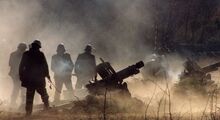
Serbian guns firing against croatian targets. Source: Getty Images
Serbia also faced an total invasion of its territory, forcing it to dig in in central Serbia, in order to protect Belgrade, leading to increadibly brutal fighting with heavy casualties on all sides. Allied airstrikes and artillery bombardment was now able to reach every corner of Serbia, leading to a steady decline of serbian airpower, anti-air capabilities and supply routes. With the revisionists being in retreat at all european theaters of the war, allied troops in Greece began militarizing the islands close to Turkey, due to increasing turkish provocations. Greece received minor support from the british, germans and french, while Italy, Spain, Portugal and France helped to increase the allied naval presence in the eastern Mediterranean close to Cyprus, as well as the western Aegan Sea, in the case of potential turkish aggression. While greek and bulgarian forces are still clashing with tens of thousands of refugees coming from the turkish border, more and more reports came up about shots being fired at greek security forces from the turkish side of the border. The number of military servicemen among the turkish forces at the border appeared to increase over weeks, while greek media outlets claimed that turkish military crossed the border at multiple points of the Evros river, occupying several of the river islands in the process. Turkish warplanes also conducted more provocative maneuvers, like flying close to densely populated greek islands, although the turkish administration under dictator Erdogan denied any allegations from the west. At the same time, Australia, New Zealand and Japan agreed to send small contingencies to Europe, in order to increase the pressure on Russia.
Stalemate in Africa
While the Revisionist Powers faced crisis at multiple fronts at the same time, the african campaigns of both sides remained in a deadlock. The largest progress achieved was the allied victory in Western Africa, where the revisionist allies of Burkina Faso, Guinea, Ghana and Benin, which surrendered to the allied Sahel and west Africa coalition. Other african theaters of the war saw less significant movement in the meantime, causing both the non-african Allies and Revisionist Powers to doubt the value of the african campaigns, especially now that both China and Russia had to focus more on the Eastern and Western Fronts respectively. The Angolan Front saw heavy fighting between south african and namibian troops against angolan and congolese forces, with the frontline remaining static around Lobito, Huambo and the western parts of the Kwando and Cuíto rivers.
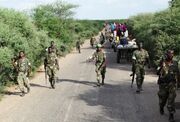
Troops from Mozambique on a highway with refugees. Source: Face of Malawi
Neither the angolans, nor the south africans managed to break the following stalemate, which lead the south african administration to focus more on the zimbabwean and mozambique fronts. South African troops in Botswana advanced to the Okavango Delta, leaving only a stretch of bostwanan land from Maun to Francistown unoccupied. The revisionist resistance of Bostwana used the Chobe and Makgadikgadi National Parks for cover, which caused severe damage to protected wildlife there as soon as the south africans launched their next wave of offensives. The campaign against Zimbabwe itself, despite intial success, also faced only slow progress, which stemmed from the zimbabwean deployment of troops to Mozambique. Allied and revisionist troops clashed in Gweru and the border town of Mutare, while south african airstrikes were conducted against positions around Harare. The Mozambique Front proved to be more successful for the Allies, due to the combined effort of south african, tanzanian and western forces against troops of Mozambique, Zimbabwe and localized pockets of islamist insurgents. Despite the zimbabwean troops being able to divert the attention of the Allies, while slowing down their advance, Mozambique was pushed to the brink of collapse due to the lack of sufficient revisionist supplies from non-african countries. Russia, which struggled with the allied offensive in the west, questioned the need of letting its paramilitary forces engage in Mozambique, leading the Kreml to call off the operations of the Wagner-Group in the east african country. In secret talks, russian and south african diplomats agreed on letting russian paramilitaries to escape and seek shelter in South Africa, leaving it unaware that the Wagner-Group was responsible for the attacks on south african troops in Mozambique earlier during the war. Further north, at the Equatorial Front, allied troops of South Sudan, Kenya, Ethiopia, Uganda, Ruanda, Burundi, Tanzania and western forces managed to cross the Great Lakes of the eastern congolese border in order to push deeper into the revisionist country.
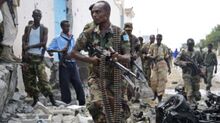
Somalian military in the rubble of a bombed city. Source: Getty Images
In the northeast of the D.R.C., allied troops were able to advance towards Isiro, since the Albert Lake covered far less territory than the Lake Tangannyika further south. The congolese city fell after a week of fighting, allowing the Allies to push deeper towards Kisangani, while conquering Gemena in the west. The C.A.R. was able to hold off the allied offensive coming from the East and north, due to the support from Sudan and russian forces, both military and paramilitary. The offensive against Sudan remained static, leading to heavy fighting and severe casualties, especially among the civilian population, which suffered under countless war crimes committed by the sudanese and partially even allied army. The increasing outbreaks of Ebola, as well as rising numbers of SARS-Cov 2 and HIV infections additionally slowed down both the allied and revisionist approach in equatorial Africa, therefore forcing both sides to halt their operations multiple times in a row. At the Horn of Africa, things also remained in a draw for both sides, due to allied successes in Somalia and a new revisionist offensive against Djibouti. War torn Somalia faced defeat by the hands of the Allies, due to the combined effort of kenyan, ethiopian, tanzanian, american, french and british forces, supported by the forces of Somaliland, leaving only a few pockets of resistance against the Allies. The largest pocket of Resistance was the somalian capital of Mogadishu, where somalian forces, actively supported by turkish soldiers of the TURKSOM base, engaged in heavy urban warfare against the Allies, while smaller somalian strongholds around Jamaame and Baidoa fell under the pressure of allied ground and air forces, the latter heavily using drones to conduct precision airstrikes against the resistance. Further north, the revisionists in Eritrea launched a last offensive to take out the allied positions in the Gulf of Aden, leading troops of Eritrea and Sudan to start an attack against allied controlled Djibouti.
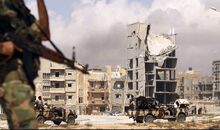
Libyan forces in a destroyed city. Source: Getty Images
Allied troops of the US, France, Japan, Spain, Germany and Italy fought off the offensive which became known as the Second Battle of Djibouti at the border of the small african state, but suffered heavy casualties and were forced to remain in the defensive, due to additional missile and primitive drone strikes being conducted across the strait by the iranian backed Houthi rebels in Yemen. At the same time in North Africa, the war between Algeria and allied Morocco saw little progress as well. Algeria was unable to push deeper into Morocco due to the ongoing fighting in Libya, the attacks coming from the Sahel states and Tunisia, as well as the moroccan Atlas mountains. Morocco on the other hand, despite spanish, french, portugese, british and to a lesser degree italian and german support, was unable as well to penetrate algerian defences, since it was more engaged in anti-insurgency warfare against the Polisario Front Movement in Western Saharah, causing severe civilian casualties due to aggressive moroccan actions aimed against Polisario. Since the attention of almost all waring nations was spread over multiple fronts simultaneously, while the foreign powers also struggled at other fronts all over the globe, the battlefield of Libya was caught in a deadlock just like the other theaters of war in Africa. The revisionist positions around Tripoli remained fortified and hard for the Allies to dislodge, due to the algerian and turkish forces stationed there in support of the government. The Tripoli coalition of the Revisionist Powers was able to endure allied attacks, because of the influx of heavy armory coming from Turkey, which was able to reach Libya due to Italies lackluster commitment to the naval blockade of Libya, since Italy sympathized with the anti-Haftar coalition in Tripoli. The allied Haftar coalition proved to be more successful in the south, where allied troops from the Sahel, alongside sympathizing tribal warriors, managed to make smaller gains. On sea, incidents of close collisions between french, egytian, british, and greek vessels with their turkish counterparts became more frequently, leading to calls inside the allied command of finally treating Turkey as an official enemy of the Allies.
Pakistan pushes the button: The War gets nuclear
Another Revisionist Power which faced crisis in 2026 was Pakistan, which continued to be overwhelmed by indian and to a lesser degree american and british forces. Indian troops advanced into Pakistan on almost all fronts, with the exception of the nothern sector of Islamabad and Kashmir, where Pakistan received additional support from chinese forces. Further south, the indians were able to successfully advance further northwards, following the amphibious invasion of Pakistans coastline and the offensive along the Indus Delta. In order to divert the attention of the defenders, India decided to transform the Islamabad offensive into a terror campaign and a deliberate war of attrition, using salvos of long range missile attacks and daily intensive airraids to drive the pakistani forces in the center of the country apart.
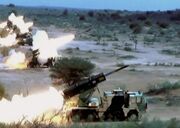
Indian missile launchers aimed against Pakistan. Source: Getty Images
As planned, the pakistani defenders, supported by forced recruits from the central asian republics, were forced to split up, in oder to counter both the pressure around Islamabad and Kashmir in the north, as well as the advancing Indian invaders in the South. This allowed the invading allied forces in the Punjab region to push deeper into central Pakistan, leading pakistani forces to be cut off from any supply routes East of the Indus river. Due to the lack of enough manpower to counter the attacking Indians on all fronts simultaneously, while also being deprived of any significant form of air support, Pakistan was pushed on the brink of collapse. Despite heavy resistance of Pakistan’s military leadership, the pakistani government ordered its forces to focus on Islamabad, forcing the defenders to retreat west of the Indus, leading the Allies to occupy most of Pakistan eastwards of the river, except the Bahawalpur-Sukkur-Hyderabad axis. The military command of Pakistan grew weary of Islamabads defensive tactics, and due to the increasing losses of territory, as well as reports about indian atrocities committed against pakistani muslim civilians, Pakistans generals decided to disobey the government and take military decisions themselves. Since Pakistan ceded nuclear assets and a certain degree of launch code authority to lower-level officers, those officers decided that nuclear weapons are the last chance to secure Pakistans survival.
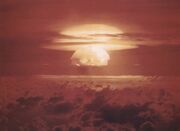
Detonation of a nuclear weapon. Source: Getty Images
They believed that a couple of low-yield weapons delivered to critical points of Indias infrastructure will be sufficient enough to stop the indian advance and forcing the invaders to halt their operations in order to avoid further nuclear escalation. That’s why the pakistani military command, as the first nation of WW3, as well as the first nation in history since WW2 launched a nuclear strike against India. Four missiles, among them 2 Shaheen II and 2 Ghauri II missiles, accompanied by hundreds of decoys to counter indian missile defences, where fired, with 3 of them being able to reach their destination. The news about the nuclear strike shocked the world, and lead to several localized ceasefires on all fronts of the Eurasian Continent, in order for the world powers to assess the new escalation and its potential consequences for the war on a global scale. The indian targets hit were Ludhiana, Jallandhar and Surat, leading to the immediate deaths of 165,000 people in total, while tens of thousands more perished in the weeks and months after due to agonizing radiation sickness. Despite their low yield, the pakistani nuclear strikes destroyed up to 69-70% of the cities that were hit, causing a collapse of local healthcare, infrastructure, sanitation, water supply and transport. The nuclear blasts also lead to massive firestorms, leading to a total estimate of 26 million indian casualties as a direct and/or indirect consequence of the strikes. Leaders worldwide condemned these attacks, and called for restraint of both sides. India on the other hand couldn’t let this nuclear assault be unanswered, and had a nuclear deterrence doctrine that enabled it to operate Second-Strike capabilities, which was the reason why one day after the attack, India launched a retaliatory strike against Pakistan. India wanted to use its nuclear weapons as a symbol of its resolve, while also permanently disrupting Pakistans military command. India also wanted to prevent further escalation which would lead to total nuclear destruction, and the potential atomic involvement of China or the US , that’s why India didn’t target symbolic sites or densely populated civilian areas.
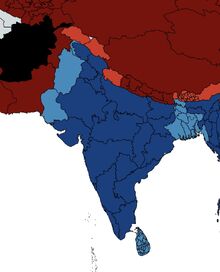
The Indian Front after the nuclear strikes of 2026.
The main target of the retaliatory nuclear strikes was the Bahawalpur-Sukkur-Hyderabad axis, as well as Dera Ismail Khan, Dera Ghazi Khan, Kohat , Bannu and Rawalpindi. For the same reasons as in India, Pakistan still suffered enormous casualties from these low yield strikes, leading to 18 million deaths to be associated with this nuclear exchange. Thousands of pakistani civilians fled the battlefield by attempting to cross into Iran, Afghanistan or China, while the latter took harsh measures to prevent any refugees from entering its territory. Pakistani civilians also took to overcrowded boats, attempting to reach the Arabian Peninsula, leading thousands of them to drown in the Arabian Sea. The nuclear fallout of both the indian and pakistani strikes also affected the neighboring countries of both nations, leading to radioactive contamination of parts of Afghanistan, Iran, southwestern China and in parts even central asian countries like Uzbekistan, Tajikistan and Kyrgyzstan. The indian strikes were followed by a declaration of China, which stated that in the case of further nuclear attacks on Pakistan, nuclear strikes from the chinese would follow in retaliation, while Xi Jinpings associates signaled to Pakistan, that if it should resort to new nuclear attacks of its own, China would stop any support of Pakistan and won‘t retaliate against India, should Pakistan be the first to attack again. The US on the other hand threatened China with nuclear strikes, should it resort to nuclear weapons use against India, which lead both India and Pakistan from dismissing any plans of further nuclear warfare, in order to prevent a global nuclear catastrophe. The disarray of Pakistans leadership and military command also lead to new insurgencies of baloch secessionists in Pakistans south and southwest, which were supported by indian and american intelligence.
The War of South America: A continent united against Maduro
The Indian Front wasn’t the only theater of the war that saw significant escalation over the course of 2026. The conflict in South America flowing the entrance of Brazil as part of the american and colombian war effort, as well as the involvement of venezuelan ally Bolivia, kept spreading later the same year. The joined invasion of Venezuela by colombian, brazilian and american land forces in the south and west of the country managed to advance further into the mountainous territory of Venezuelas part of the Amazon Rainforest, while american aircraft continued to decimate venezuelan air defences and important parts of Venezuelas infrastructure, such as the power grid, which caused chaos, confusion and increasing casualties among the civilian population of Venezuela. Anti-Maduro rebels joined the invading forces in an attempt to topple the regime, which lead to escalating violence of the Maduro regime against its own population. The missile strikes against Caraças and the venezuelan coastline were also supported by french, british and dutch troops deployed in the Carribean after the occupation of european island territories.
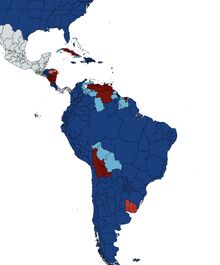
The South American theater of the war after the invocation of the Rio-Pact
At the same time, brazilian, french and guyanese troops managed to push venezuelan forces out of Guyana, after their invasion earlier the same year. These allied forces also achieved a series of victories against the revisionist Suriname, which included a further invasion and occupation of venezuelas ally by french and brazilian forces, leading to several tense situations between them due to Frances and Brazils mutual animosity towards each other. Brazilian troops also launched a counter-invasion of Bolivia, after the bolivian assaults on brazilian territory following Brazils entry into the war. The growing violence and the spread of the war in South America finally convinced the Rio-Pact, which was heavily influenced by the US, to invoke its Article 8, which promised that an attack on one of its members is an attack on all of them, leading to the entrance of many more south-american nations into the war. As a result, Argentina, Chile, Paraguay, Ecuador and Peru announced that they will send forces to aid the allied campaign against Venezuela. While Panama and Costa Rica declared their logistical support, the only Rio-Pact members who refrained from joining the war against Venezuela were obviously Revisionist Power Cuba and on the other hand Uruguay, which rejoined the treaty as „recently“ as 2020. Uruguay condemned invoking the Rio-Pact as a pretext for war against Venezuela, since it saw this move as an illegal operation of the US against South America. Uruguay, which voiced support for the Maduro regime multiple times before WW3, therefore declared that it will once again leave the Rio-Pact, while adding that it will resist any foreign involvement in South America. At the same time, ecuadorian, peruvian, chilean, argentinian and parguayan forces were sent to the Venezuelan Front in the hope to bring an end to the conflict as soon as possible.
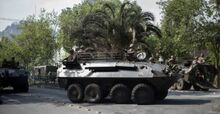
Deployed chilean military. Source: Getty Images
The ecuadorians and peruvians took position along the colombians and americans in the west, while the chileans, argentinians and paraguayans supported the brazilians in the south of Venezuela, despite tensions among the individual south-american states. Chilean modernized F-16s also participated in the allied campaign against Bolivia, leading to waves of airstrikes in support of the advancing brazilians. While the brazillians crossed the Rio Itenez River, and managed to occupy most of the bolivian Beni region, brazllian, paraguayan and argentinian forces invaded Santa Cruz , forcing the bolivians to take positions west of the Rio Grande. The deployment and movement of troops in South America caused unease and nervousness among the uruguayan government, leading it to mobilize its army with focus on its nothern border with Brazil. Revisionist ally of Cuba and Venezuela, Nicaragua, finally decided to take the offensive and launched a surprise attack against neighboring Honduras, in order to take out US bases and infrastructure. During the following battles, nicaraguan forces assaulted and besieged the Mocorón and Barra de Caratasca bases in Honduras, leading Honduras to officially join the Allies. The hostilities of Nicaragua also lead Costa Rica, which had no military of its own, to side with the Allies as well, allowing US troops to land in Costa Rica in order to protect the central american state. At the same time, allied troops finally managed to land troops in Cuba, due to the joined effort of the american airforce and naval assets.
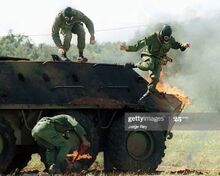
Cuban soldiers in a burning vehicle. Source: Getty Images
American troops reached land in the west of Cuba, while america, dominican and haitian forces, supported by british, french and dutch special troops landed in the southeast. Despite heavy resistance from the cuban defences, allied troops were able to advance further into cuban territory, while suffering massive casualties. The lack of modern equipment and armory among the cuban army lead allied troops to retake Guantanamo and Santiago de Cuba in the southeast, while ameircan troops in the west managed to take Pinãr del Rio. Despite support from nicaraguan and russian volunteers, the cubans had to resort to guerilla and urban warfare, in order to slow down the allied advance towards Havanna. The cuban airforce and anti-air- defences suffered heavy casualties from aerial allied bombardment, but Cuba’s land based rocket launchers remained largely intact, leading to steep allied losses among the invading forces. With Cuba facing crisis, and the continental Revisionist Powers being on the brink of collapse, allied forces finally managed to neutralize all iranian and most of the russian forces operating in the Carribean.
Allied Victory in the Indo-Pacific
While China and North Korea faced increasing pressure, and Cambodia and Laos being on the brink of collapse, the Revisionist Power of Indonesia was confronted with total defeat. The allied advance of indian, thai, malaysian, australian and british troops on Sumatra continued to push forward, despite brutal jungle guerilla warfare, and Indonesias usage of destructive weaponry like Napalm bombs. While suffering heavy casualties, and being slowed down for several days and weeks on multiple occasions, the Allies managed to take Palembang, leading to urban warfare and anti-allied insurgencies. Allied forces were therefore bogged down in urban warfare, but were still able to conquer most of Sumatra.
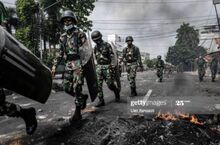
Indonesian military in devastated streets. Source: Getty Images
In the northeast, malaysian and thai troops, supported by forces from Singapore and Brunei advanced further south into Kalimantan and several miles south of the equator. Simultaneously, allied troops debarking from Timor, Australia, and the Cocos and Christmas islands landed on Java, with additional manpower coming from airborne support. Indonesian submarines tried desperately to delay allied naval movement, while Indonesias surface fleet, which was mainly stationed in the Java Sea, suffered severe casualties from allied submarines, missiles and aircraft. More and more indonesian diplomats called for an Armistice, especially now that many other Revisionist Powers were in crisis all over the world, with some even demanding that Indonesia should return to become an ally of the West. Civil unrest broke out in multiple centers of power in Indionesia, forcing the army and police forces to additionally focus on striking down riots. Due to too many fronts to focus on, indonesian troops in Sumatra either retreated to Java or surrendered to allied forces. While Sulawesi remained an indonesian stronghold, most of the naval assets surrounding the island were neutralized by allied aircraft and submarines. The sea mines that were layed out in the strait leading into the Java Sea were also largely neutralized due to the increased effort of allied anti-mine helicopters and minesweepers. This allowed the Allies to further establish naval dominance, although the indonesian surface fleet engaged in a last effort to inflict as much damage on the allied forces as possible, which was remembered as the Battle of the Java Sea. Despite this confrontation, the Allies managed to maximize their total blockade of Indonesia, leading to increased material and food shortages on Java and Sulawesi. Other, smaller indonesian islands harboring revisionist troops were simply left on their own and cut off from supplies, in order to prevent being bogged down in unnecessary skirmishes.
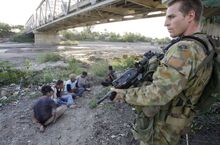
Australian soldier overseeing captured agitators in Timor. Source: Getty Images
Larger cities on Borneo, which were still unoccupied by allied forces were besieged by malaysian, singaporean, thai and brunei forces, due to the high population density of said cities, which would make a full conquest rather difficult and costly. The same strategy was conducted by australian, american, new zealandish and indian troops in Java, while being supported by volunteers from oceanian forces and papuan fighters, which lead to the siege of several larger indonesian cities, like Serang, Surabaya and Yogyakarta. The allied advance towards Jakarta, as well as allied air campaigns against the indonesian capital lead to new calls for a truce, and ultimately an Armistice with the Allies. After the fall of Semarang and Bandung, the indonesian leadership finally decided halt its operations and offered a ceasefire. The Allies agreed, and after days of negotiations, both the Allies and Indonesia announced a truce, and after another week the Armistice of Jakarta. The main conditions of the Allies were the free passage for allied vessels through indonesian shipping routes, the secession of West Timor and West Papua, as well as indonesian participation against the chinese war effort in the north. In exchange, the Allies offered to retreat from Borneo and the smaller indonesian islands, while helping to restore Indonesias food supply. Despite heavy criticism and resistance of Indonesias military command, the political leadership agreed on these terms, and therefore officially announced joining the Allies, by declaring war against China.
The Western Front: The Fall of Serbia
Indonesia wasn’t the only Front which proved to be a success for the Allies. At the Western Front, the allied advance against Serbia gained more and more traction, with allied forces invading the Balkan state from all directions. Serbian forces were dug in in heavily defended positions around Belgrade, while another defensive circle was held from Valijevo to Smederevo, as well as Šabac over Zemun to Pančevo. The fighting between allied and serbian forces was butal, with some days reaching a death-toll of over 10 thousand casualties on both sides. Serbias rather robust anti-air defences still managed to inflict severe damage to the allied airforce, which kept bombing Belgrade and other serbian strongholds on the entire Balkan Front.
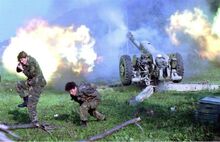
Bosnian guns firing against serbian positions. Source: Getty Images
Serbia declared that it would never surrender, but realized, that at this rate, the serbian army couldn’t hope of holding the lines indefinitely, especially since the Allies deployed some of their new weapons systems, which were developed during joint european programs against Russia over the last few years. Among those were the newly improved tanks of franco-german design, several german artillery systems, as well as improved fighter and bombing aircraft, which were developed, among others, with the support of the US. Allied artillery kept pounding revisionist strongholds, while Serbias most vital infrastructure was in ruins, which slowed down serbian supply efforts. Due to the allied advance in Ukraine, the russian Black Sea Fleet was forced to retreat back to the waters around Crimea, leaving Serbia with no additional missile support as a consequence. Allied airships were also tested for the first time as potential bombing aircraft, and despite heavy casualties inflicted on the serbian defenders, the Allies stopped this testing due to the lack of accuracy and the vast destruction caused by the heavy payloads, which also hit larger quantities of civilians. The Allies still kept high pressure on Serbia, and made simultaneously diplomatic efforts to get Austria as another european nation to join the Alliance of the United Forces, which was met with skepticism by the austrian government, which preferred to stay neutral as long as possible. At the same time, allied troops in the now occupied Republika Sprka faced sabotage and violent assaults coming from ethnic Serbs fighting the allied advance inside Serbia. Allied patrols became the targets of snipers, mine warfare, and even car-bombs and urban insurgency.
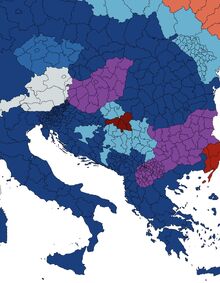
The Balkan Front shortly before the fall of Serbia.
Even outside of Bosnia and Serbia, ethnic serbs kept sympathizing with the serbian war effort, leading to riots and attacks being conducted in nations like Croatia, Albania and Kosovo. Almost simultaneously, islamist terror attacks, which were already reinflamed in the Balkans since Serbia entered the war and reportedly committed several atrocities against muslims in its occupied territories, became more frequent inside Serbia. Those attacks put additional pressure on Serbia, and diverted some of its attention inwards, but still remained mostly symbolic in nature, despite heavy civilian death tolls and infrastructural damage. Food shortages also became an increasingly dire problem for the defending serbians, due to being completely cut off from foreign supplies, leading to some calls for stopping the war before Serbia would totally collapse. Those calls were furiously rejected though, since the serbian military and political establishment viewd defeat at the hands of the Allies, especially through its Balkan enemies as an intolerable humiliation. Because of that, allied offers for a ceasefire were rejected, leading the Allies to intensify their bombing campaign against Sebia. The reason for that was, that the allied military command wanted to defeat Serbia as quickly as possible, in order to free up more forces to use at the polish sector of the Western Front. The Balkan NATO members of Bulgaria and North Macedonia were still reluctant to seek a more active approach to the allied war effort, due to large parts of the political establishment of these nations still being rather pro-russian. But since the pressure to join the AUF grew with every day, as well as ethnic tensions inside North Macedonia and Bulgaria caused by serbian riots and attacks, both nations saw themselves to participate more on the Allies behalf, leading to increased logistical support and more granted access for the Allies by both Bulgaria and North Macedonia.
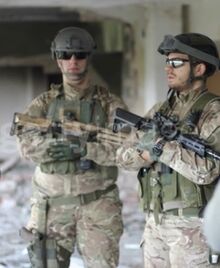
Serbian soldiers in the rubble of a destroyed building. Source: Getty Images
Bulgaria also fully mobilized its army for the first time during the war, not only because of the escalation in Serbia, but also the growing tensions with former NATO member Turkey, which kept actively sending refugees towards the greek and bulgarian borders as human weapons to put pressure on allied nations. Meanwhile, Serbia was almost completely overrun by the Allies, leaving only Belgrade and its immediate surrounding regions unoccupied. Allied missiles, artillery shells and rockets kept hitting the serbian capital and the defensive lines in the region on a daily basis, leading to more and more breakthroughs by allied forces. Despite heavy resistance and immense casualties inflicted on the Allies, allied troops finally managed to reach the outskirts of Belgrade with massive air support. The Battle of Belgrade that followed after was one of the bloodiest of the entire war, with thousands of allied troops and even tens of thousands of serbian forces falling in just a couple of days. After almost two weeks of fighting, Belgrade fell into the hands of the Allies, leaving Serbia defeated, despite remaining resistance and continued urban insurgency.
The Southern Front: Allied Advance against Iran
Another Revisionist Power struggled to hold off the allied advance: Iran. The Islamic republic entrenched itself along its entire western border, with the exception of its frontier with Turkey, while also creating heavily fortified defences along its southern coastline in preparation of allied amphibious assaults. After years of brutal fighting, most of iranian ally Iraq fell into the hands of the Allies, leaving only pockets of resistance by Shia militias, islamists and few iraqi military operatives in urban areas, like Baghdad, which fell after a month of bloody fighting.
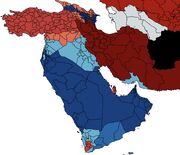
The „Southern Front“ later in 2026
While arabian forces of the GCC, supported by american, french, british and egyptian troops shelled the iranian border region, allied airforces increased their strikes against military, economic and infrastructural targets inside Iran, with israeli aircraft putting additional focus on iranian nuclear facilities. Despite official claims prior and during the war, Iran ramped up its nuclear program, and actively sought to militarize it more aggressively since the beginning of WW3. Iran suffered heavy blows against its nuclear program, due to relentless israeli air, missile and cyber strikes targeted against facilities like Natanz, Isfahan and Arak. While Irans only uranium mine in Bandar Abbas was also hit early on, the mullah regime used the early advances of the Revisionist Powers to relocate its nuclear weapons program to compounds deep inside the iranian mountains, making those new facilities hard to dislodge. The hasty relocation, and the limited material, technology and infrastructure available made those institutions often rather improvised and less efficient. This was the reason why, despite Iran using the maximum capacity of its remaining centrifuges, its nuclear program only progressed very slowly, leading it to still be in its infancy in 2026. Due to the already limited technology and resources, Iran sought to develop uranium instead of plutonium based weapons, despite those being less destructive and needing more fissile matter to function. The process of minimizing any potential device also proved to be an immense struggle for Iran, which is why it sought support by the north koreans. China and Russia looked the other way when it came to iranian nuclear ambitions, since they were rather critical of such a development, but ultimately stayed directly and indirectly complacent to it. North Korea and even Russia also provided uranium for Iran, which was transported through the central asian republics, and therefore exclusively through revisionist territory.
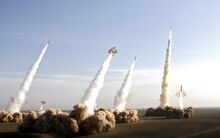
Mass launch of Shabab-3 missiles in Iran. Source: Getty Images
Iran originally planned to develop nuclear warheads for its Shahab-3 missile, but due to the struggle of minimizing any potential warheads so that they could fit into the missile, as well as the impending allied invasion, Iran explored other delivery systems as well. That’s why there were programs aimed at developing uranium bombs, while there was another one testing the possibility of nuclear gun shells. Iranian scientists were pressed to assemble a somewhat functional device for future testing, while at the same time, the pressure on the iranian border was intensified. Allied aircraft was able to reach increasingly deeper into iranian territory, while on the ground, the fighting between allied coalition forces and iranian troops backed by Shia-militias and other proxies became extremely brutal. Poison gas was used by both sides, causing horrendous wounds and casualties among both the military and civilian population of the immediate area. Iranian border forces, supported by the Revolutionary Guard and the al-Quds troops, layed out miles of barbed wire and land mines, while pounding enemy forces in Iraq and Kuwait with pre-positioned mortars and artillery pieces. Meanwhile, the systematic internment and liquidation of Shias in Saudi Arabia and saudi occupied territory, as well as Sunnis in Iran continued, with both sides publicly executing shia and sunni prisoners respectively, as an ideological attack against the enemy. Both sides also run detention camps for POWS and members of their respective conflicting group of islamic belief, leading Saudi Arabia to have prison and execution camps in the Arabian Desert, while Iran still run its detention camps it built in the Zagros mountains since the beginning of the war. Meanwhile, the Allies successfully landed troops on the iranian coastline of the Strait of Hormuz, leading to heavy fighting in Bandar Abbas and Minab, while Bandar Lengeh became the first iranian city to fall into allied hands.
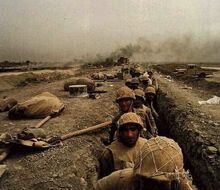
Troops along the iraqi-iranian border. Source: Pinterest
The allied invasion of Iran also caused a rift inside the iranian society. While the invasion inflamed the already very present anti-allied sentiment among the iranian people, with tens-of thousands of them now taking to arms, thousands more went to the streets to riot against the mullah regime. Those riots were struck down with brute force by the Revolutionary Guard, which killed almost a thousand of protesters in just a day of upheaval. Iranians loyal to the regime also started to attack rioters, whom they deemed as traitors, culminating in civil war like hostilities in several regions of Iran. These clashes were encouraged by allied intelligence, which was the reason why multiple westerners were captured and publicly executed as well, allegedly for being allied spies. At the same time, allied forces supported by the yemeni puppet government advanced further against the iranian backed Houthis, leading the rebels to loose significant amounts of territory, while Sanaa faced a long, protracted siege, with horrific consequences for the civilian population. Tensions also grew in the north of the wider region, where turkish troops occupying syrian and iraqi territories were engaged in several standoffs with allied arabian and western forces. Both sides accused each other of opening fire, after kurdish civilians tried to escape into allied held territory, which turkish troops tried to prevent by shooting at the fugitives. The resulting counterfire of arabian, but also american, british and french forces lead to a couple of casualties on both sides, which caused increased hostile rhetoric between the former NATO allies.
The Eastern Front: China falls back
While the Allies advanced against Iran in the Middle East, and Serbia and Indonesia falling into allied hands, China continued to struggle following allied breakthroughs on the Korean Peninsula. Chinese forces outside of Korea faced increasingly severe shortages of various supplies and ammunition, leading to lacking support for Chinas remaining asian allies. After years of intense fighting and economic collapse, the Revisionist Power of Cambodia was defeated by thai, malaysia, burmese and vietnamese forces, while Laos also kept losing territory to the Allies. The joined offensives of Vietnam and Thailand managed to overwhelm the last defences of Laos around Lak Sao and Paksan, leading all of southeastern Laos to be occupied by the Allies.
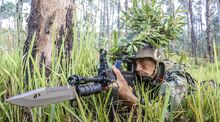
Chinese soldier luring in position. Source: Getty Images
The remainder of the lao forces,as well as their chinese counterparts then focused on holding the Allies off from overrunning more lao territory, with the objective of defending the new residence of the lao leadership, Luang Prabang. The Revisionist Powers were able to use the Mekong and Ngiap rivers, as well as the Nam Ngum Reservoir as natural defences to slow down the allied advance, while chinese troops in Vietnam had to retreat to a line stretching from Dien Bien Phu to Lang Son. Further west, chinese troops lost a critical battle for Lahio in Myanmar, due to material shortages and the dispersed attention of the chinese leadership, which caused a lack of strategy and guidance on several less important fronts, like the Burmese one. The defeat in Lahio by the hands of burmese, indian, american and australian troops forced the chinese to retreat from the southwest of Myanmar, back to the chinese border, while vietnamese and american troops were able to push back the chinese from several regions in nothern Vietnam. Following these allied offensives, vietnamese troops were able to reconquer the cities of Ha Long, Dien Bien Phu and Haiphong, while allied air and missile bombardment of Hainan further increased. But due to Chinas still massive manpower, and the overstretching of american forces, this allied advance soon came to a halt again. Meanwhile, chinese forces, after the indian successes in Sikkim, managed to stop the indian advance in the Himalayas, while being able to hold on Bhutan and defending Nepal.
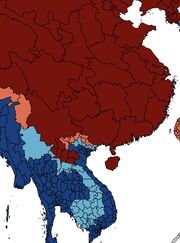
The Southeast-Asia sector of the Eastern Front in 2026
At the same time, the naval war became a struggle for China as well. After almost a year of intense fighting, the Allies managed to create an opening, and ultimately split, between the chinese naval forces around the Paracel and Spratly Islands in the South China Sea, leading the latter to be occupied by forces of the US, Malaysia, Vietnam, Australia and the first waves of allied indonesian troops. This loss was seen as a humiliation of China, which was the reason why reporting about the war in China became even more censored than was already the case. News about chinese retreat and defeats still broke through, and encouraged civil unrest and insurgency in China. Mass demonstrations and riots in Hong Komg continued, while new uprisings were reported in Macau as well. Tibetan freedom fighters and Uighur rebels in Xinjang meanwhile intensified their attacks on chinese security forces, which tied down a lot of chinese attention and resources. The violent crackdown of the chinese communist party as a consequence of this caused the death of thousands of chinese civilians, while tens of thousands more were arrested and sent to labor camps in order to produce for the chinese regime. Uighur rebels were increasingly deported to new „re-education camps“, where most of them were directly executed for treason and thrown into mass graves.The actions taken against the rebels also lead to the mass incarceration and murder of Uighur civilians, who fell under general suspicion. As was the case already for most of the war, Uighur prisoners in chinese concentration camps were forced to hard labor, like working on weapons and equipment for the war, while also producing everyday items for the chinese population like clothing and face masks. The execution of prisoners became more frequent though, and was used as a tool of intimidation against the muslim population of Xinjang, which is the reason why modern historians see these events as the Uighur genocide. In order to prevent more setbacks, the chinese regime of Xi Jinping decided to take additional defensive measures.

Chinese infantry troops under fire. Source: Business Insider
Chinese forces started to dig in along the sino-vietnamese border and layed out countless landmines, while the anti-air and anti-ship defences on the Paracel Islands were intensified. China also deployed new forces to Taiwan, in order to strike down taiwanese rebels, while using Taiwan as a defensive base against approaching allied vessels and aircraft. The chinese occupants of Taiwan even repurposed captured BAE systems, as well as M142 High Mobility Artillery Rocket launchers, which were able to hit targets up to 190 miles. These additional defences were also intended to relieve pressure from the chinese navy in the South China Sea, while the chinese additionally launched dozens of DF-26 missiles against allied targets in Korea, Japan, Guam, as well as the Phillipines for the first time during the war. The strikes against fillipino bases and harbors was reason enough for the regime of Rodrigo Duterte to seek more aggressive action against the chinese, despite the fact, that the Phillipines partially colluded with China in the past to avoid such broader confrontation. These attacks thinned out the chinese missile arsenal m which forced the chinese to halt long range missile attacks for a significant amount of time.
The "Battle of Antarctica"
While both the Allies and Revisionist Powers remained locked in a deadly fight against each other, the war saw several obscurities as well, most notably the so called „Battle of Antarctica“. Before the war started, several satellite systems were installed by the chinese on australian antarctic territory, which were used in WW3 to guide strike weapons, like cruise missiles and ballistic missiles. Since the Allies heavily disrupted revisionist GPS satellite systems during the latter half of the war, both China and Russia tried to compensate for that by using their own systems, like the chinese BeiDou and the russian GLONASS.

British patrol vessel close South Georgia. Source: MOD
This was the reason why the Revisionist Powers in 2026 saw much more importance in protecting their stations in Antarctica, while chinese and russian submarines were occasionally sent to assault and sink fishing ships in antarctic waters, in order to reduce allied food supplies. Due to the revisionist presence in Antarctica, allied leaders from several nations around the globe issued that there needed to be an allied response to revisionist aggression around the South Pole. The australian Antarctic division, the british Royal Navy, the argentinian, chilean, french and new zealandish navies sent a small naval presence to the waters of Antarctica, where they mostly conducted patrol duties, while hunting for russian and chinese submarines. After the revisionist setbacks of 2026, the submarines operating in the Antarctic increasingly targeted and attacked not only fishing ships but also military vessels, leading to a couple of small naval clashes between allied navies and their revisionist attackers. Due to these hostilities, the british HMS Forth patrol boat, deployed from the Falklands Islands, was among the first allied vessels to be sunk by revisionist submarines. The southern activities of the UK also caused a series of provocative maneuvers between the argentinian and british navy in the antarctic waters, due to both nations history of shared animosity in the wake of the Falklands war, therefore heightening the tensions between those allied nations. In 2026, the revisionist naval Assets operating in the Antarctic faced severe shortages of supplies and ammunition, since they were mostly cut off from their main supply routes further north.
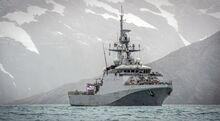
The HMS Forth in antarctic waters. Source: Forces.net
Those vessels, which were sent to and deployed from southpacific islands, like Fiji and Vanuatu in the years prior, ran out of torpedos and Food, leading to a rather abrupt end of naval hostilities in the Antarctic. The Allies also managed to sink a revisionist submarine, which caused an ecological crisis in the South Polar Sea because of radiation escaping the reactors of the sunken wreckage. As soon as the attacks on allied military and economic shipping stopped, british and french ships launched missile strikes against the russian and chinese satellite stations on Antarctica, leading to a massive blow against the BeiDou and GLONASS systems, while granting the Allies additional advantages in the field of satellite communication. After these attacks, there were no more military activity in and around Antarctica, except some minor patrol missions by allied countries.
Mexico joins the War
While the war kept escalating in South America, and the Allies managed to advance in Europe and Asia, things were looking tense in North America. Mexico suffered massively under allied blockades against Revisionist Powers in WW3, due to the fact that especially China was Mexicos second largest trading partner. Additionally, many allied nations were unable to sufficiently trade with Mexico, due to shipping and air traffic lines being disrupted by the war, like Japan, South Korea and Malyasia. The result was a severe economic crisis of Mexico for most of the war, including widespread unemployment, increasing poverty and even food shortages. The result were protests all over the country, while drug cartel related crime was also on the rise.
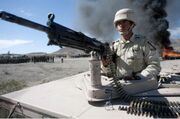
Mexican soldiers during clashes with drug traffickers. Source: AP
These conditions also facillitated sporadic outbreaks of COVID-19, which put an additional strain on Mexico’s health system. This caused a new wave of refugees moving to the north, in order to reach the US in the hope for better living conditions. The news of these migrant caravans were received with rejection from the Trump administration, which declared that this would be another „invasio-attempt“ of America, that was according to Trump far worse than the russian invasion of the Aleutians. As a reaction to the incoming refugee wave, Trump deployed 5000 troops to the american-mexican border, in order to prevent any refugees from coming to the US. The US government also authorized the use of deadly weaponry, in the case of hostilities with mexican refugees and human traffickers, which caused massive outcries among the anti-Trump opposition. Multiple clashes were reported between mexican migrants and US border forces, which were accompanied by civilian vigilantes, that went out to „fight against hostile invaders“. There were several incidents of refugees being shot by americans, either by the military or by american self-authorized border militias. The oppositional Democrats accused Trump of authorizing and encouraging lethal violence against refugees, while the president claimed that the border forces and „american patriots“ merely acted in self-defence. Trump himself accused Mexico of actively seeking to send refugees into the US, as some form of alleged warfare against America. He claimed that Mexico would deliberately send criminals, thugs and rapists to the US, in order to weaken America during this time of war.
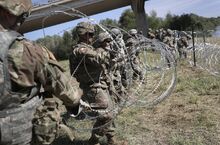
US troops at the american-mexican border. Source: Getty Images
Both the oppositional Democrats, as well as the mexican leadership denounced these accusations as made up, racist and harmful for the already strained american-mexican relationship. Trump went even further, and threatened economic sanctions against Mexico, should it refuse to do anything to stop the refugees itself. As a result of these threats from the US, Mexico decided to send troops to the american borde, as a show of force and strength, while also hoping to discourage refugees from coming north. This troop deployment was seen as an act of aggression by the Trump administration, which authorized opening fire on mexican troops, should they come too close to the border. Mexican forces on the other hand kept closing in to the border, especially during nighttime, in order to tackle human trafficking, while many mexican soldiers, who were infuriated and insulted by US accusations, engaged in various standoffs with the US army, during which many mexicans started throwing rocks at american troops, leading them to fire warning shots. Those warning shots were interpreted as acts of aggression, since tensions between the engaging forces were high due to the earlier reported shootings of mexican refugees, which lead the mexican troops to open fire directly on the americans in return. Both sides accused each other of starting hostilities, while Trump called these incidents a „declaration of war“ by Mexico, which was why he introduced massive economic sanctions on Mexico, despite resistance from the opposition. Mexico, which already faced economic struggles and civil unrest, saw itself wronged by the US, and unfairly punished by the american leadership, which lead to widespread anti-american protests and riots in front of american embassies. Shootings along the border between american and mexcian forces continued to occur, while many protesters went to the still incomplete border wall in order to protest.
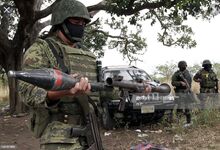
Mexican soldier with a confiscated rocket propelled grenade launcher. Source: Getty Images
They insulted the opposing border forces of the US, and tried to vandalize the wall, while it became much harder for the border forces to distinguish between refugees and demonstrators. Once again there were shots fired, either as warnings or in alleged self defense, which lead to the killings of several dozens of mexican civilians, a couple of mexican soldiers and even several US border guards who were facing fire from the mexican side. As a result, US troops along the border entered mexican territory in a few areas of lesser fortifications and engaged with mexican civilians and military forces in several clashes with tear gas, flash grenades and even armored vehicles, in order to disperse the revolt along the border. This was seen as an foreign invasion of Mexico, which lead the mexican government to declare war on the US. Trump vowed to „anhililate“ Mexico for its aggression against the US, and ordered his border troops to shoot at any mexican soldier on sight, while all over Mexico, anti-american protesters waved revisionist flags, like the russian, chinese and even venezuelan ones. Mexican and Latino-protests also emerged in the US itself, which were struck down aggressively by the deployed security forces. Trump also ordered the police, homeland security and other federal forces to patrol in latino majority communities, in order to prevent „fraternisation and collaboration with the enemy“ which prompted accusations of racism and a general suspicion of latino-americans. Along the border, mexican forces engaged in various clashes with US troops, during which Mexico started to deploy more heavy weaponry, like the SDN Humvee self-propelled artillery piece, as well as several towed howitzers and mortars, which were positioned on high ground, like the hills close to San Diego and Tijuana, as well as Jacumba Hot Springs and along the Rio Grande. As a result, shelling erupted, which caused only symbolic damage to private properties and border walls and fences in Texas and California. The mexicans were able to conduct these attacks due to the lack of present ground and airforces in the continental US.
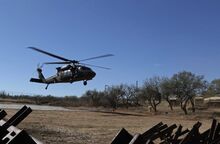
American Blackhawk helicopter close to the mexican border in Arizona. Source: MilitaryTimes
Most american troops were stationed outside of the US, including most of Americas hard military equipment. Which was why there were only comparatively few Abrahams tanks and F-16 fighter jets available to attack mexican positions along the border. Most US forces had to rely on helicopters and armored infantry fighting vehicles to counter mexican aggression, which were assaulted by mexican forces using confiscated anti-tank weapons. The mexicans on the other hand managed to tear down parts of Trumps border wall, which was celebrated by mexican and revisionist propaganda. Mexican forces also managed to conduct several incursions into the US at places with little or no border protection, where they engaged in exchanges of fire with american border troops and civilian militias, leading to mounting casualties among the latter. While american forces resorted to using shoulder launched missiles and truck-, and helicopter mounted miniguns to disperse the assaulting enemy, mexican special forces were able to ambush an american detention center for migrants close to the border, where they liberated dozens of children in US custody. This was exploited by revisionist propaganda as the liberation of innocent children from american „concentration camps“, despite being only a one time occurance. Despite the lack of equipment and manpower, the US forces were still able to push the mexicans back at several points of the border, while the few present american fighter jets stroke mexican positions and infrastructure all over the front. Reports came up about the abduction of US civilians by invading mexican forces, while there were allegedly massacres against US citizens in remote, rural areas along the border, and although most of these claims remained unconfirmed, they were enough to spark anti-mexican and anti-latino violence by Trump-followers all over the US.
Turkey joins the Revisionists: Erdogan vs Europe
Mexico wasn‘t the only nation joining the Revisionist Powers in late 2026 due to ongoing conflicts with western countries. Tensions in the Eastern Mediterranean kept escalating, after the forced influx of tens of thousands of refugees coming from Turkey to Greece and Bulgaria, while turkish and greek security forces clashed with each other through the greco-turkish border. Due to the continuously rising tensions with the west following its exclusion from NATO, Turkey intensified its naval presence in the waters around Cyprus and several greek islands, in order to secure turkish maritime claims and natural resources. As a result, greek, french and british warships engaged in various standoffs with turkish vessels, while the turkish airforce conducted mock attacks on allied ships. After coming increasingly close to each other, turkish and western soldiers harassed each other, by using water hoses and shots in the air to disperse the vessels of the opposing side.
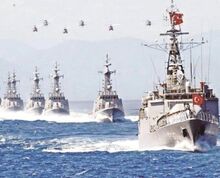
Turkish naval vessels close to Cyprus. Sqource: GreekCityTimes
During these standoffs, several greek ships close to Cyprus and Crete were rammed by turkish vessels, prompting exchanges of fire. Almost immediately after, turkish naval units actively attacked greek and french ships, leading to hundreds of allied casualties. The turkish airforce was also deployed, and buzzed several allied planes, while pursuing the greek navy, leading to near-clashes between each sides airforce as well. Turkish dictator Erdogan blamed the recent escalation on Greece and the Allies, and vowed to defend turkish interests with all means necessary. The Allies on the other hand condemned the turkish aggression, and made an ultimatum, which called for a complete retreat of turkish naval forces from officially greek and cypriot waters. Turkey rejected the ultimatum, and declared that it will never give in to allied demands, which it called „fascist and imperialist“ intentions. As a result of the escalation, Greece mobilized a large portion of its troops and sent them close to the border, as a show of force. The europeans AUF also intended to increase greek defences in the south, which was why the allied european command deployed several anti-air batteries, anti-ship missiles and artillery pieces to Greece, which were supposed to be deployed on greek islands off the coast of Turkey. When the news broke about allied weaponry arriving in Greece, Turkey saw itself forced to take preemptive action, which lead to turkish troops entering greek territory in several locations of the Evros river, where they occupied river islands and small chunks of greek territory.
